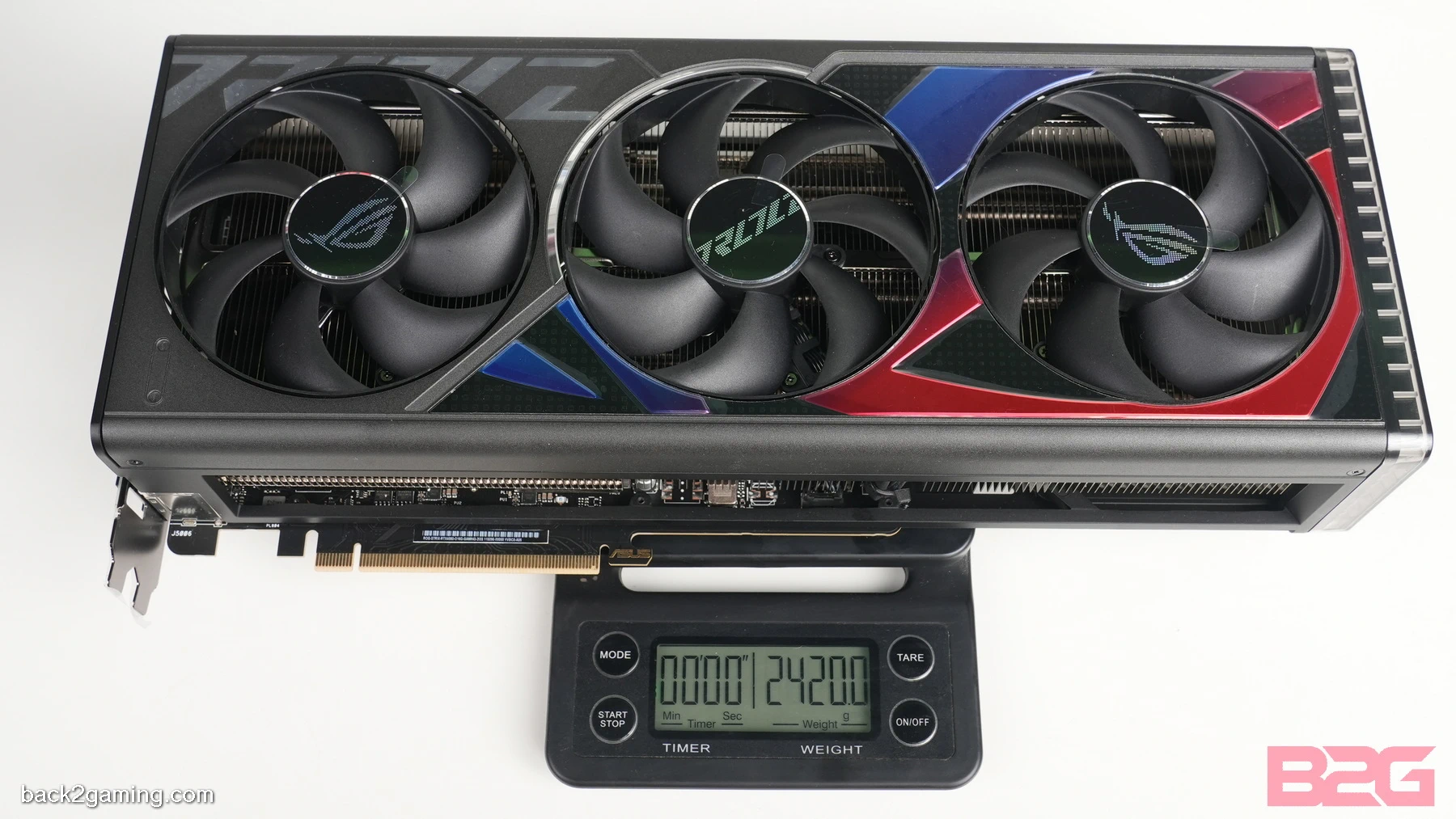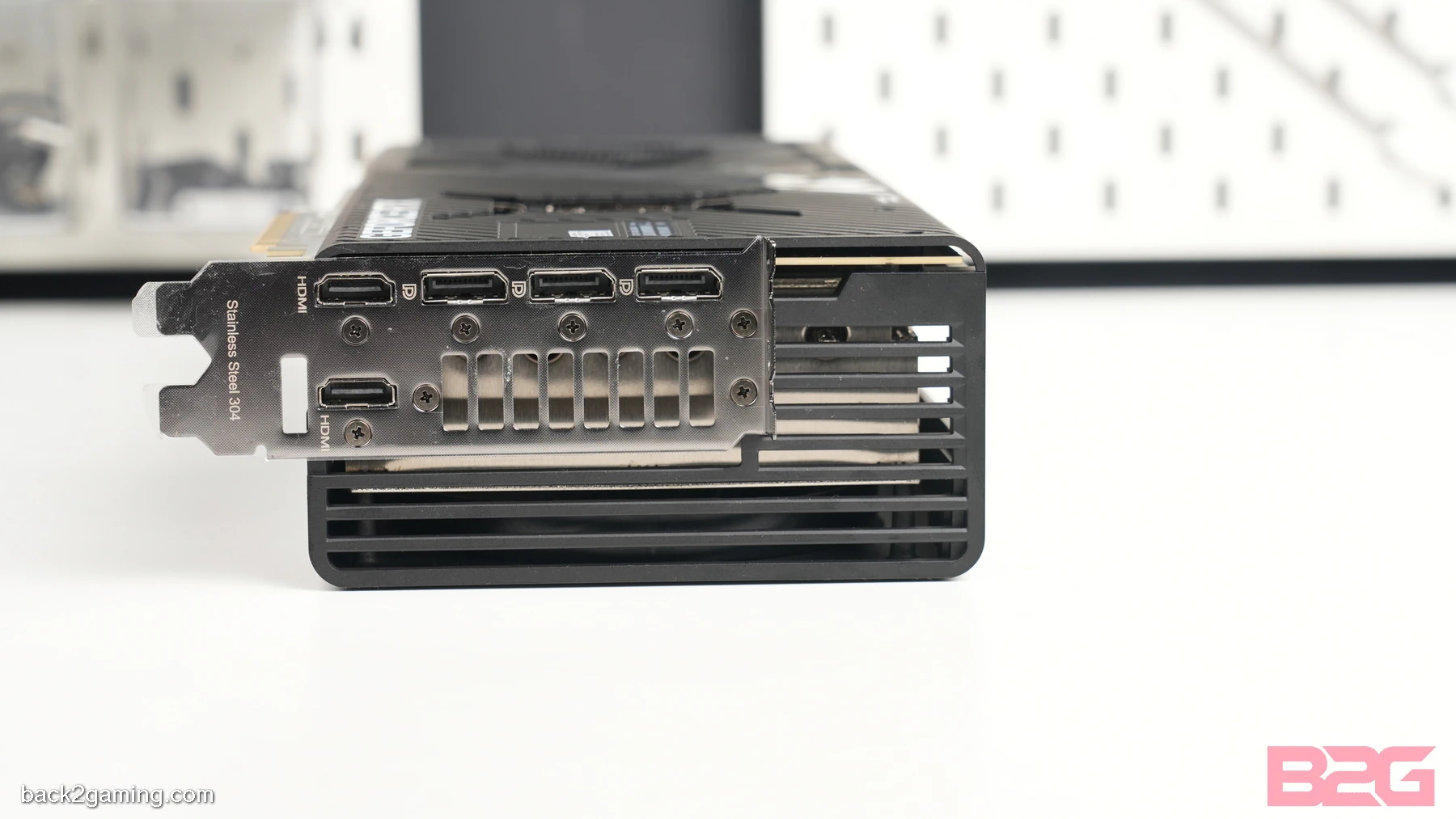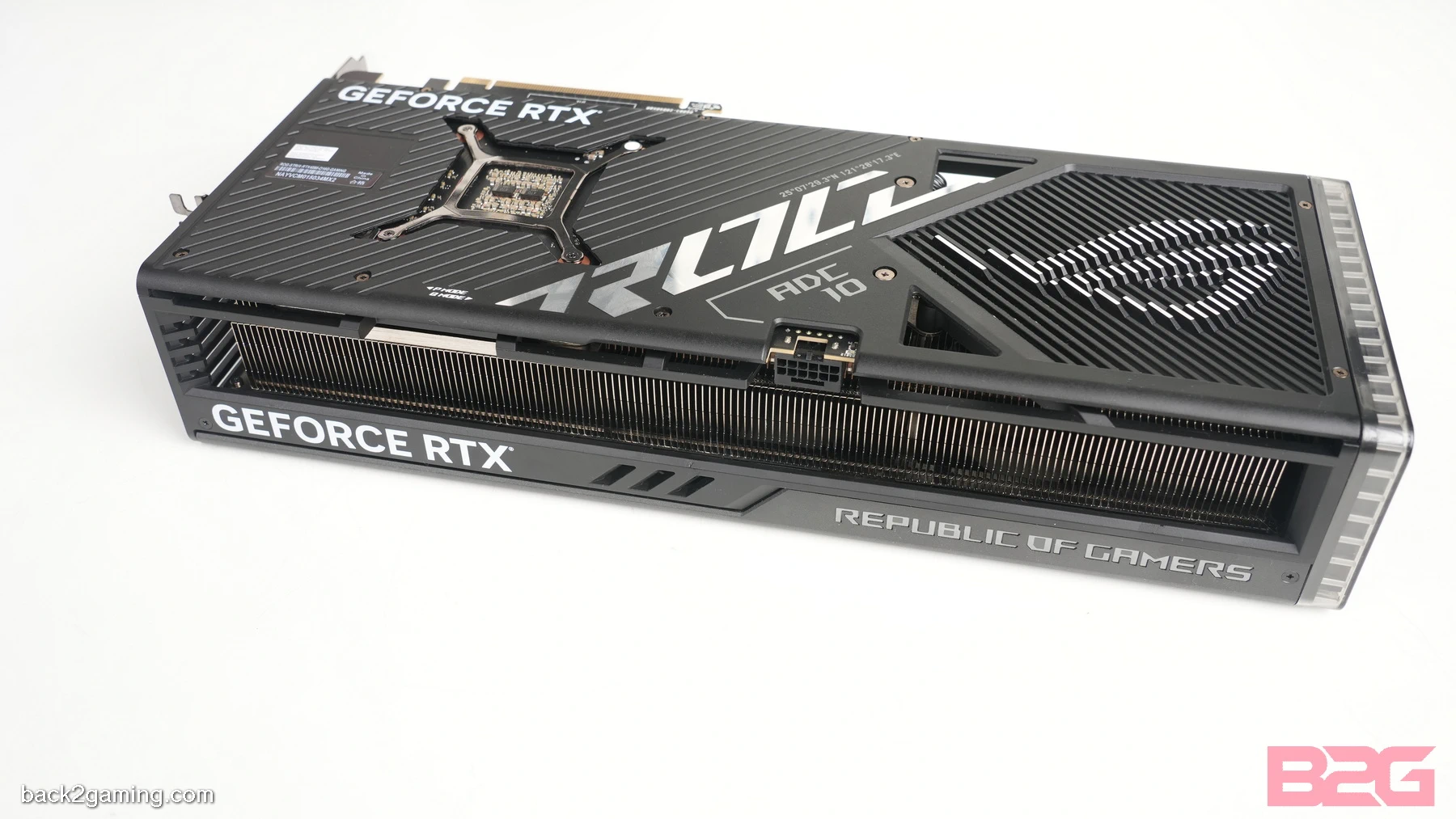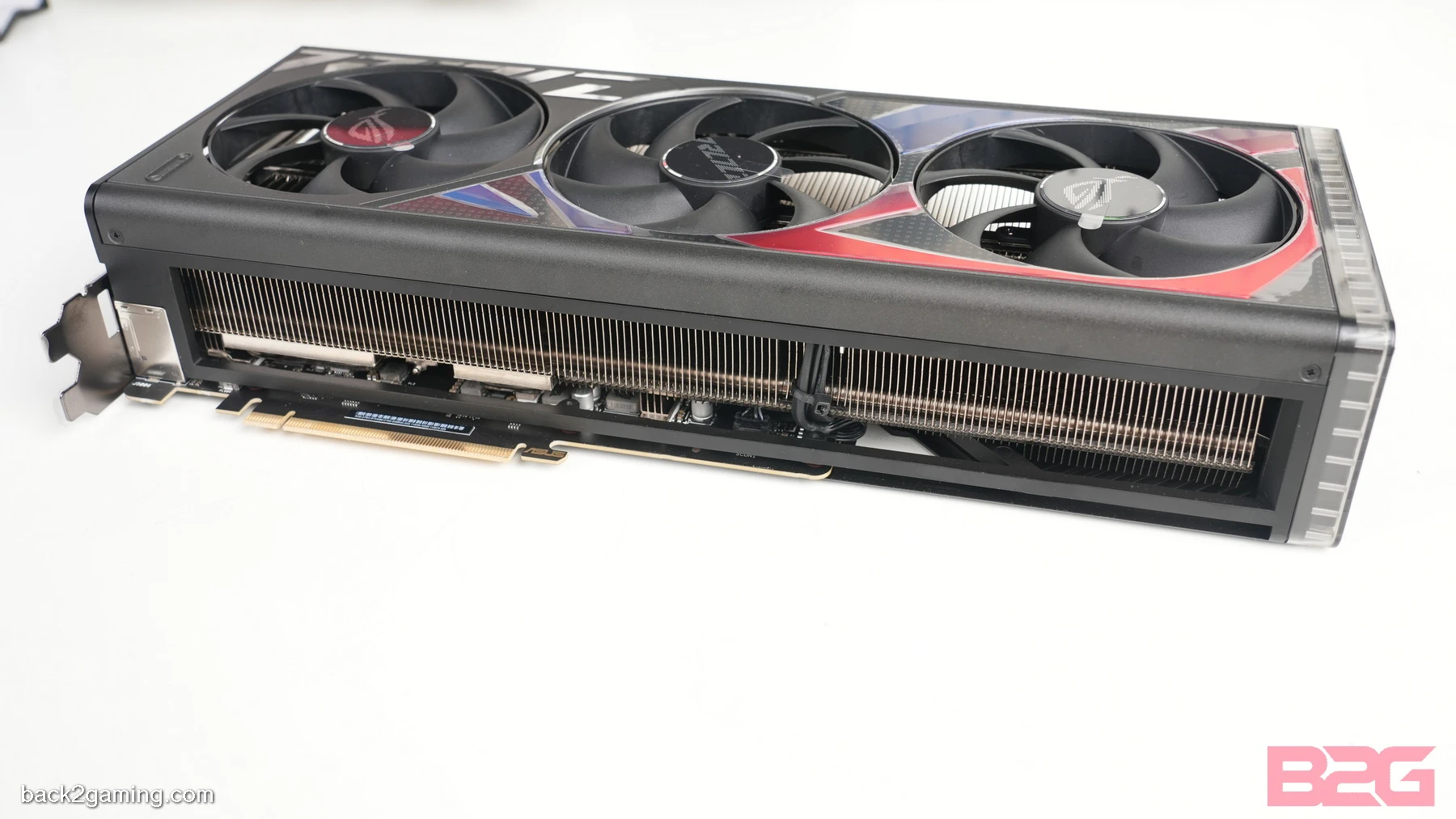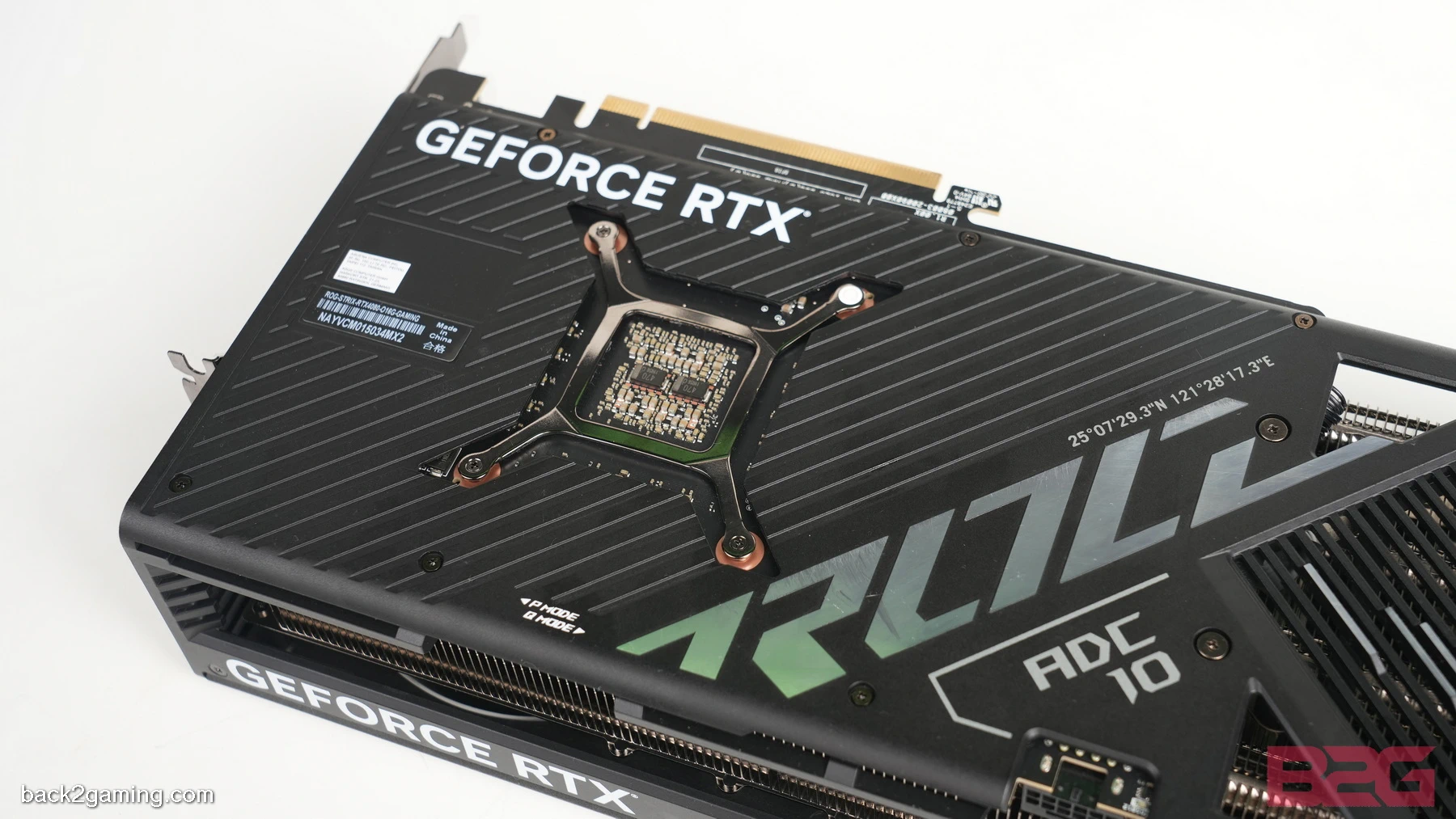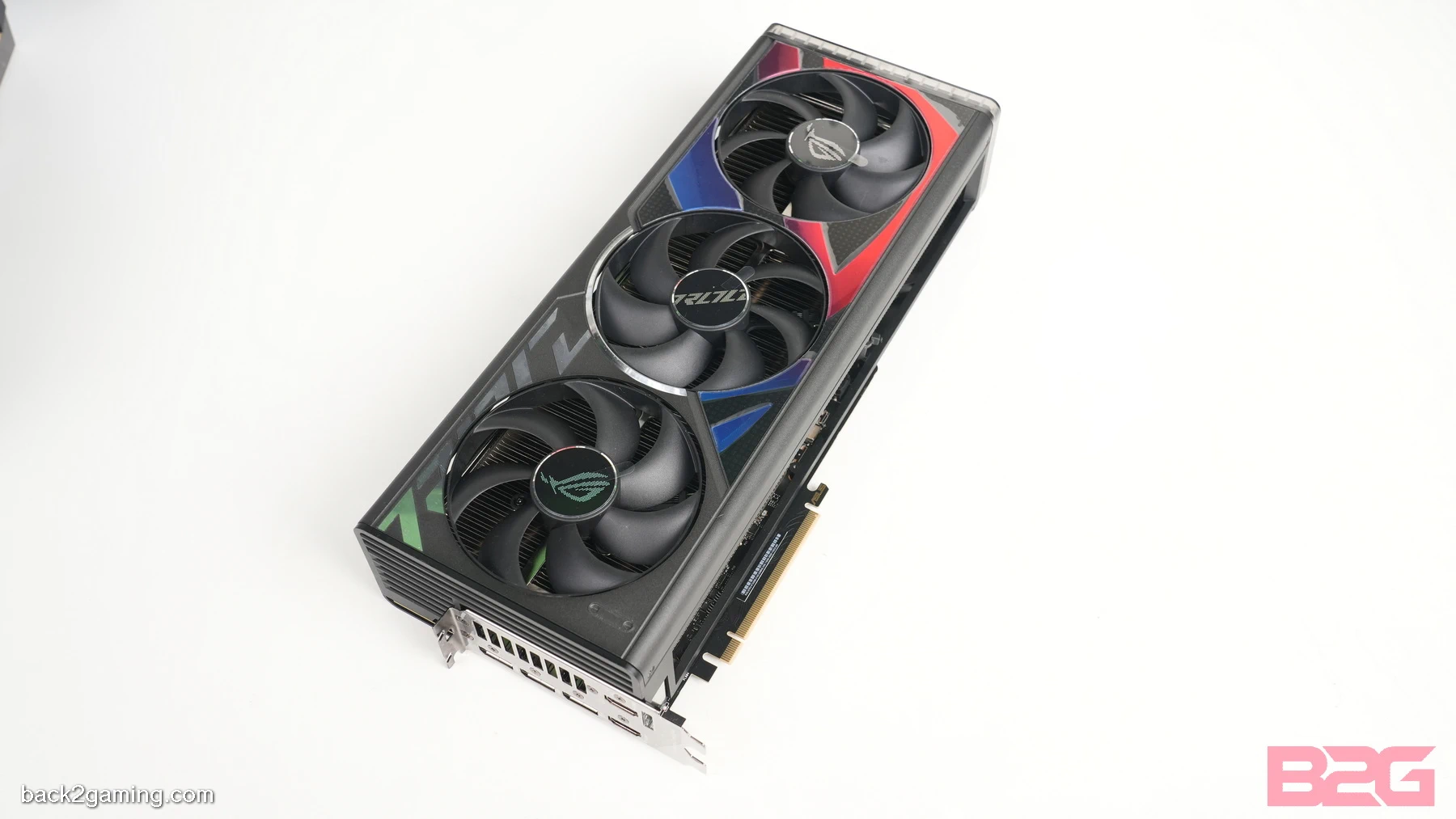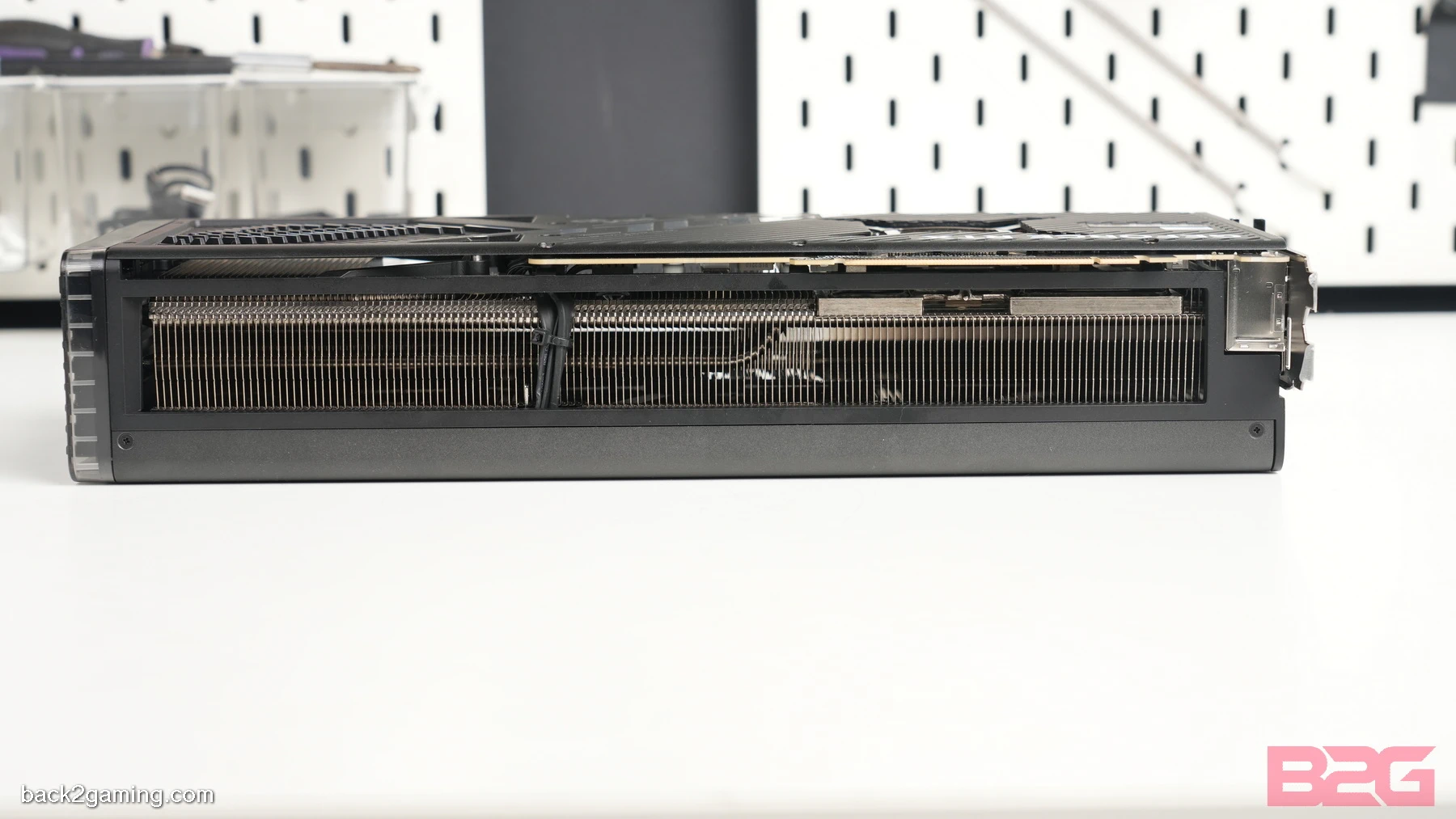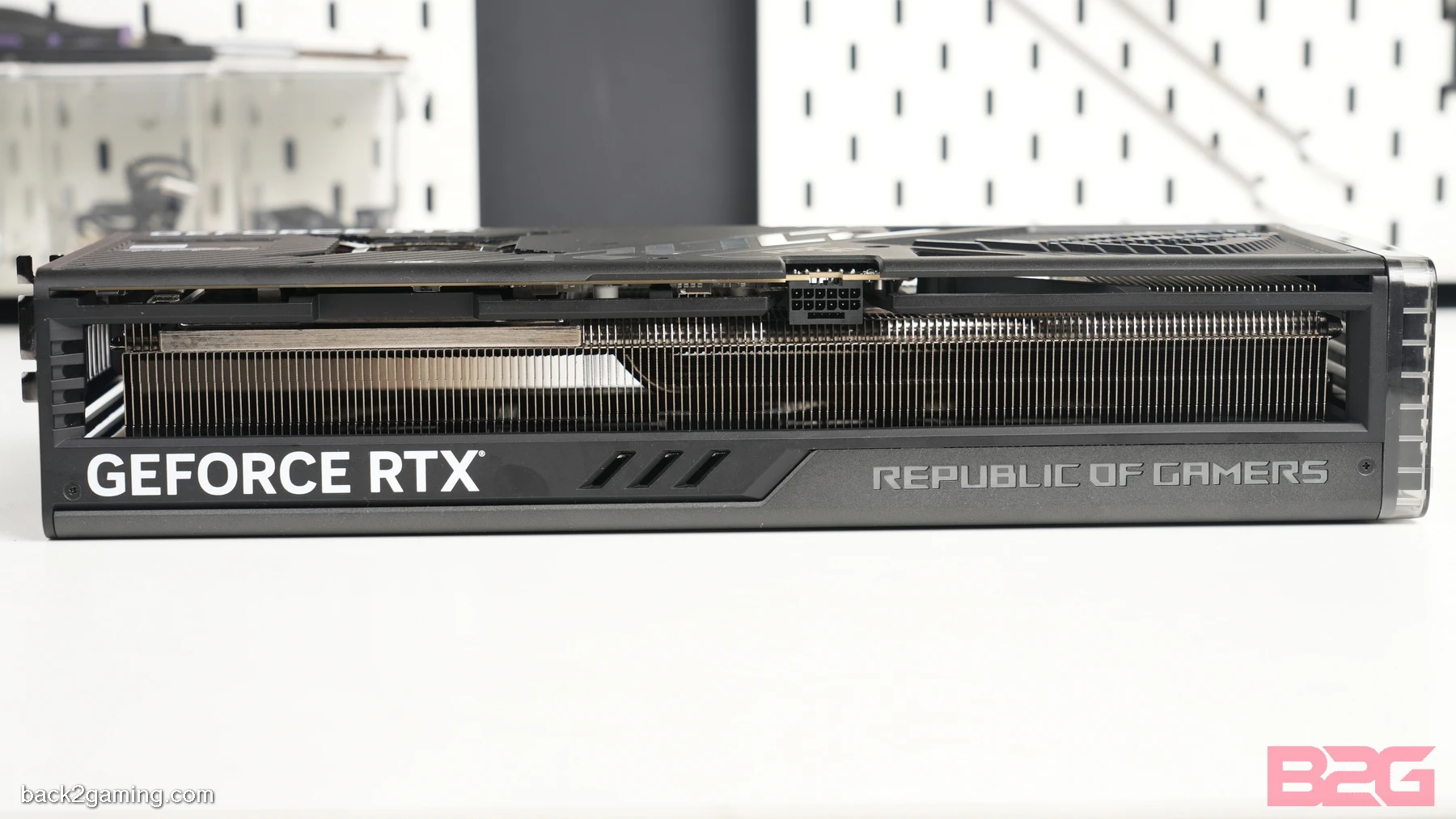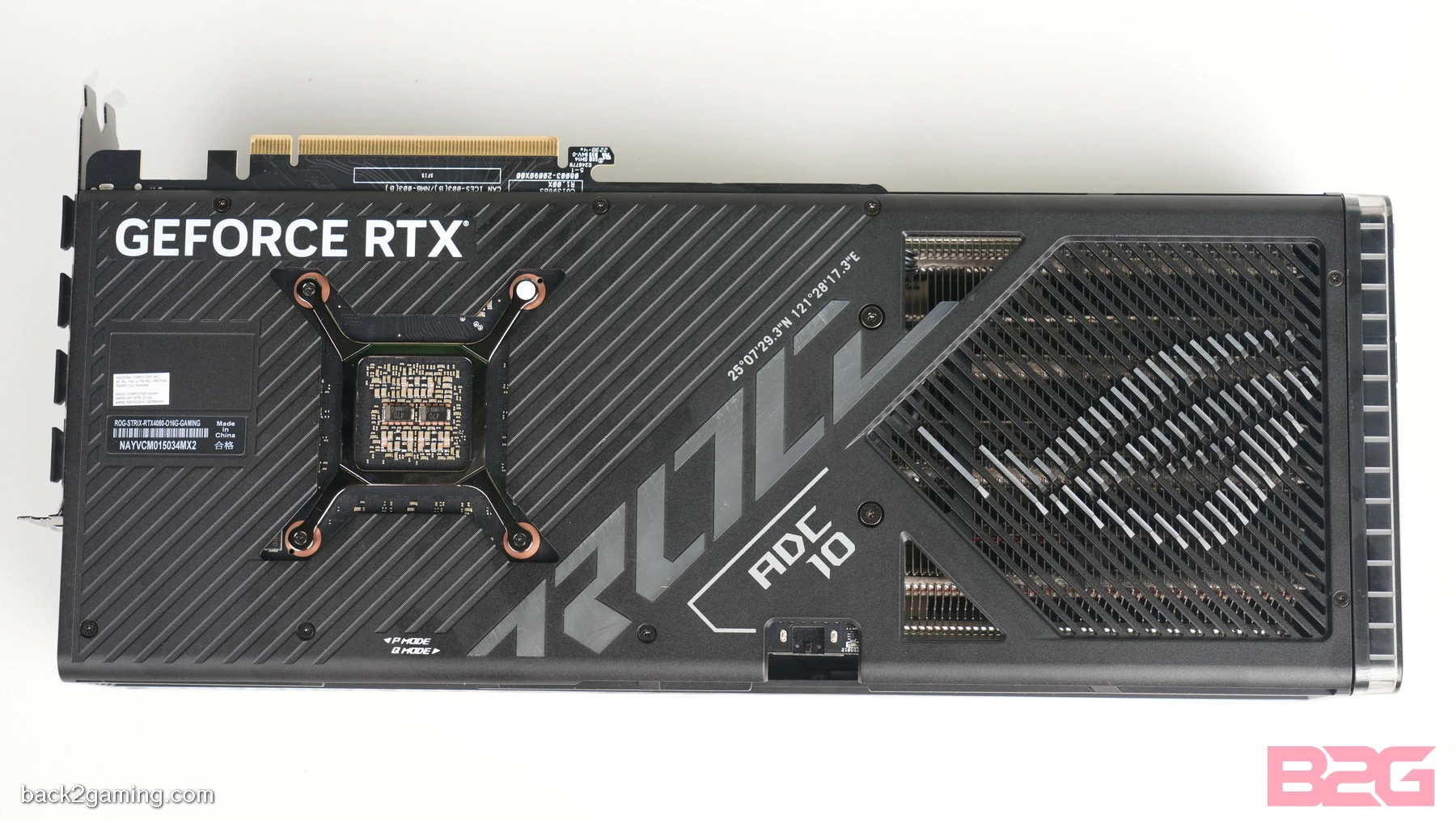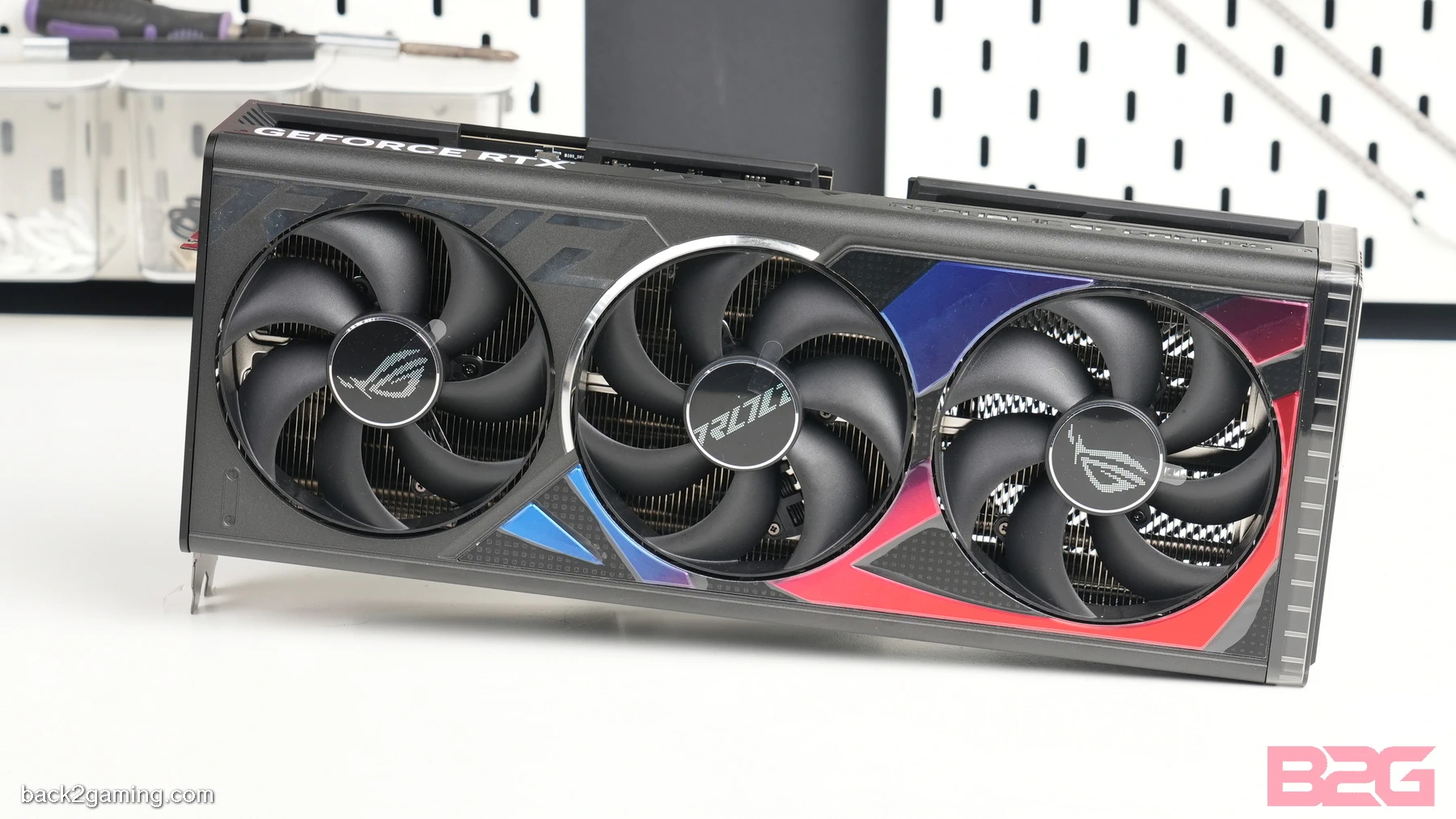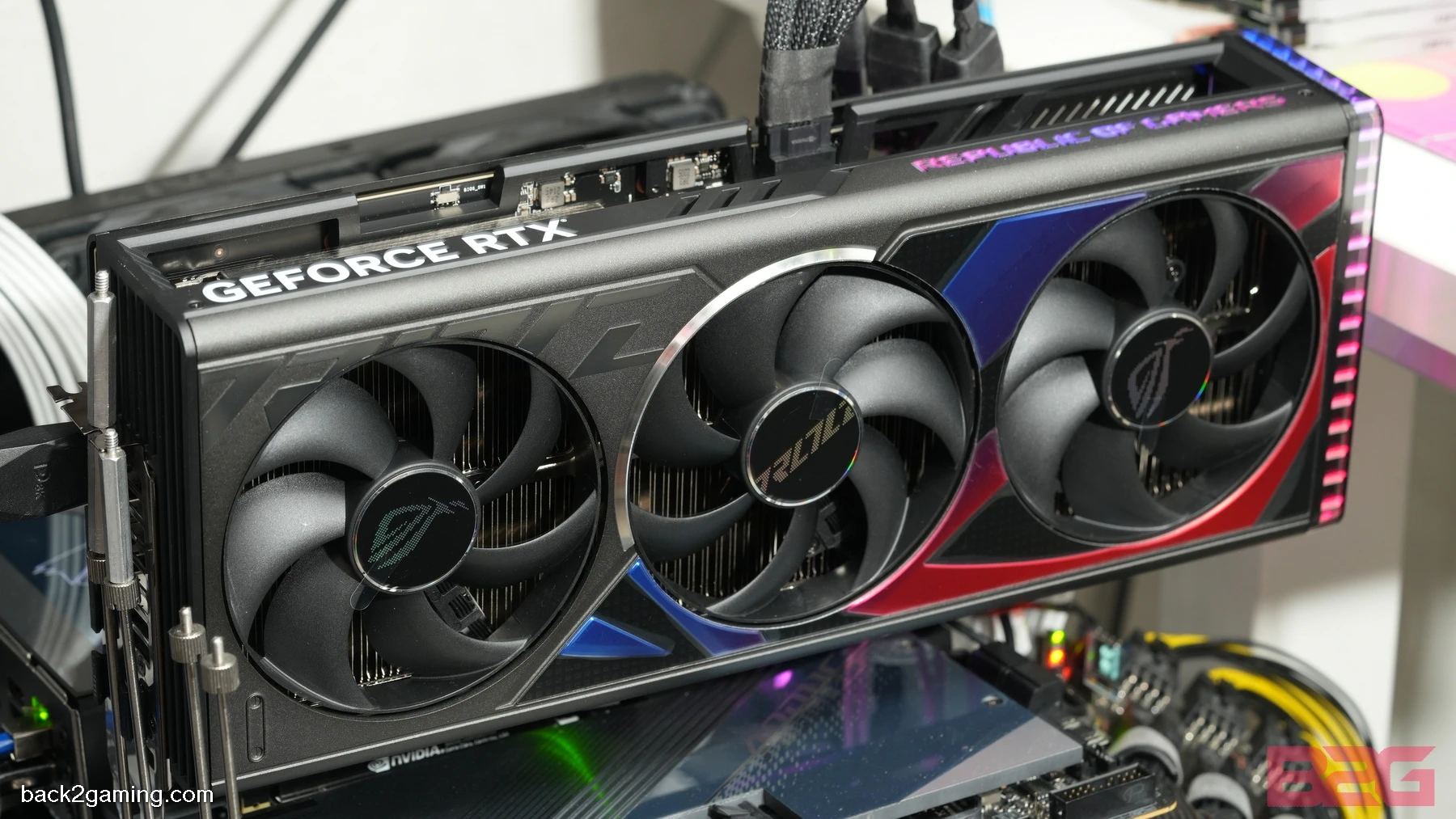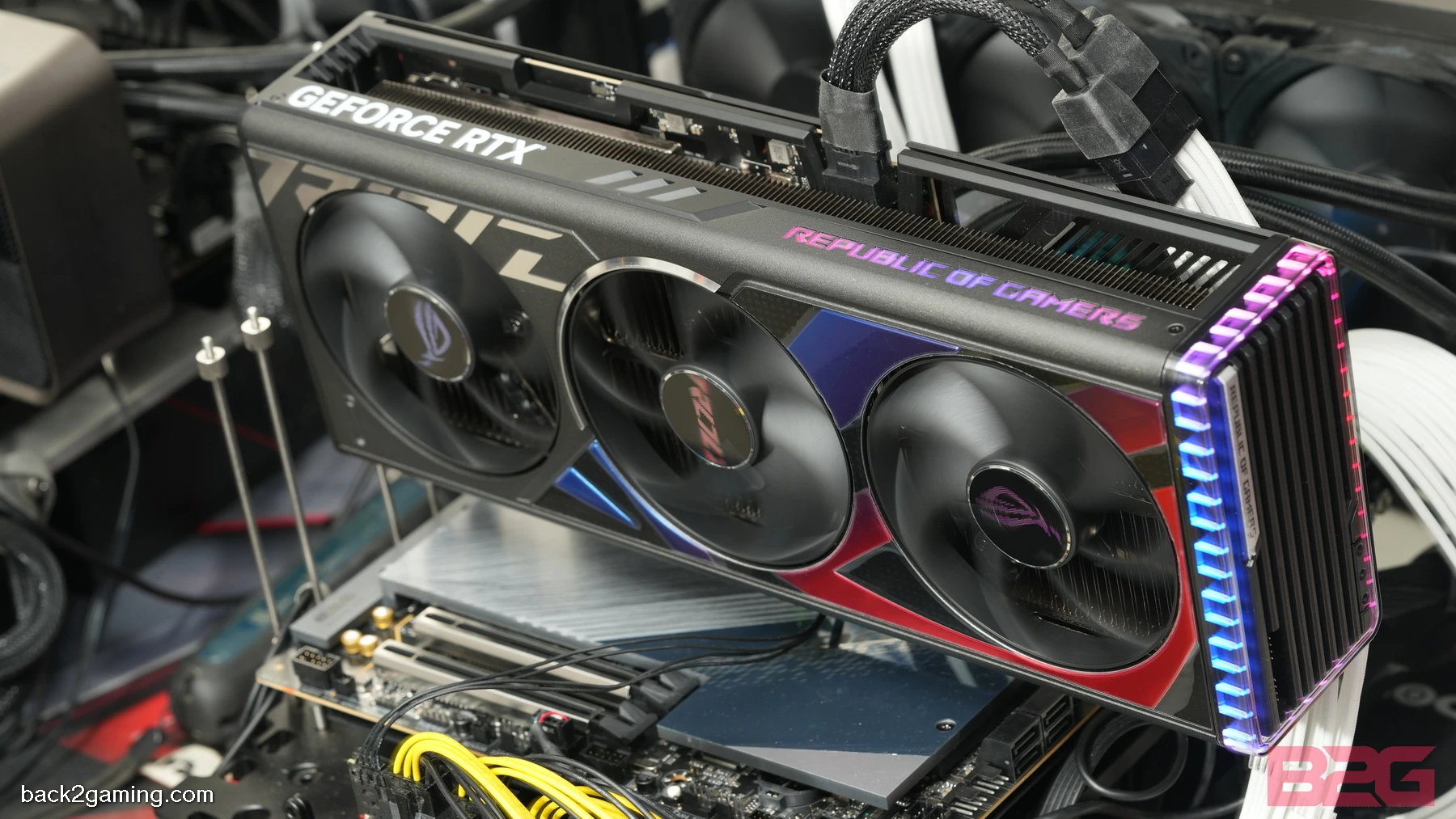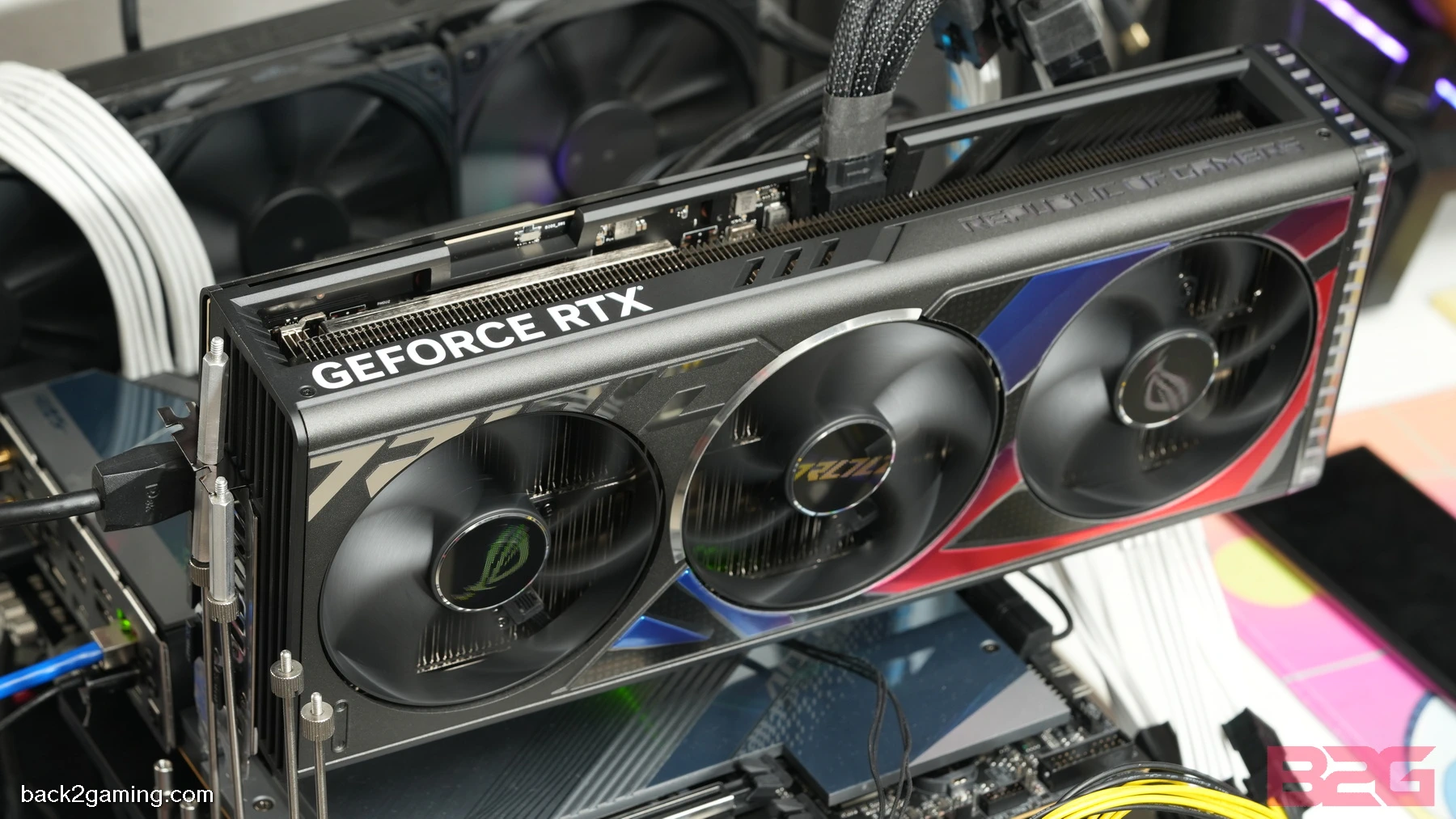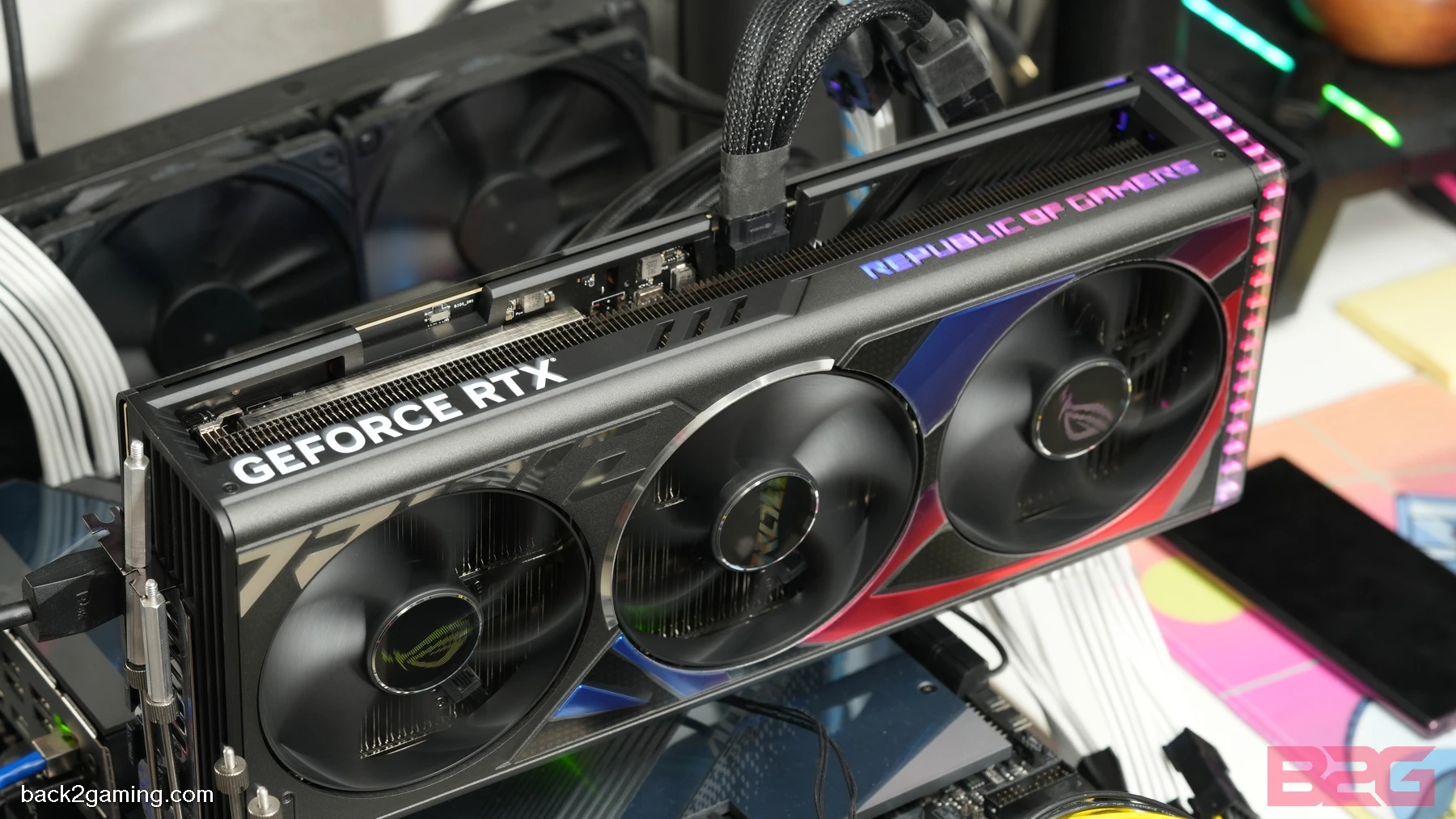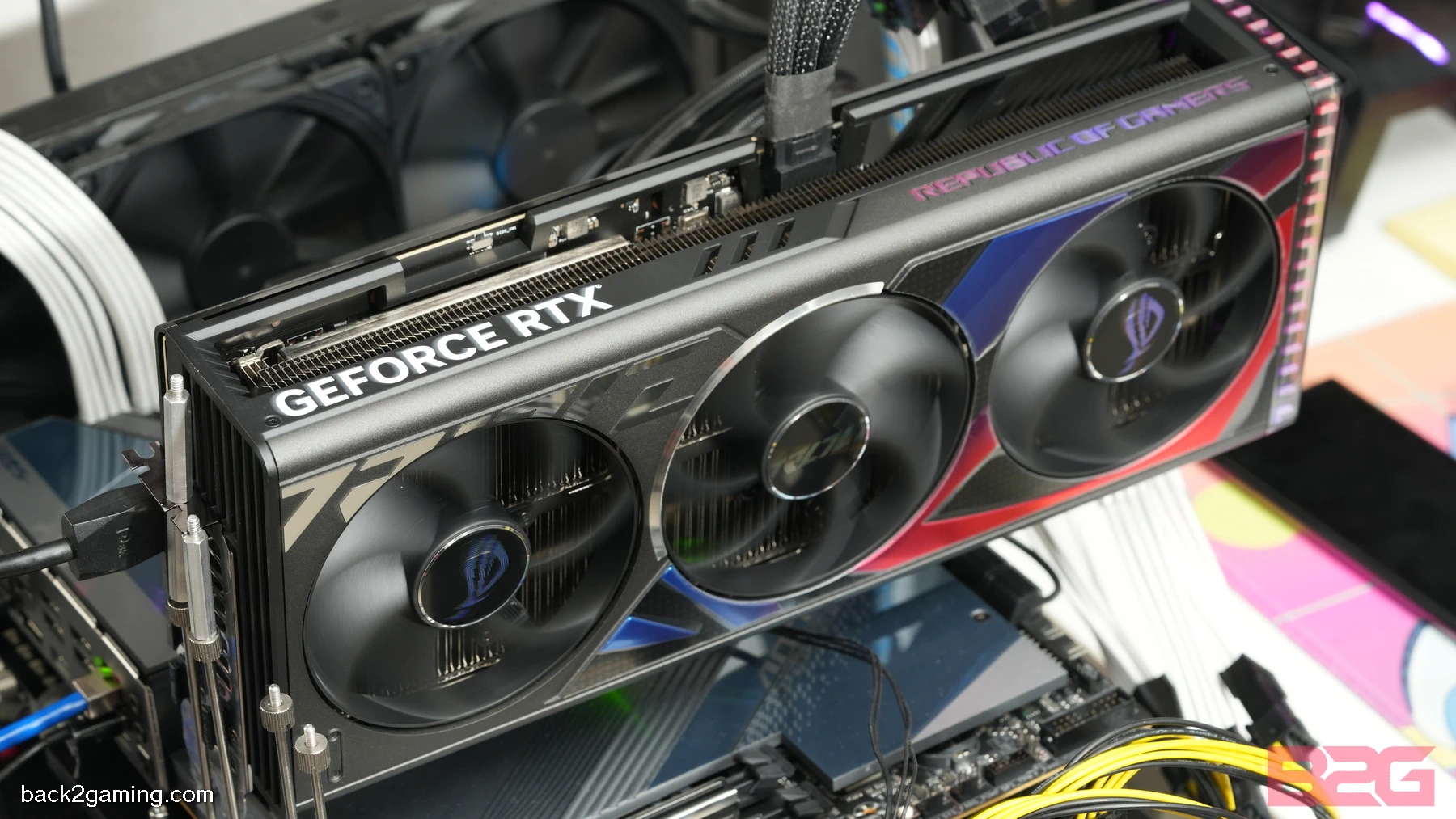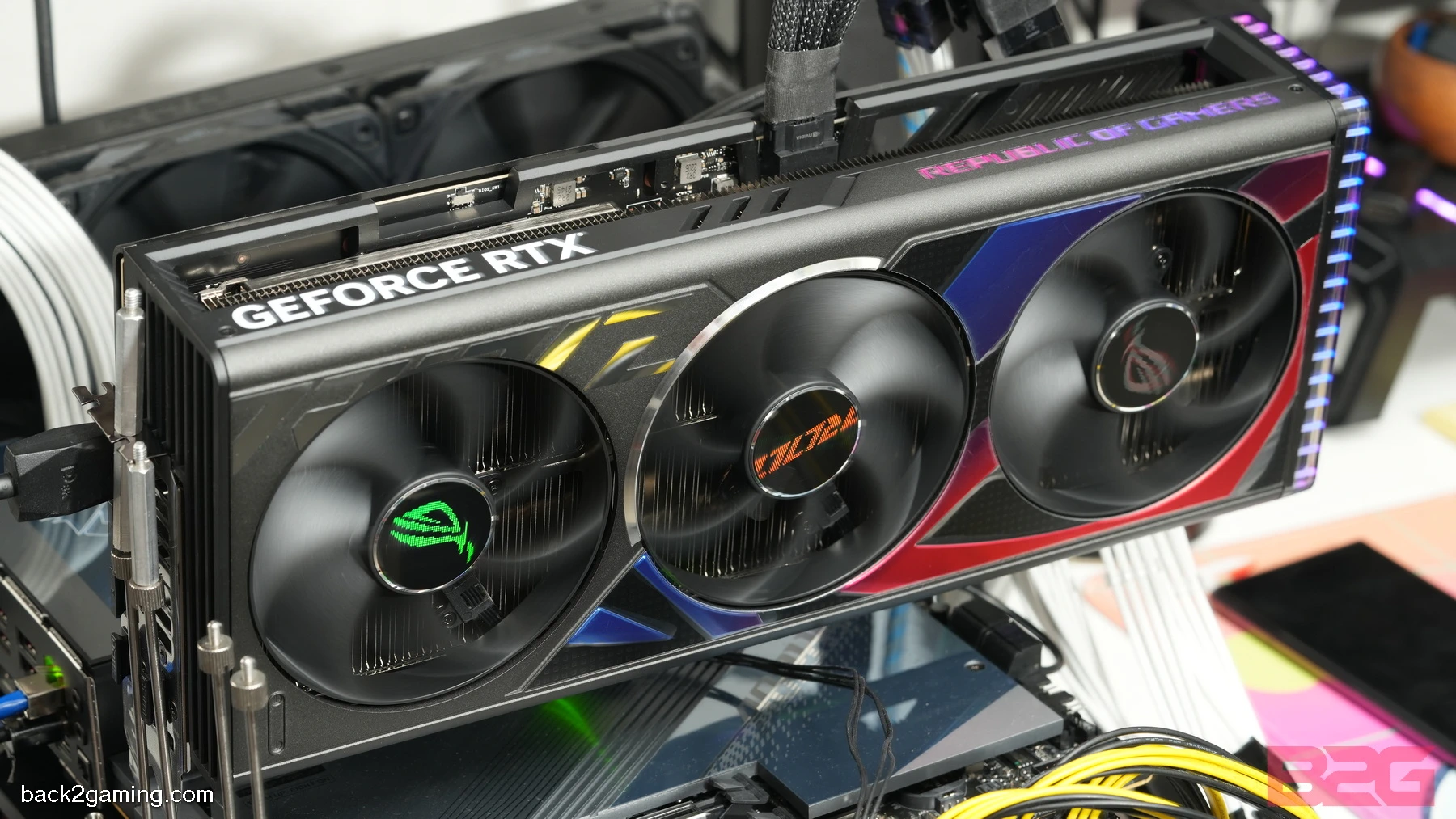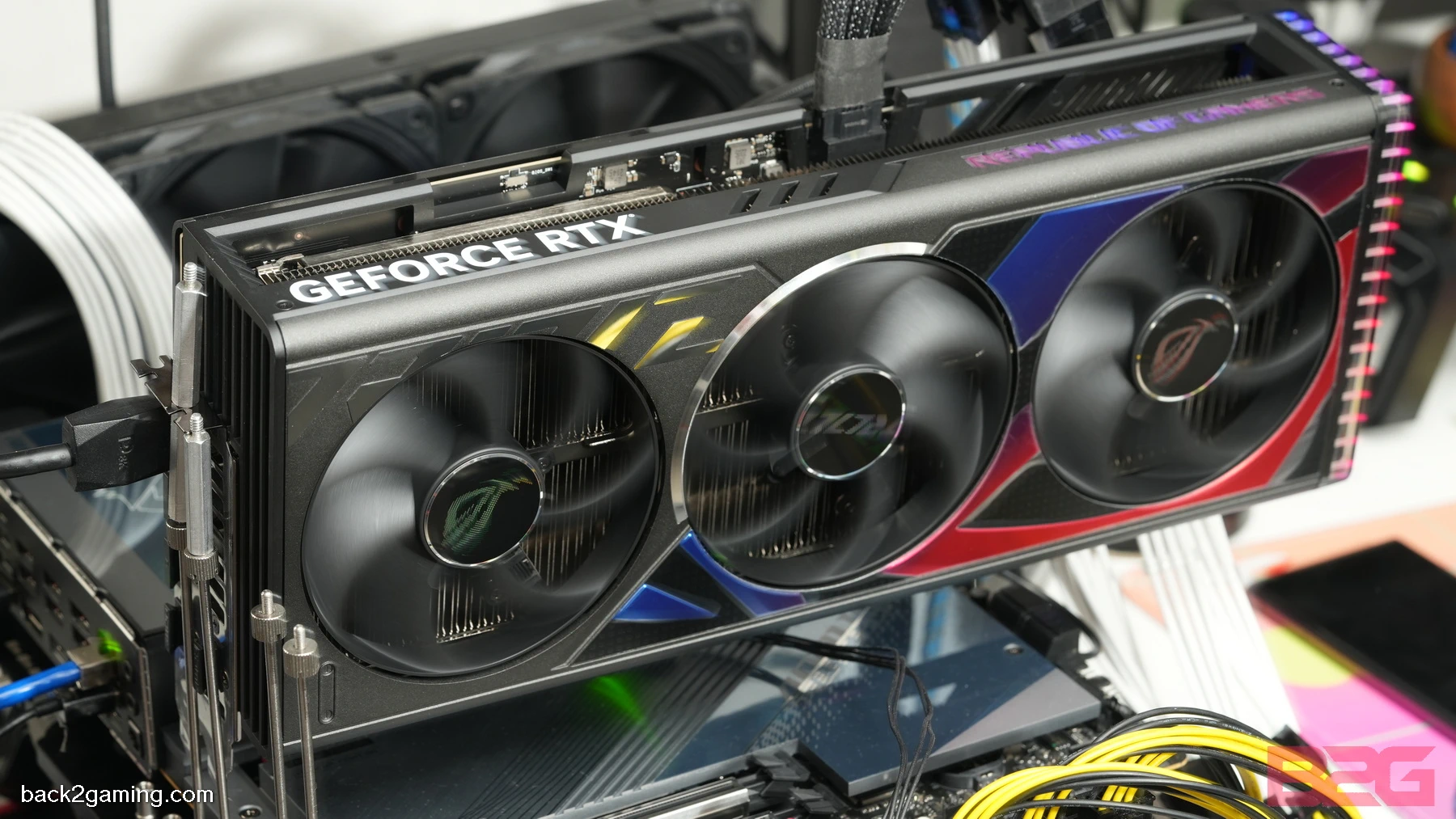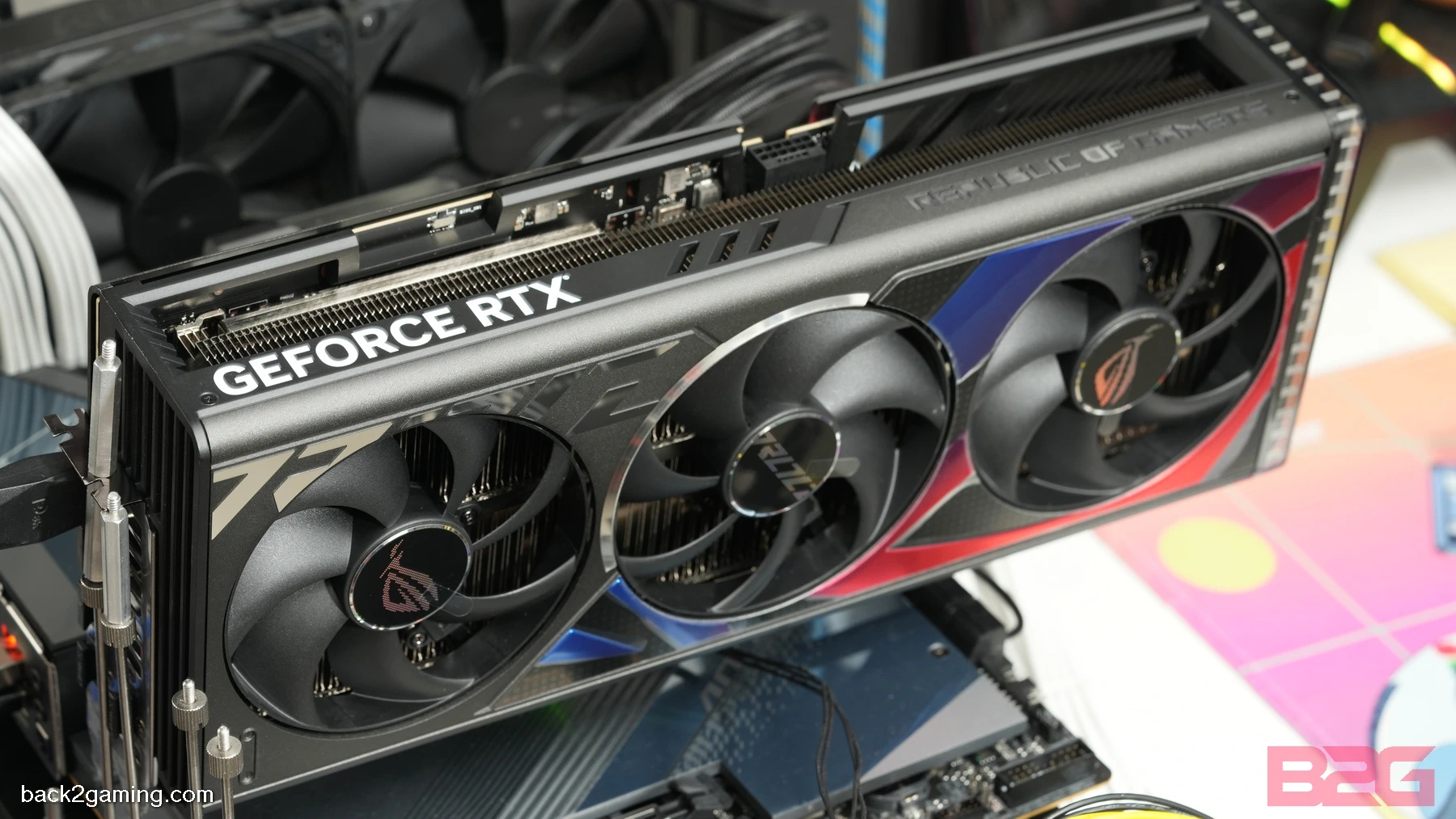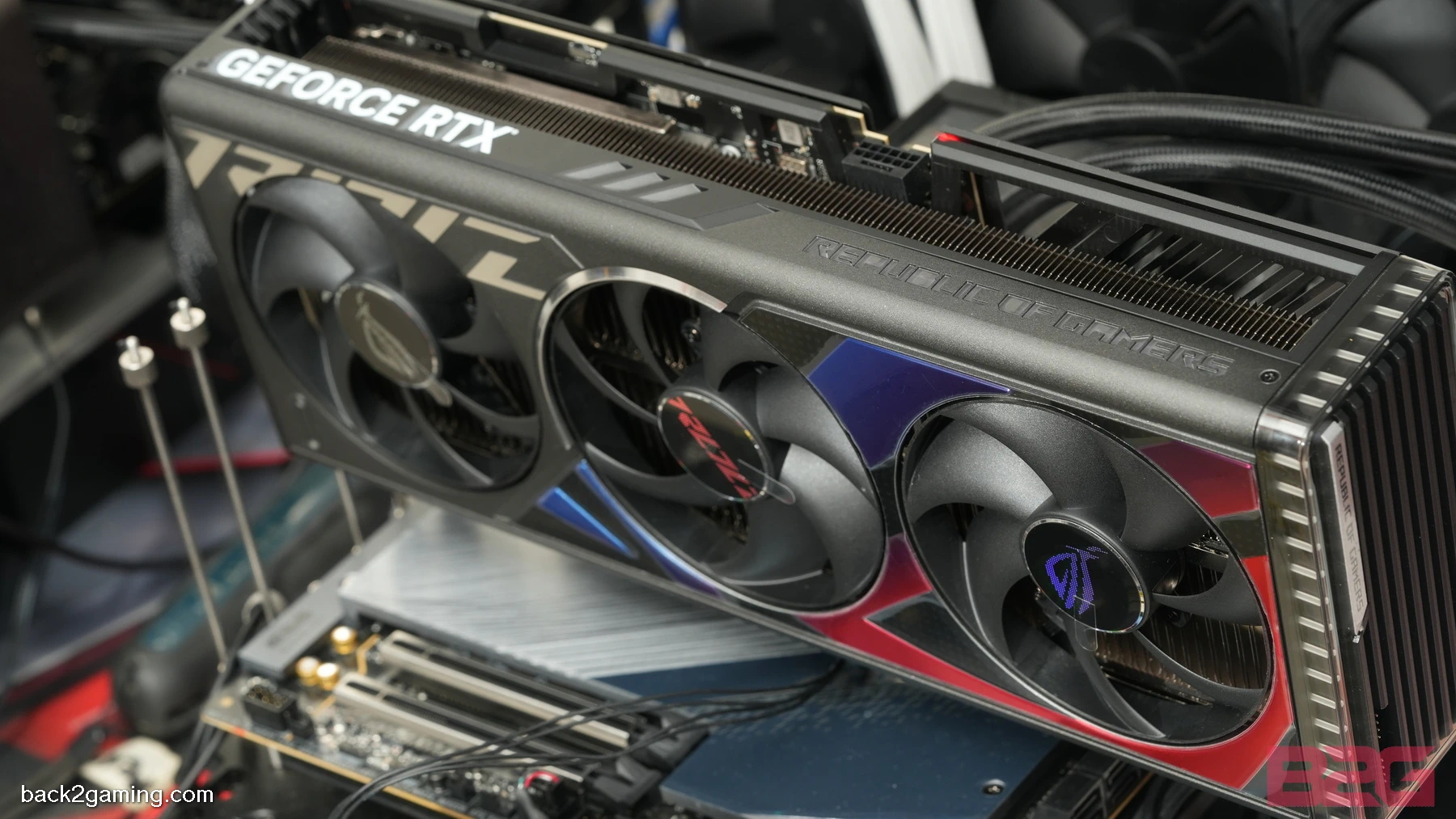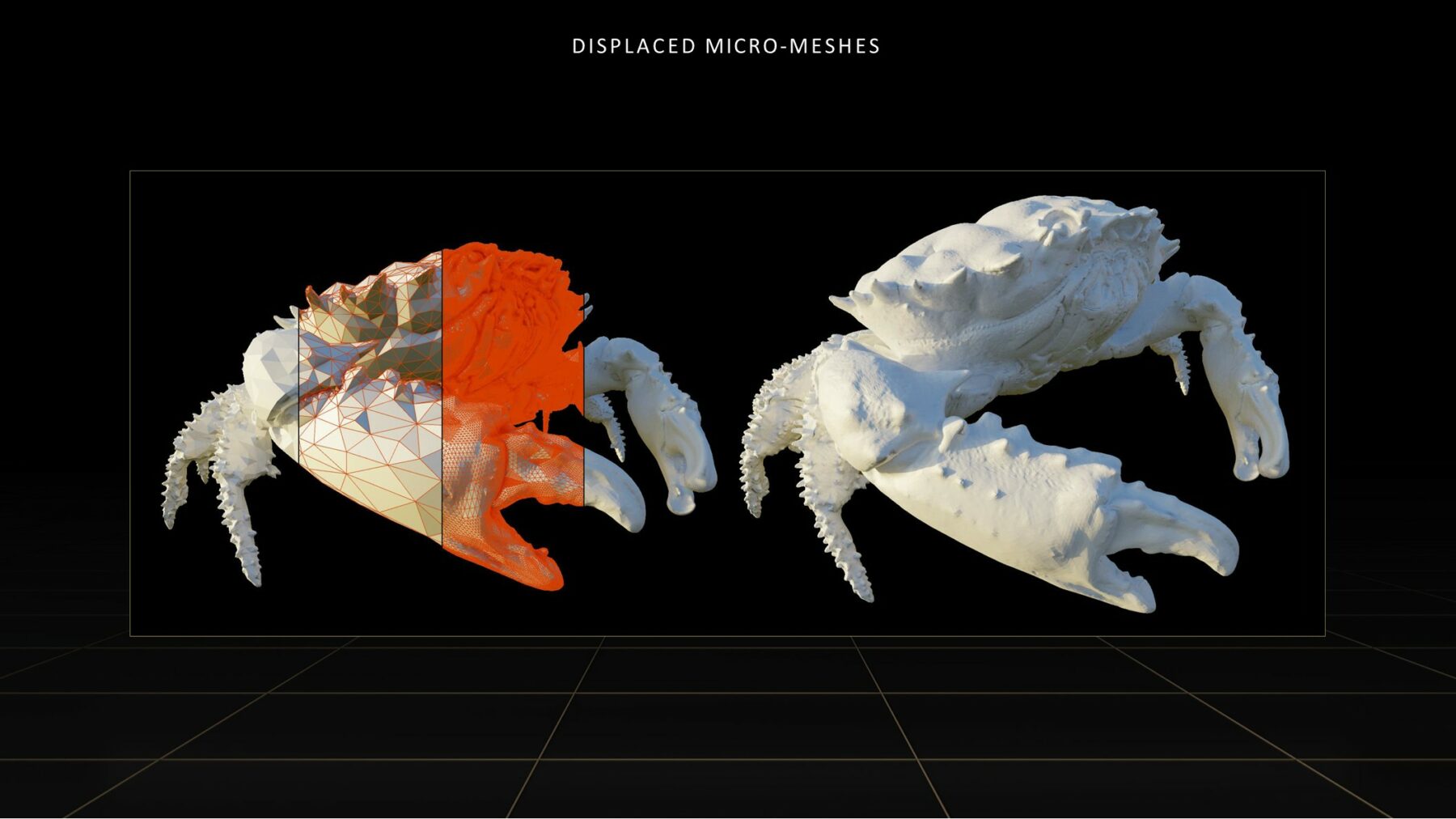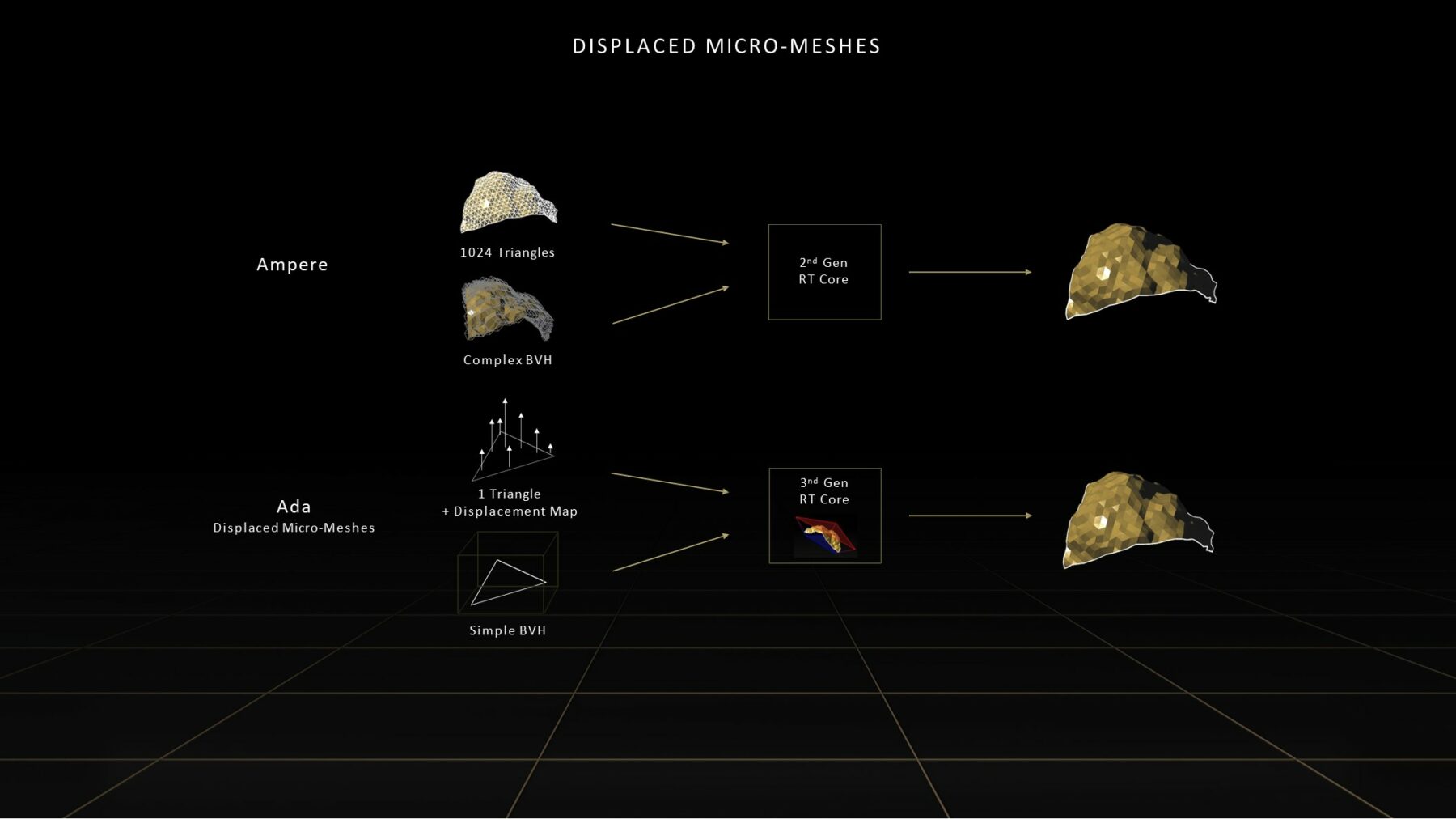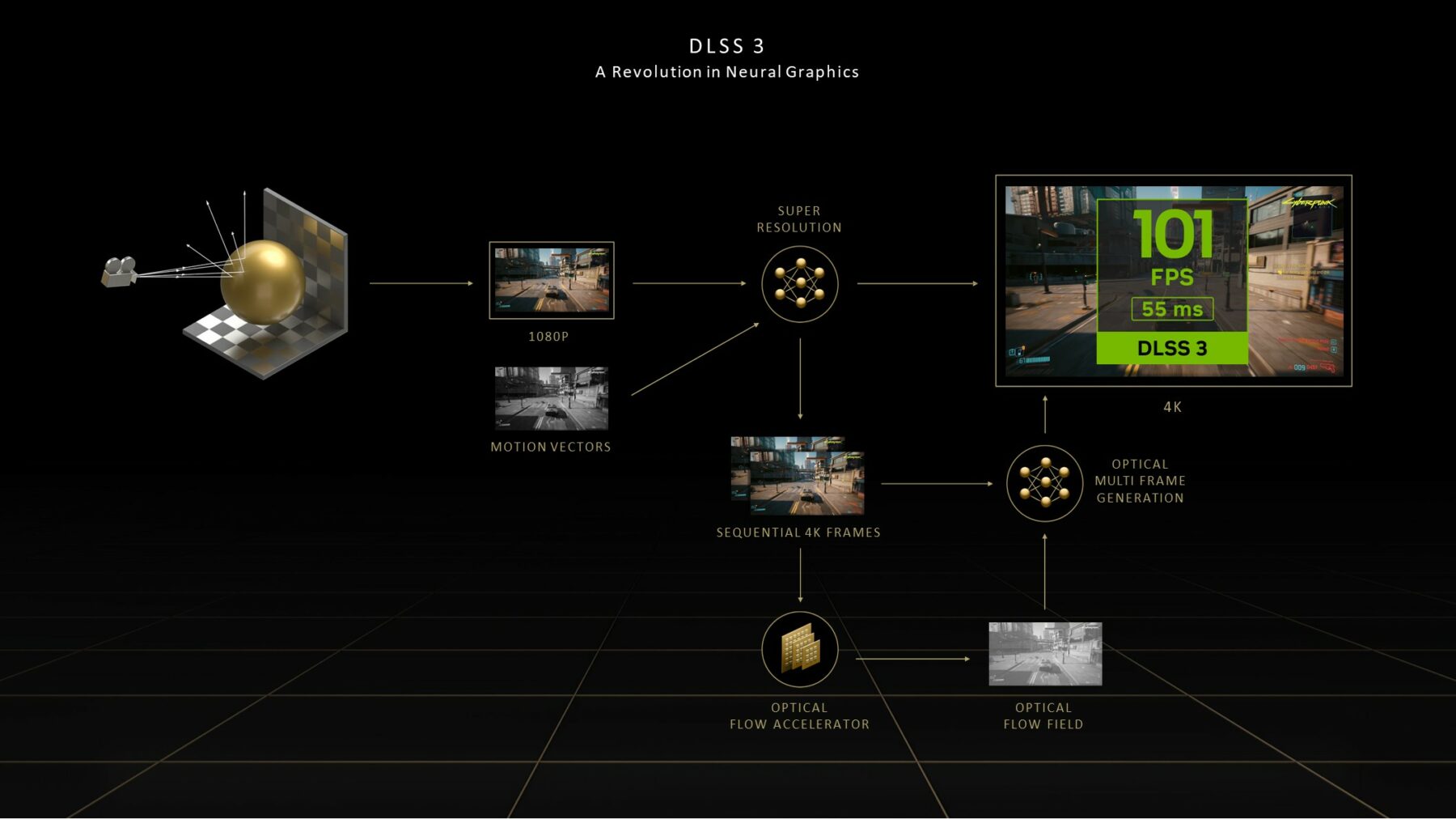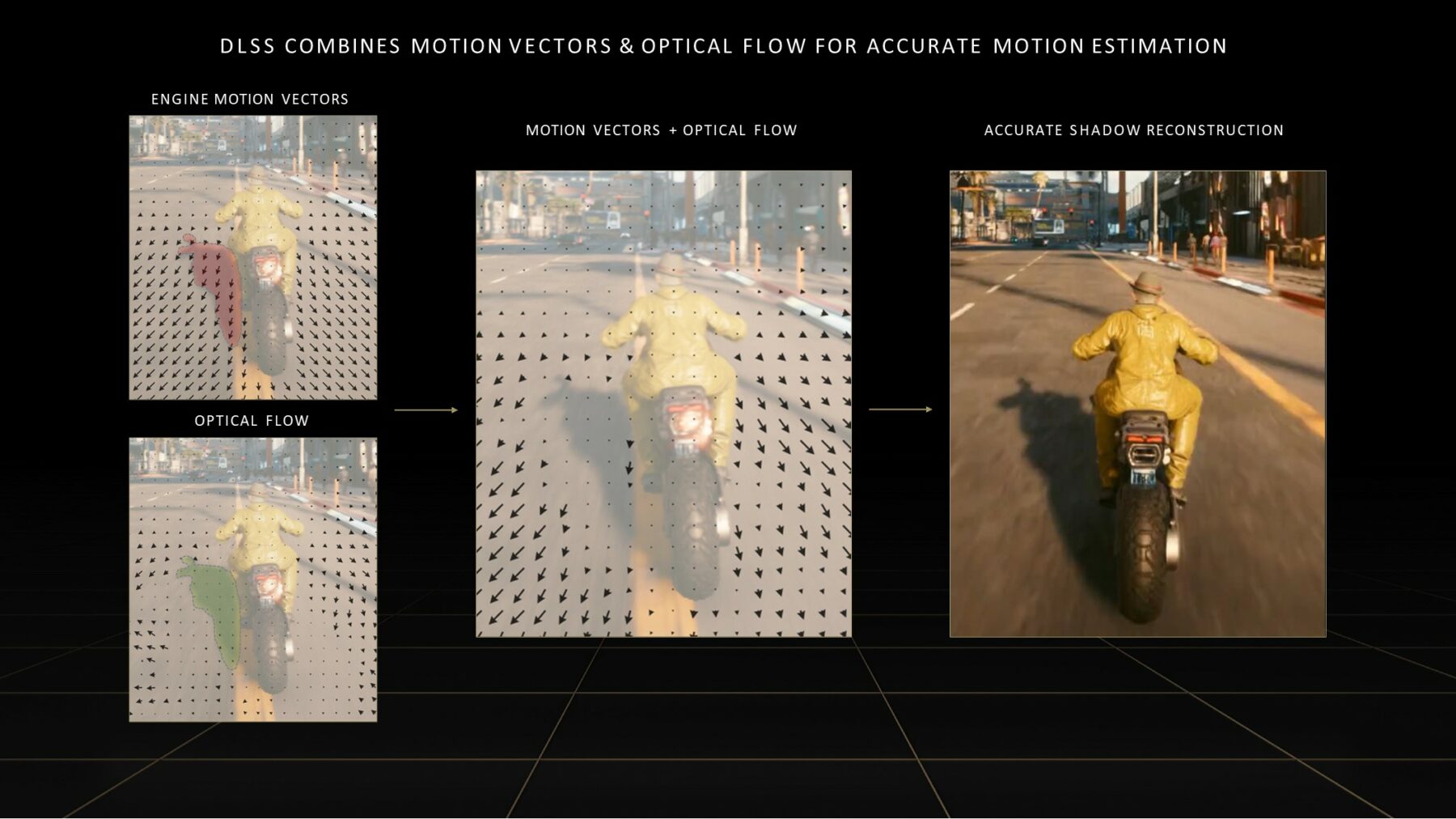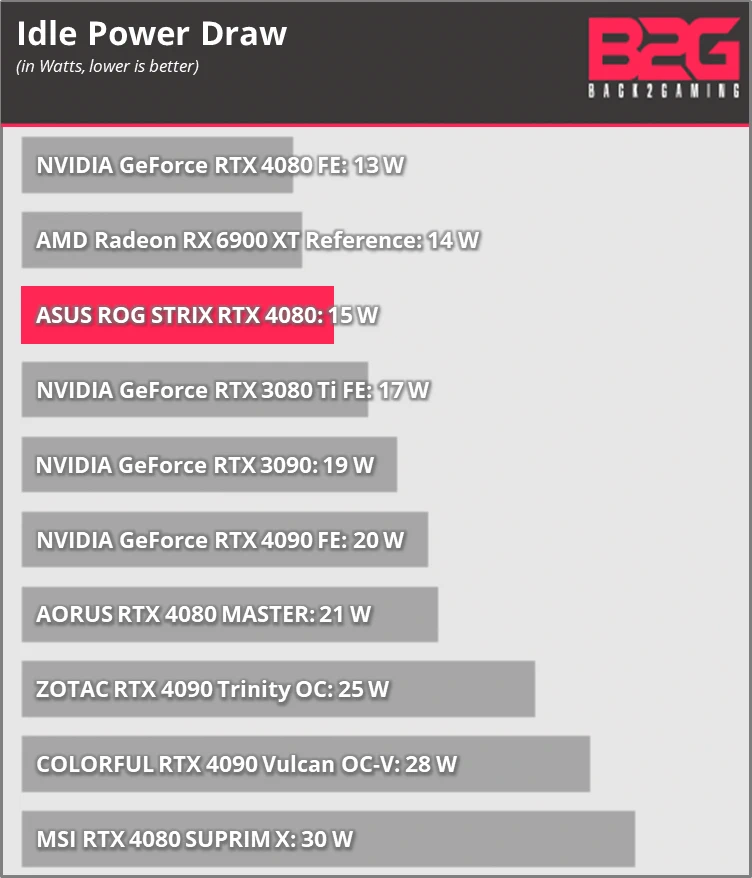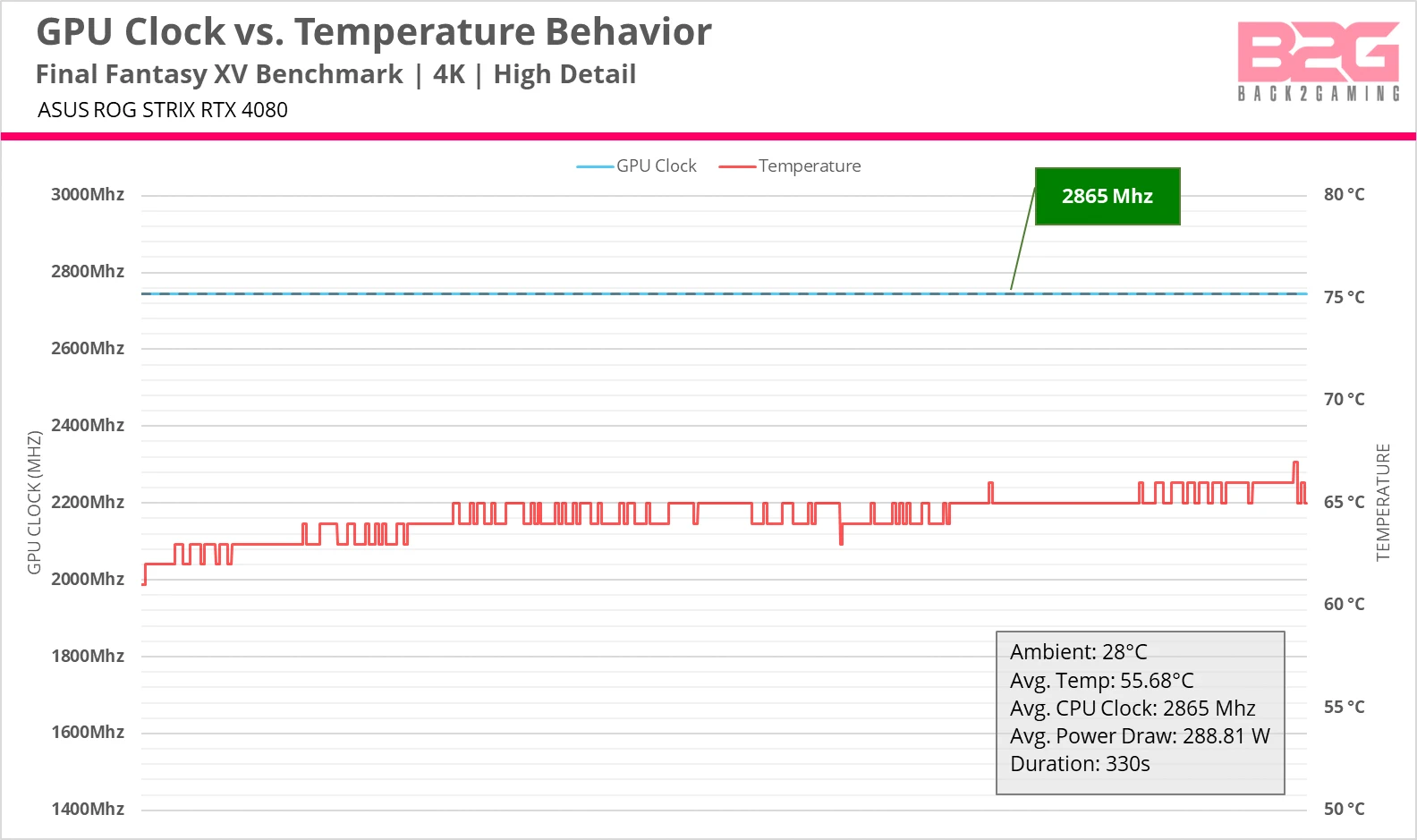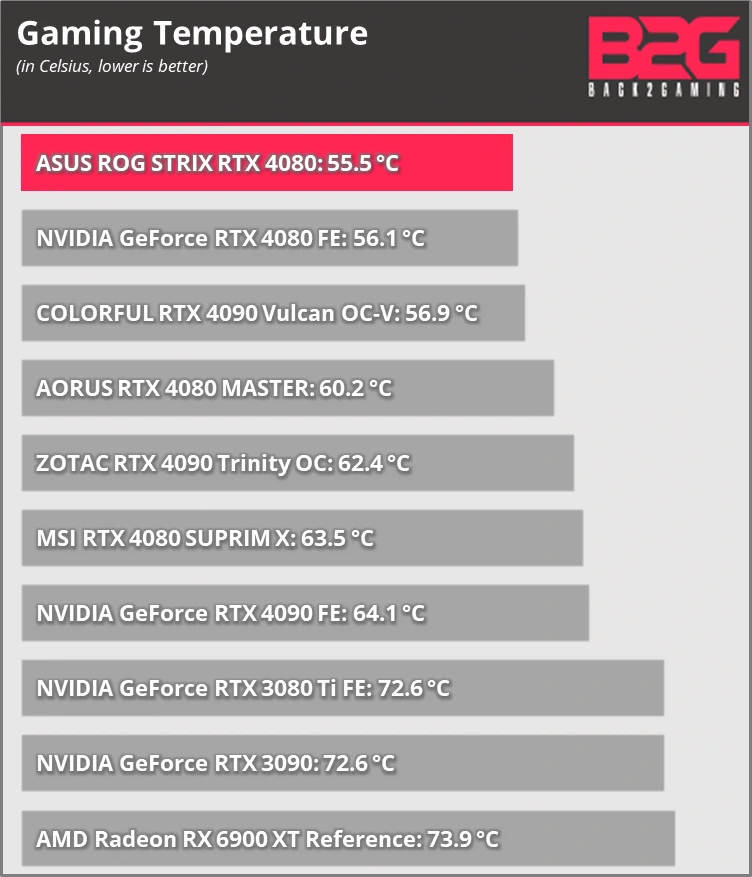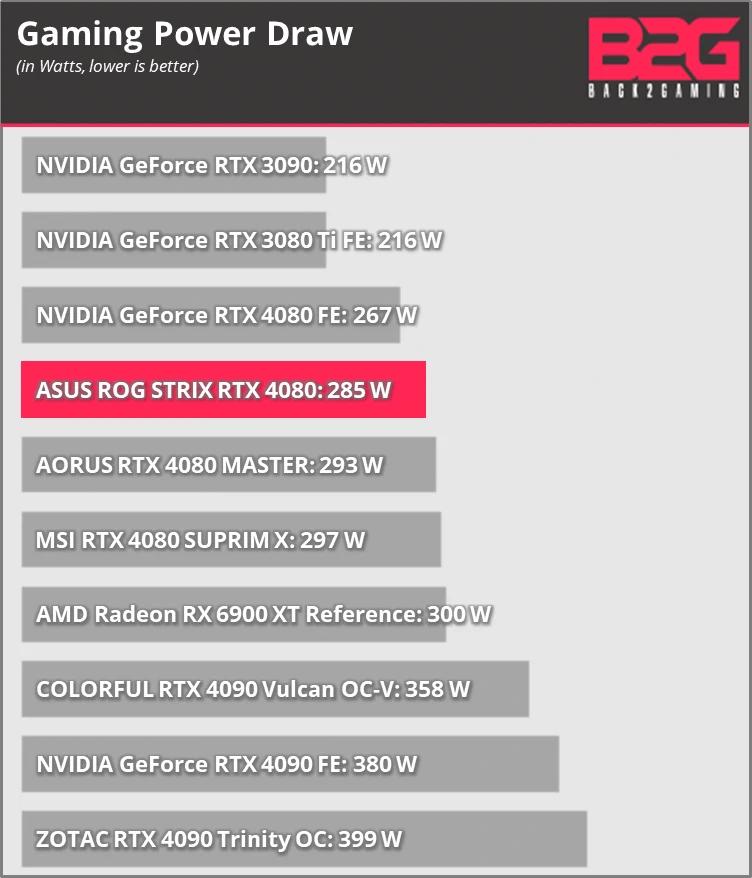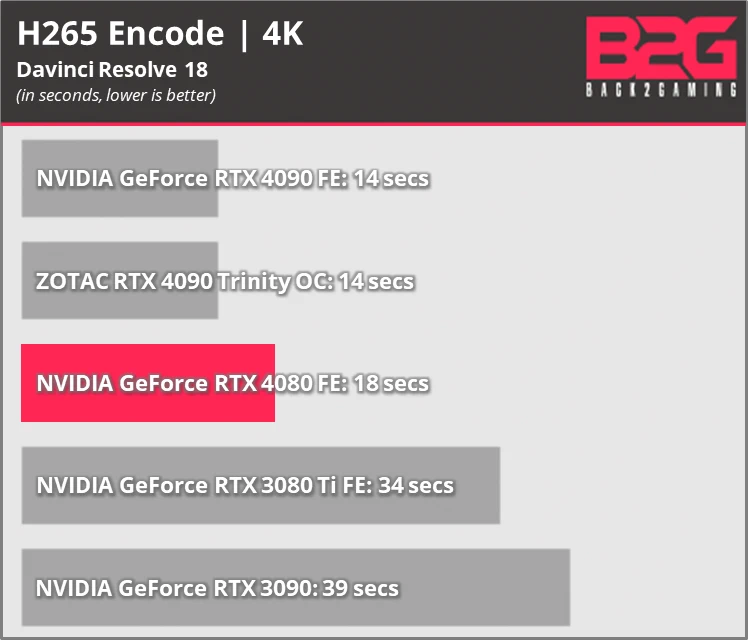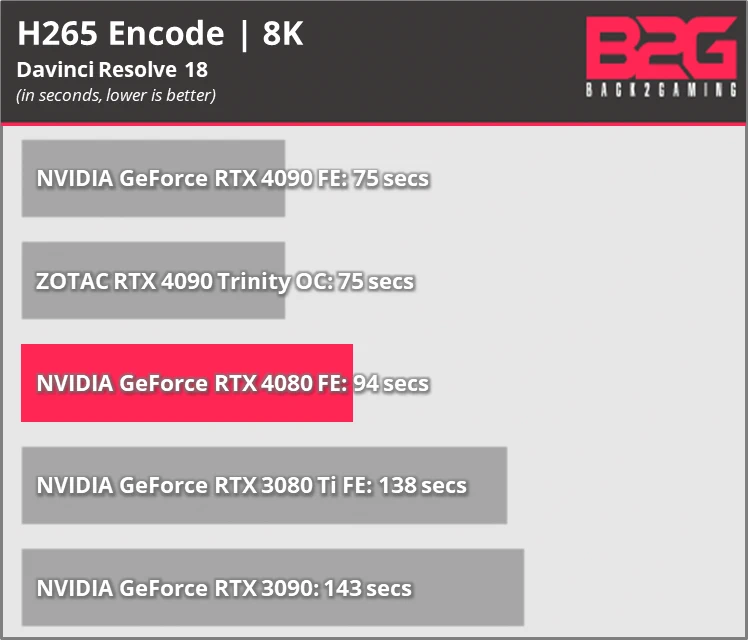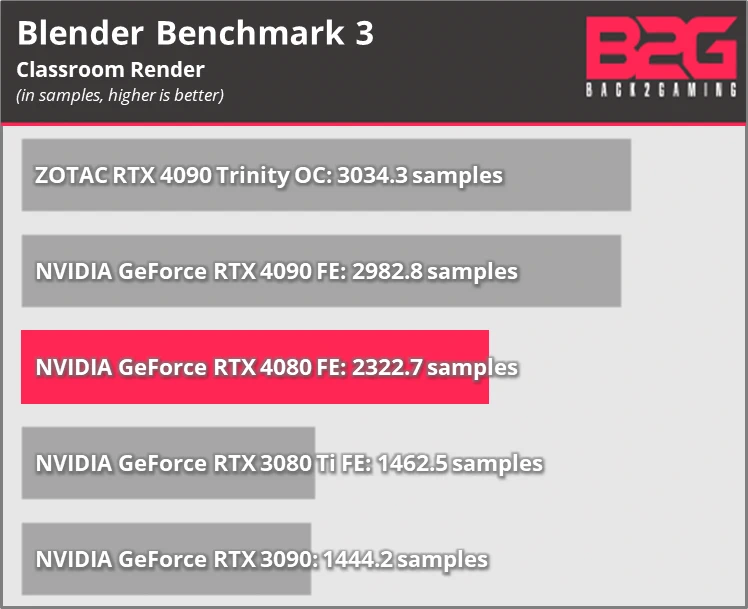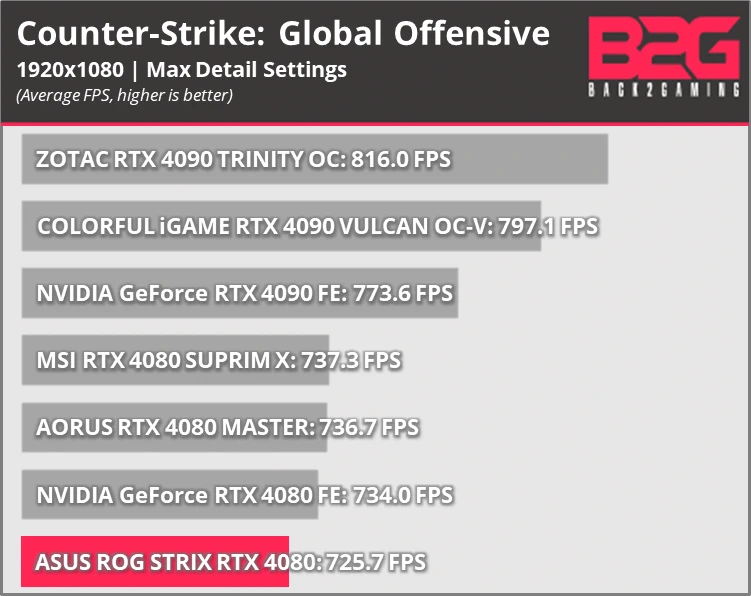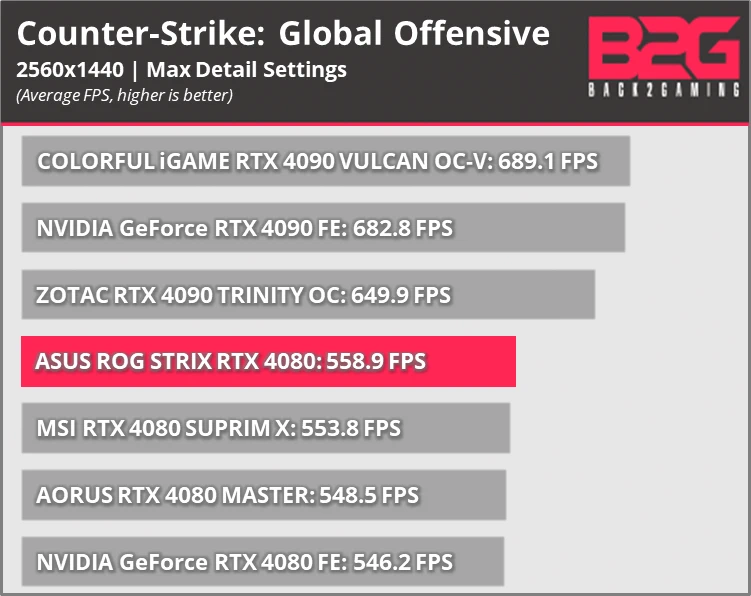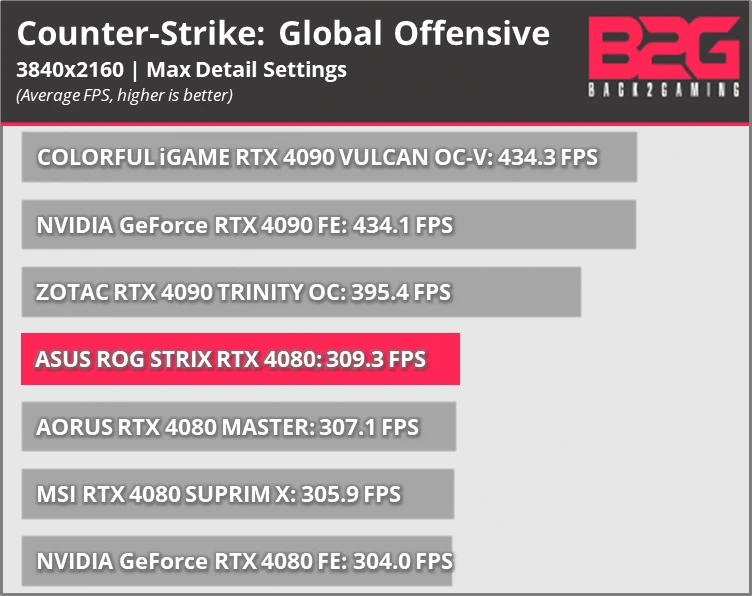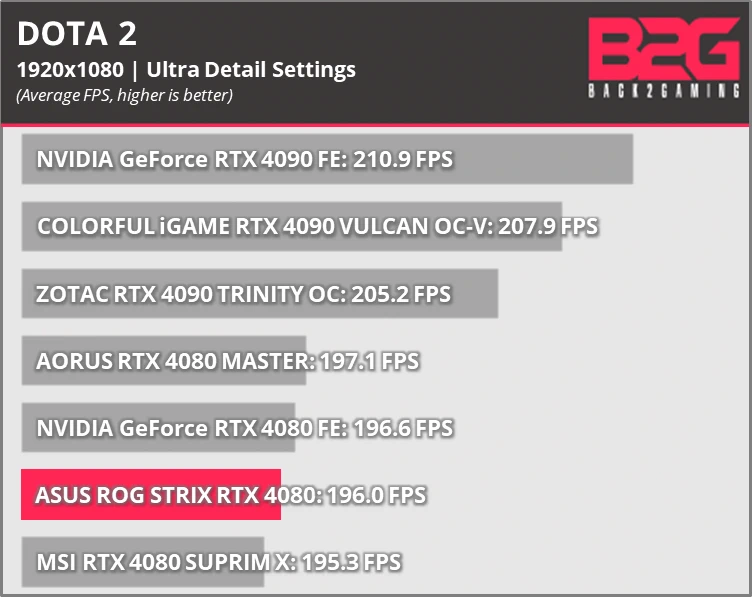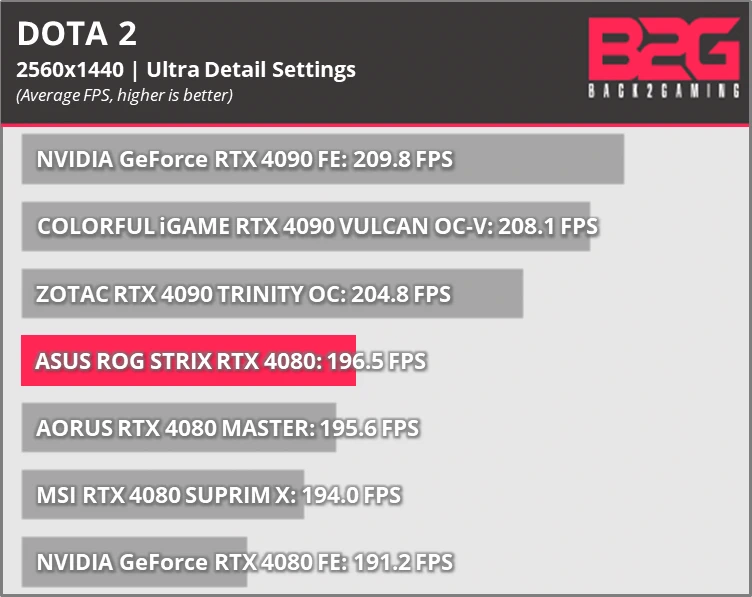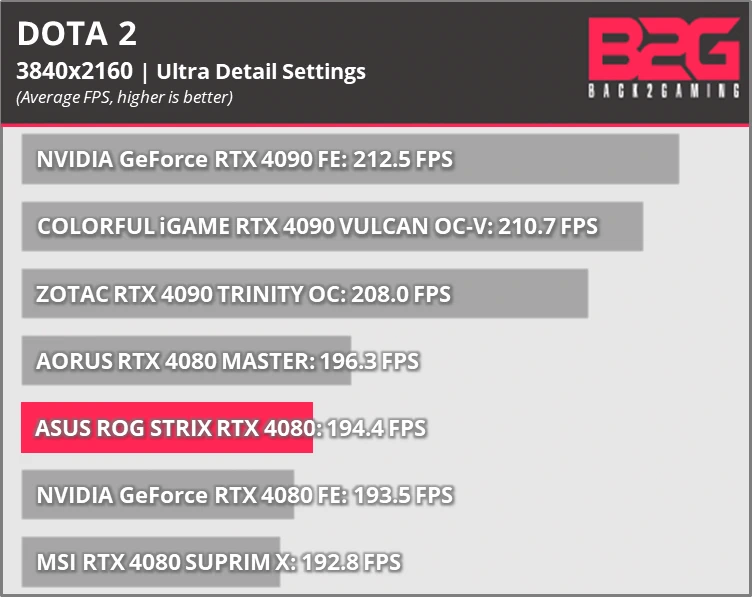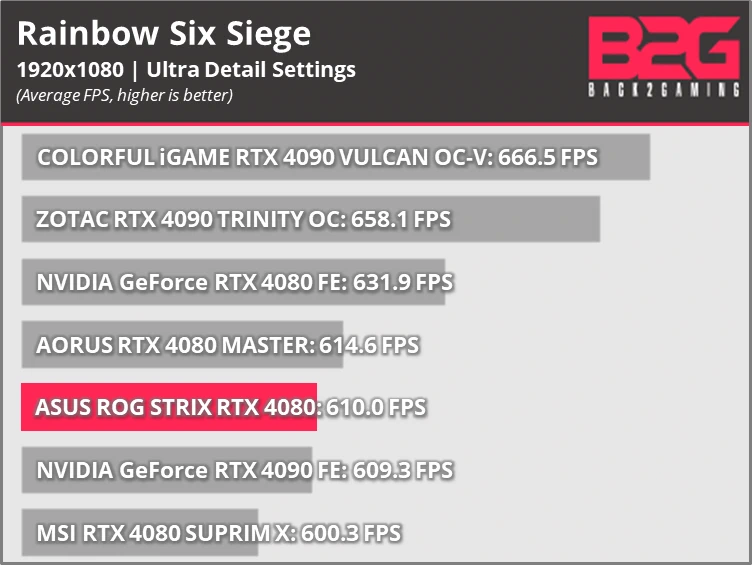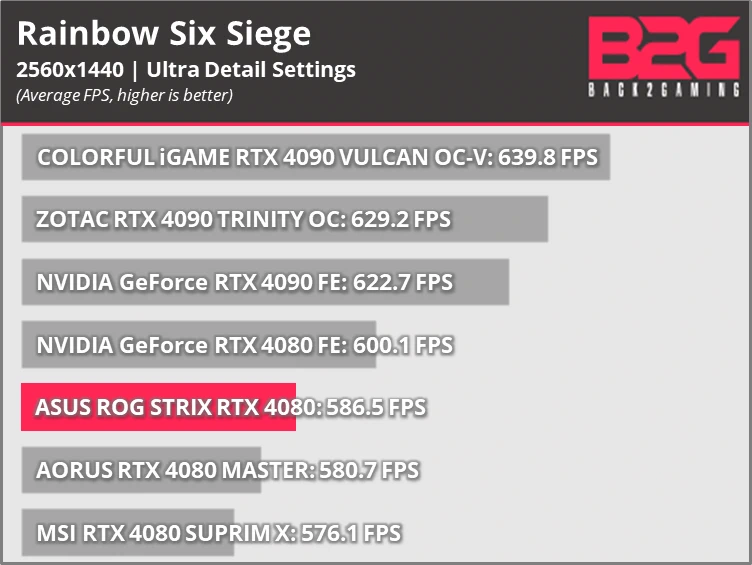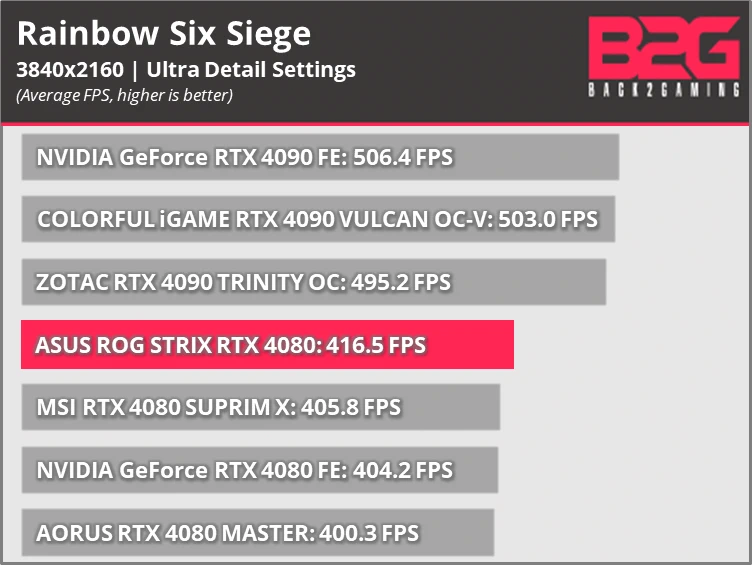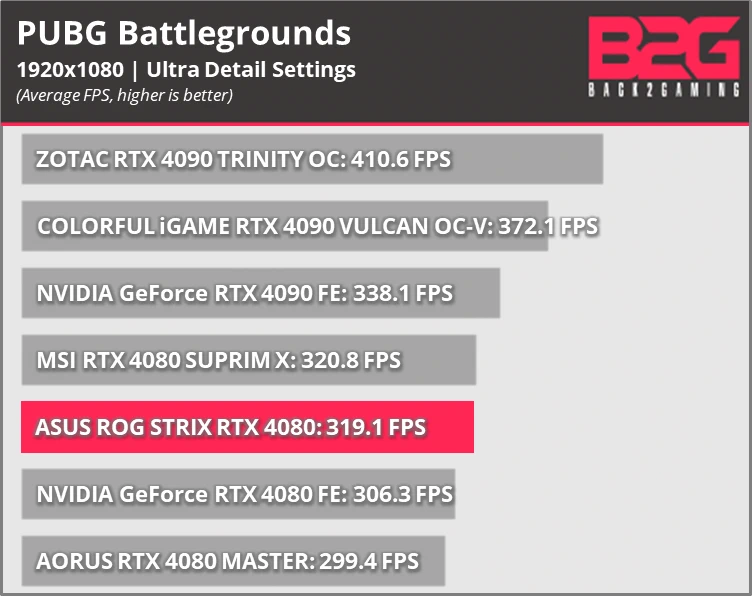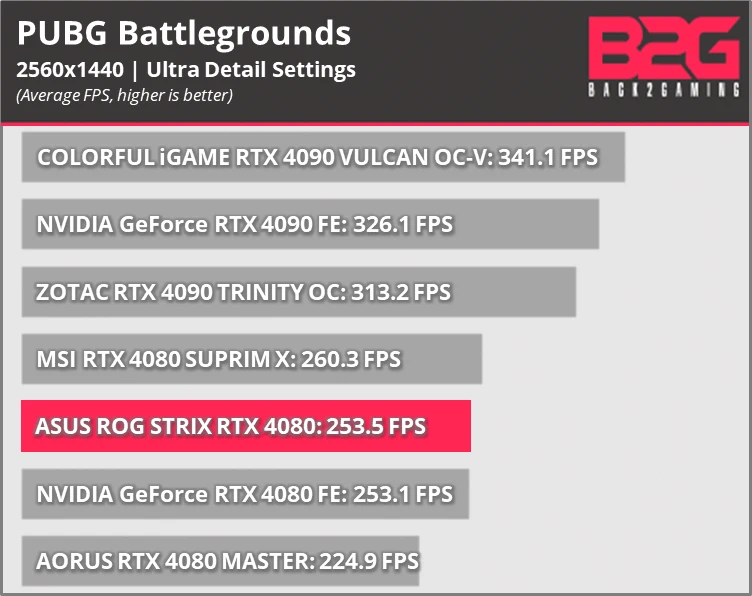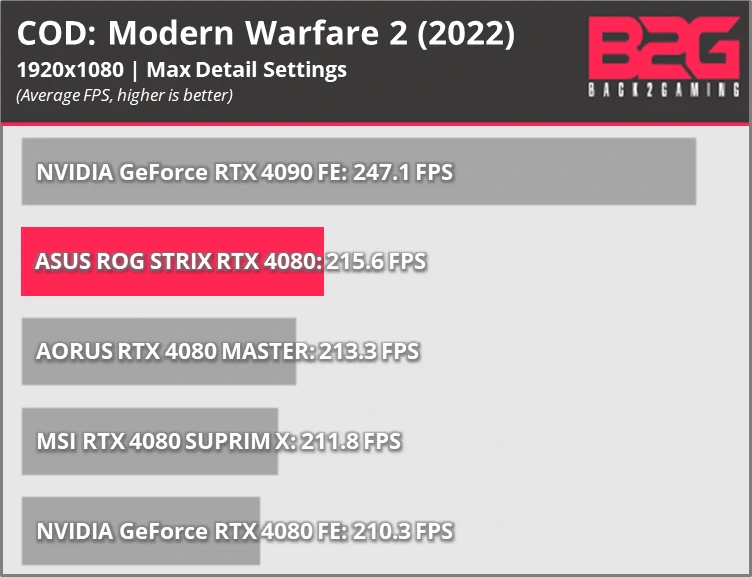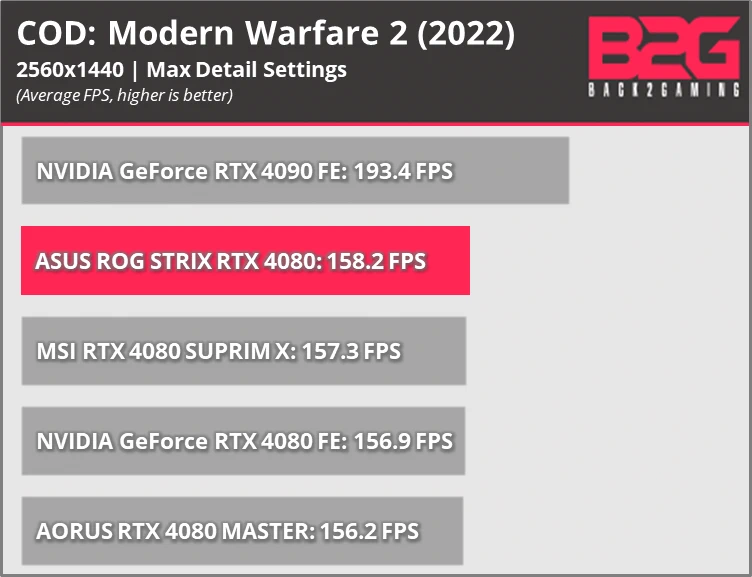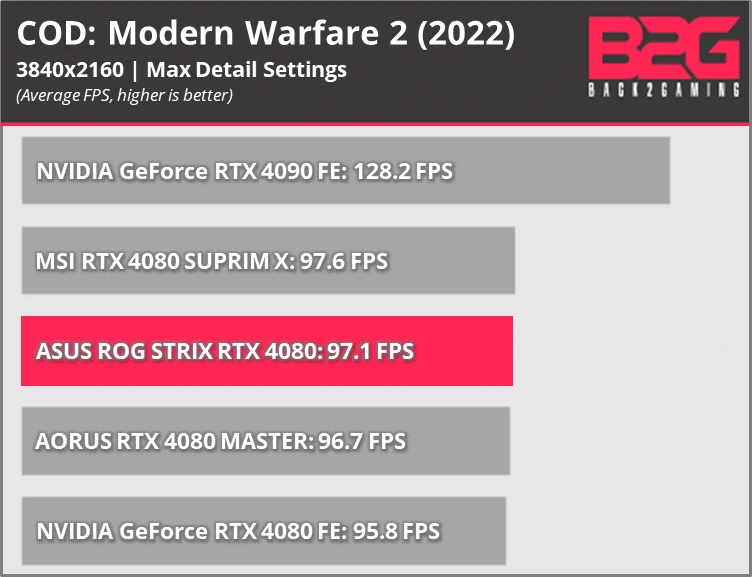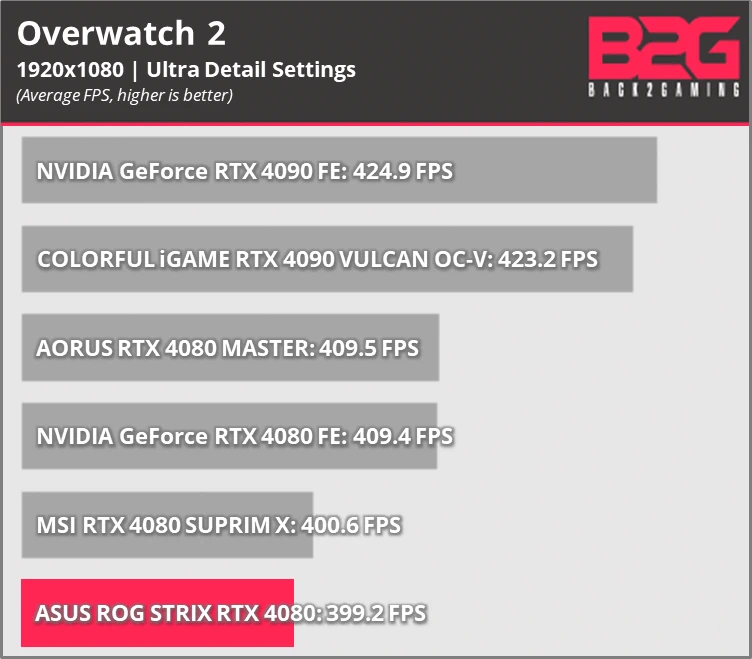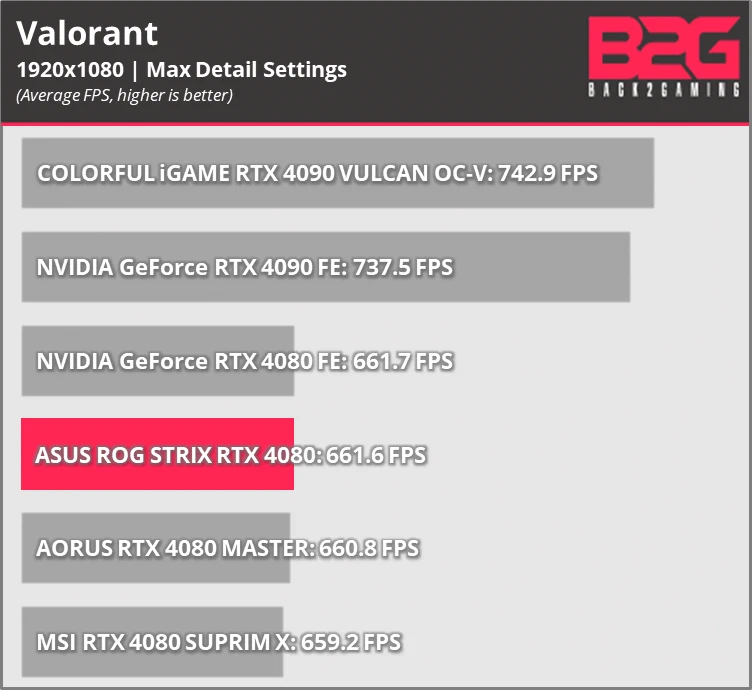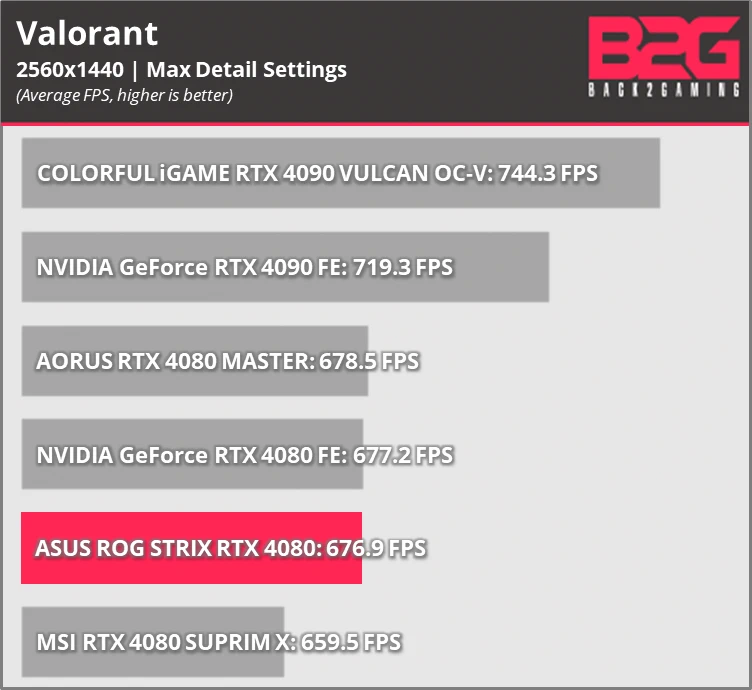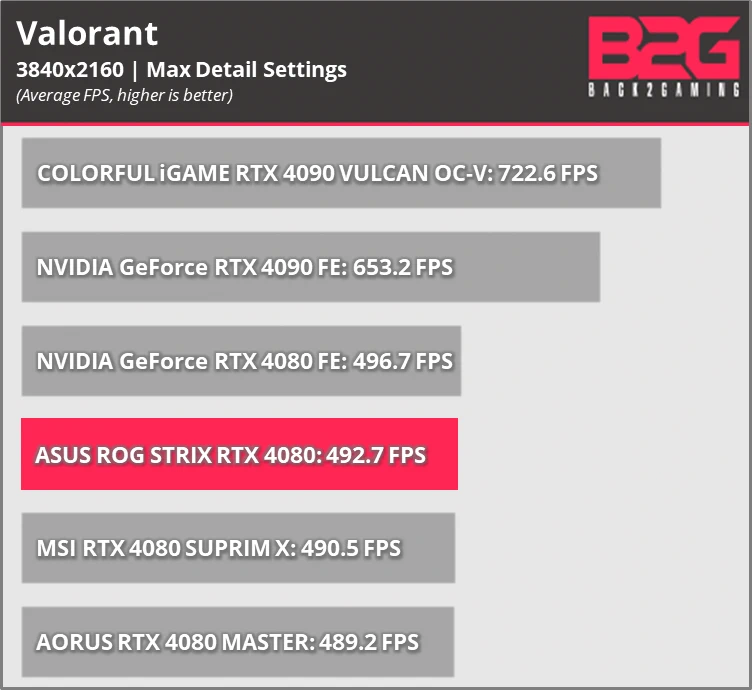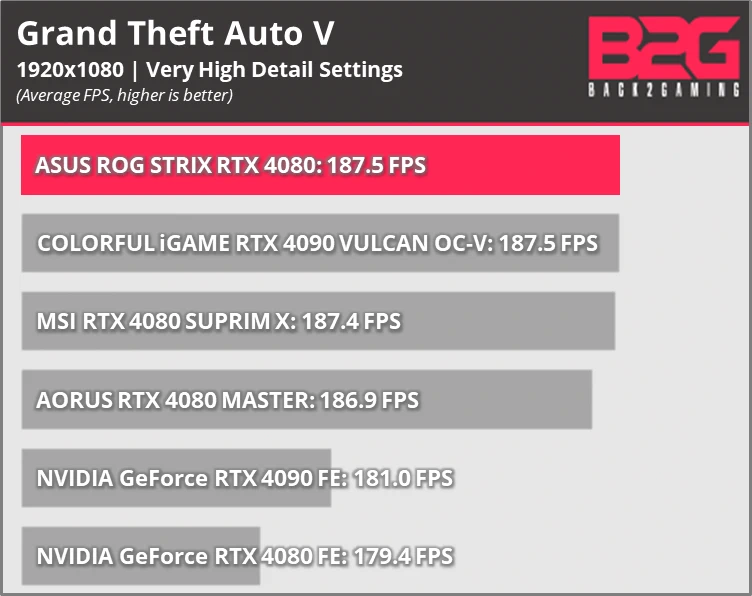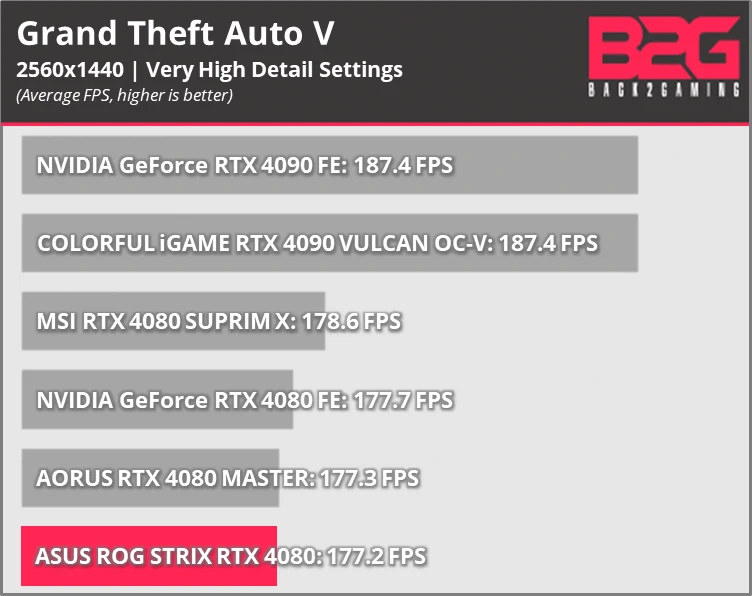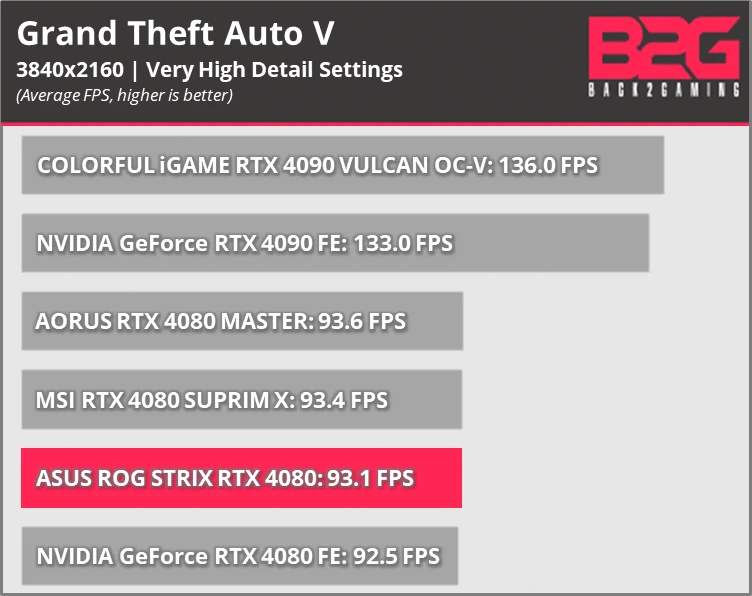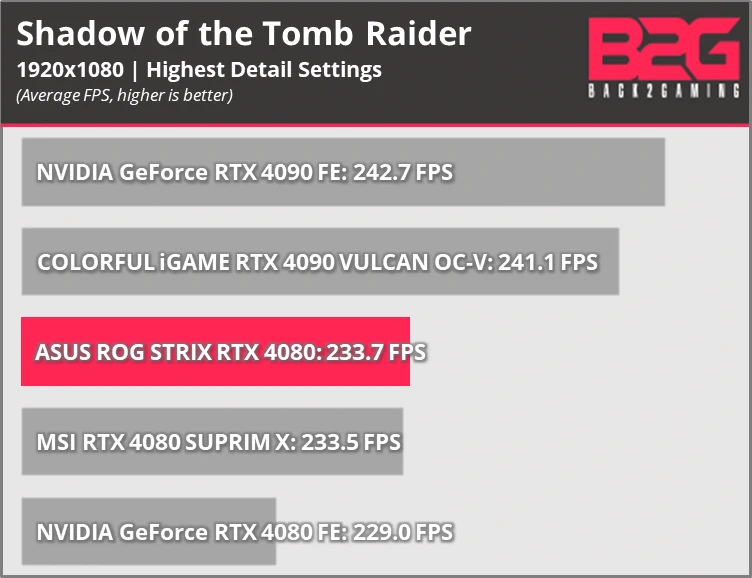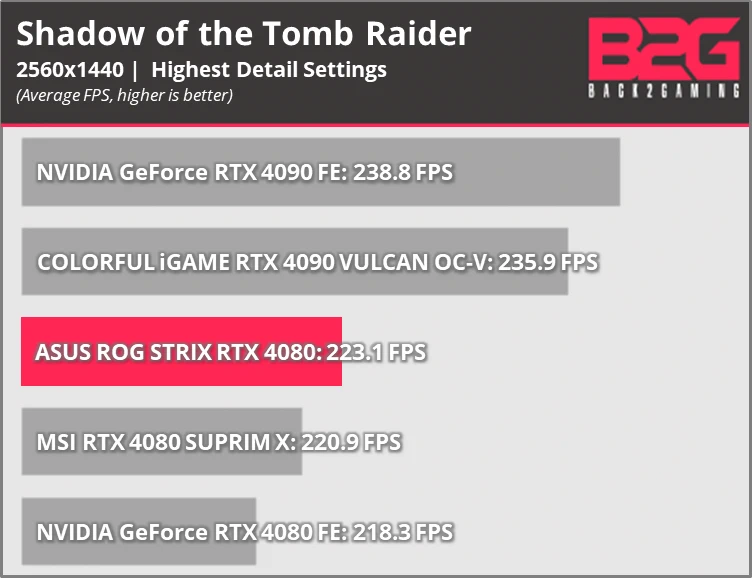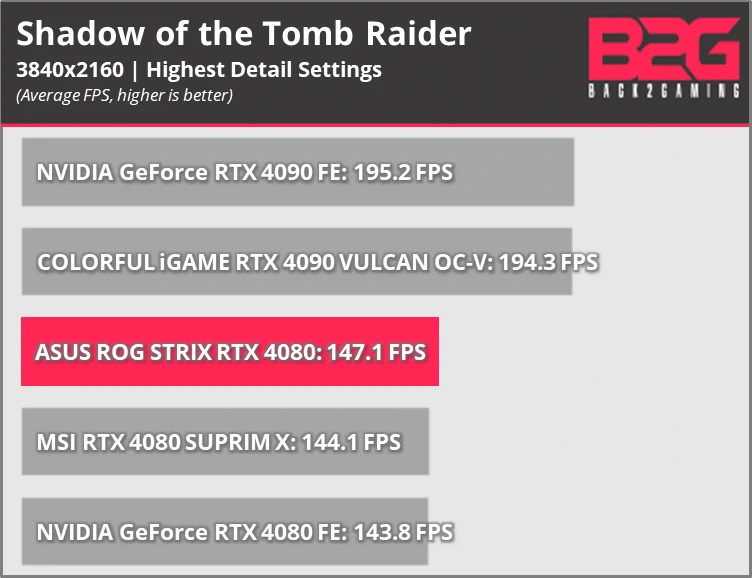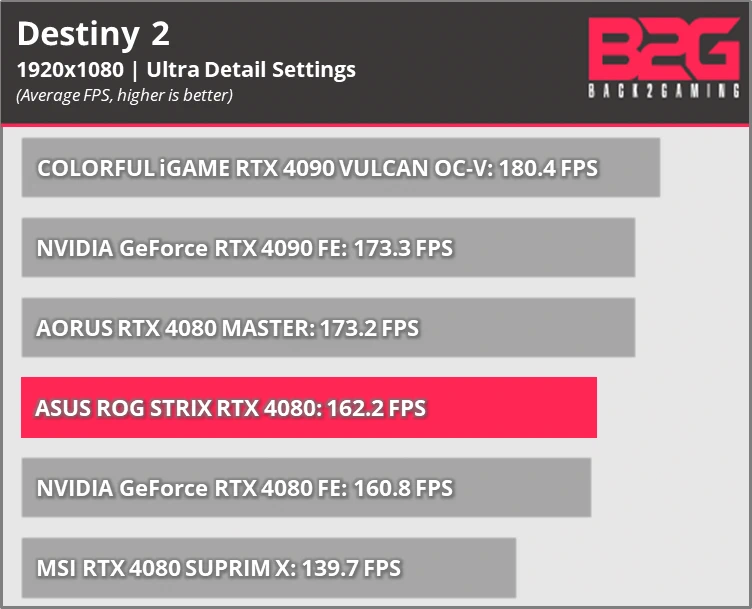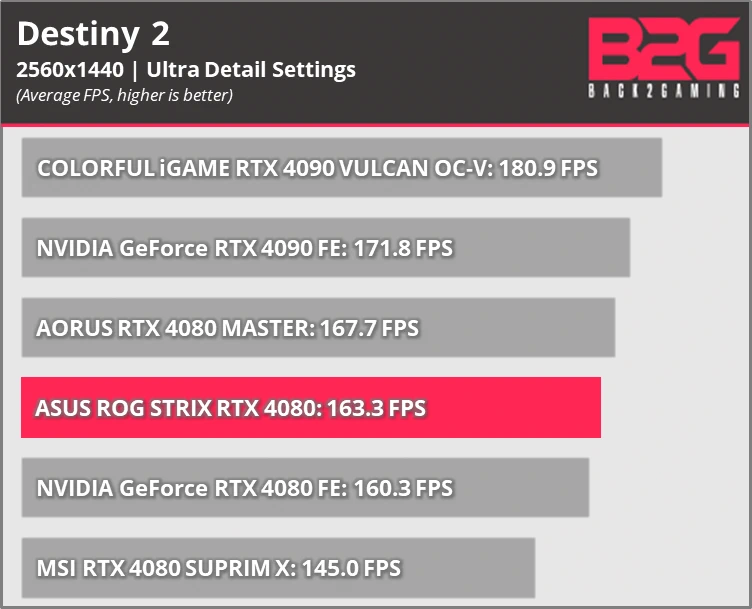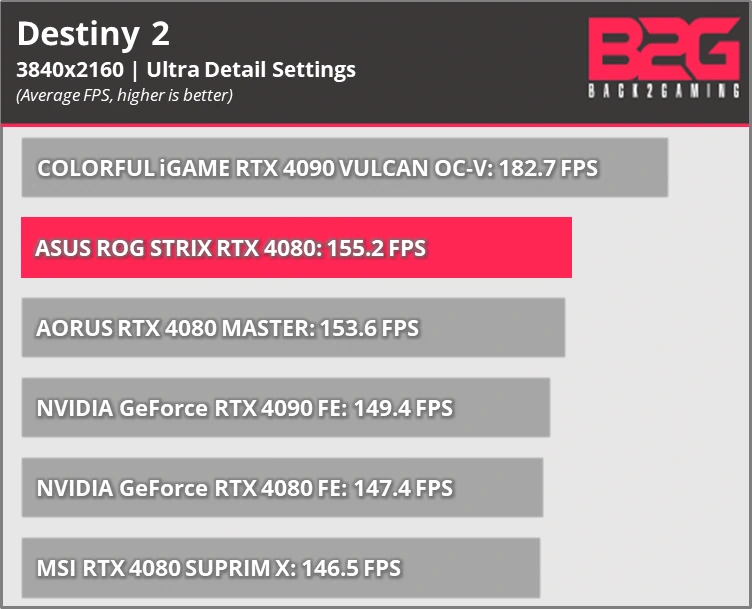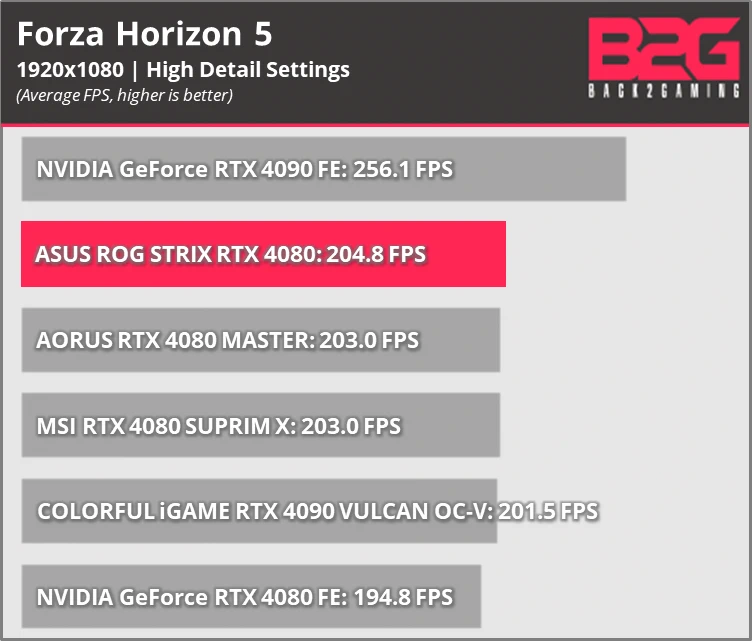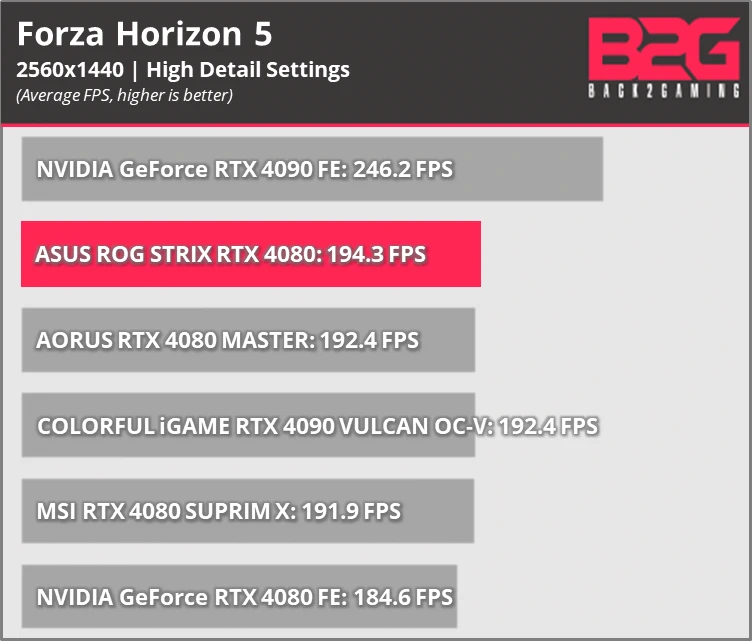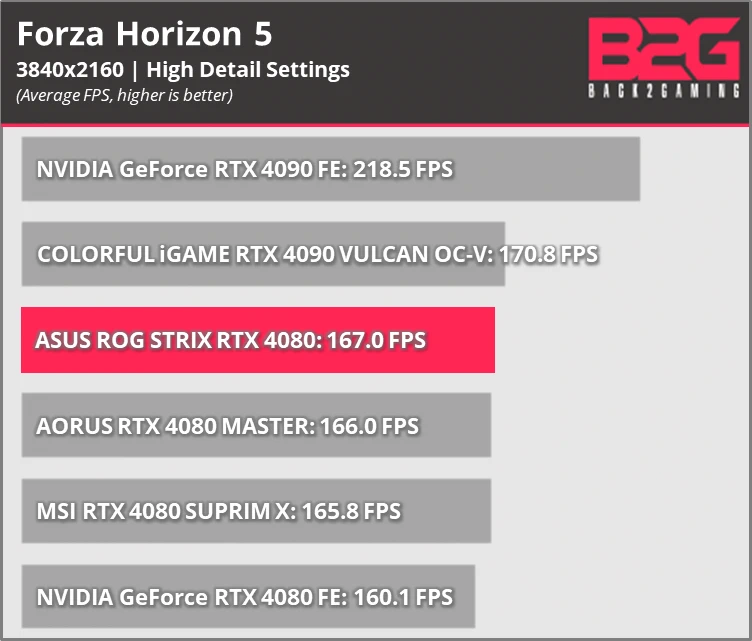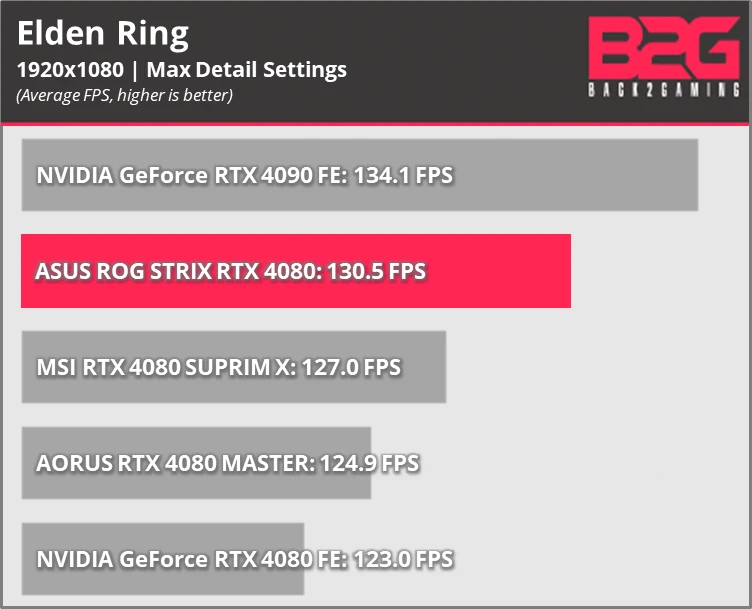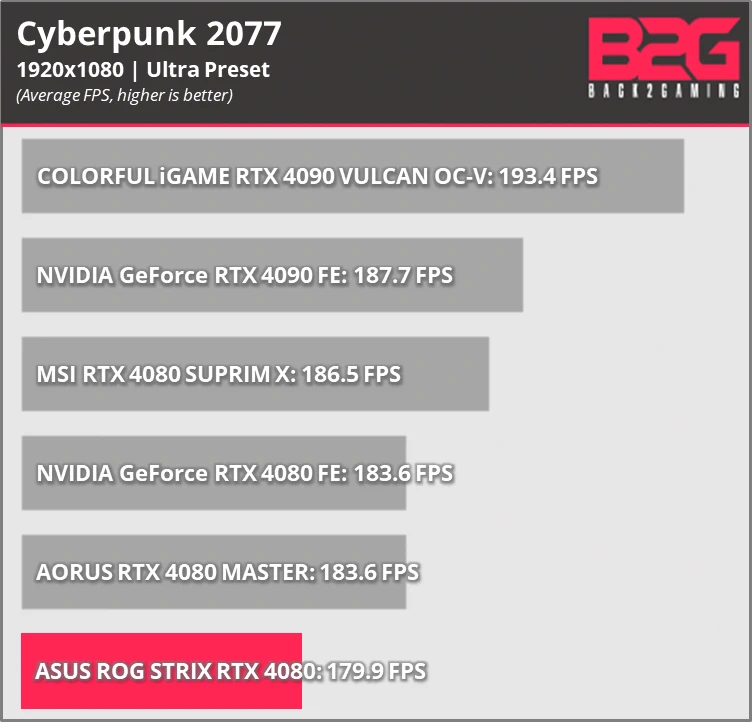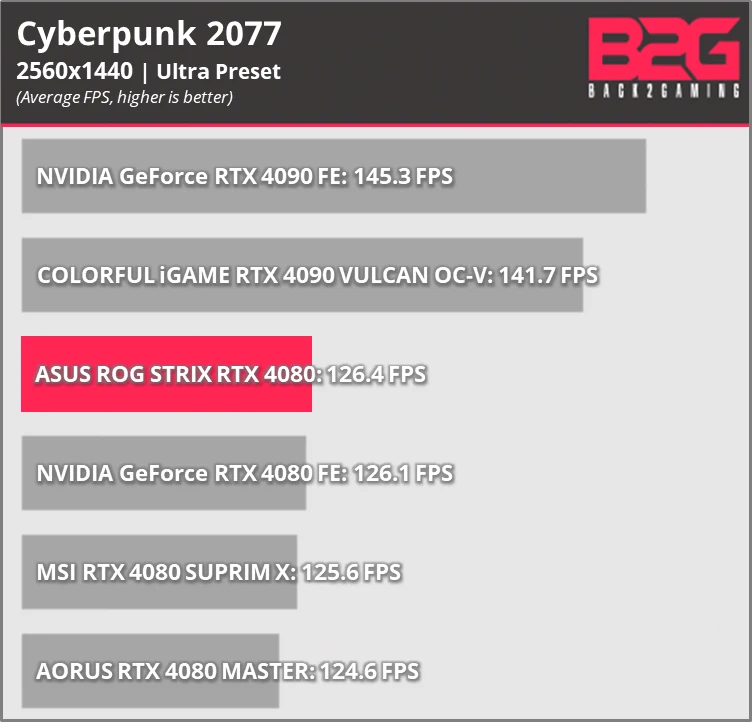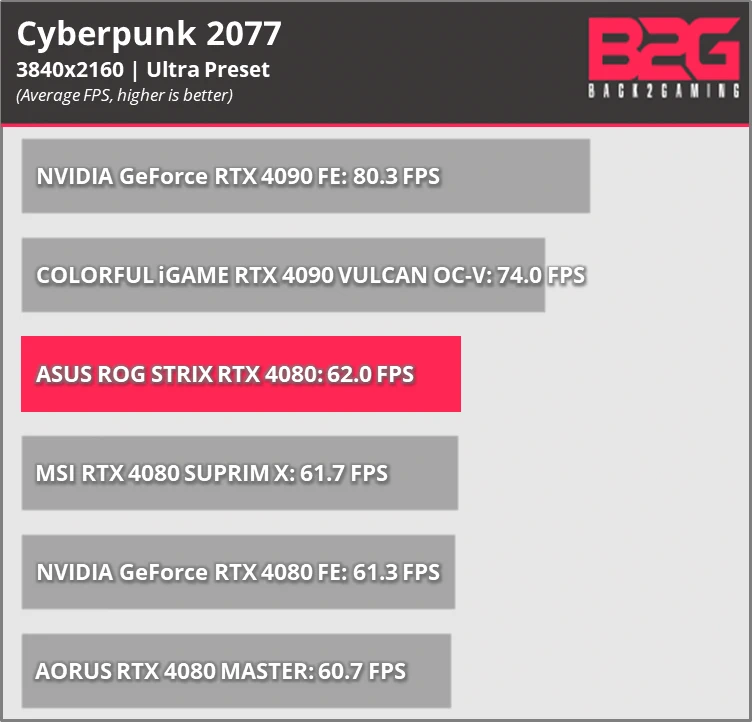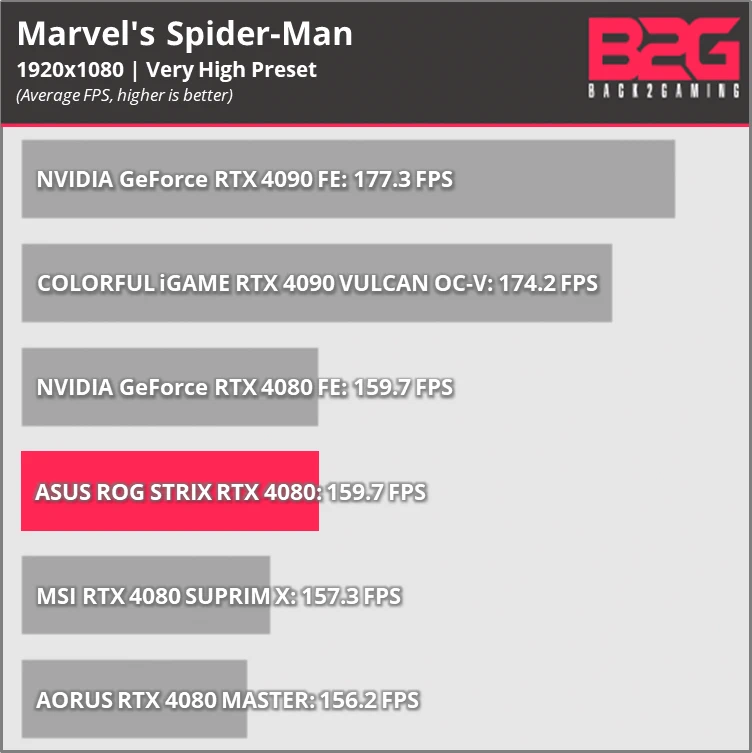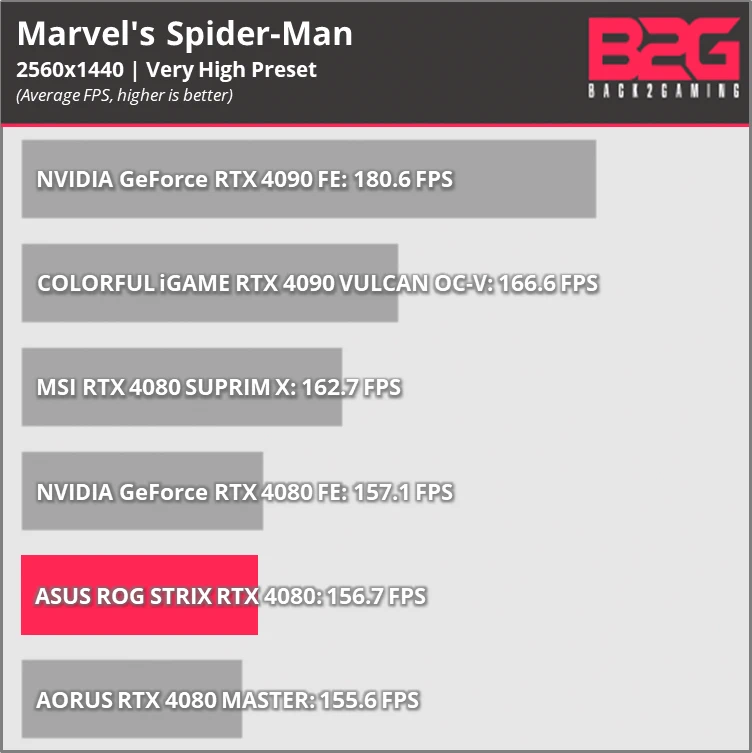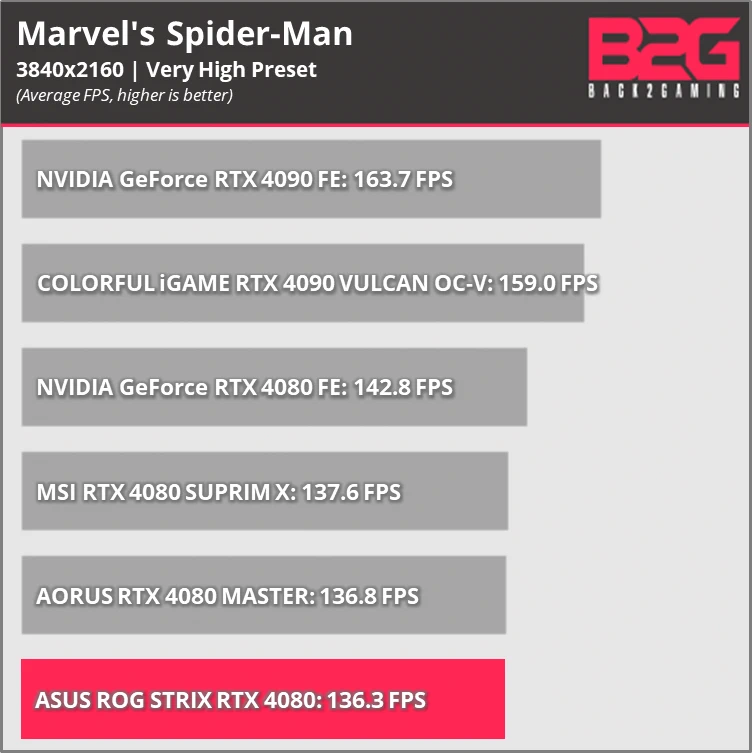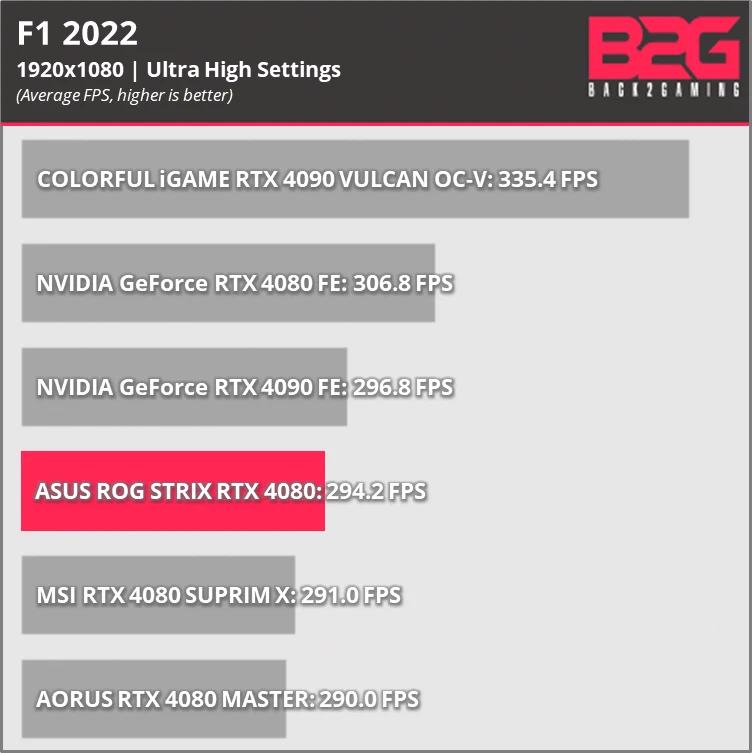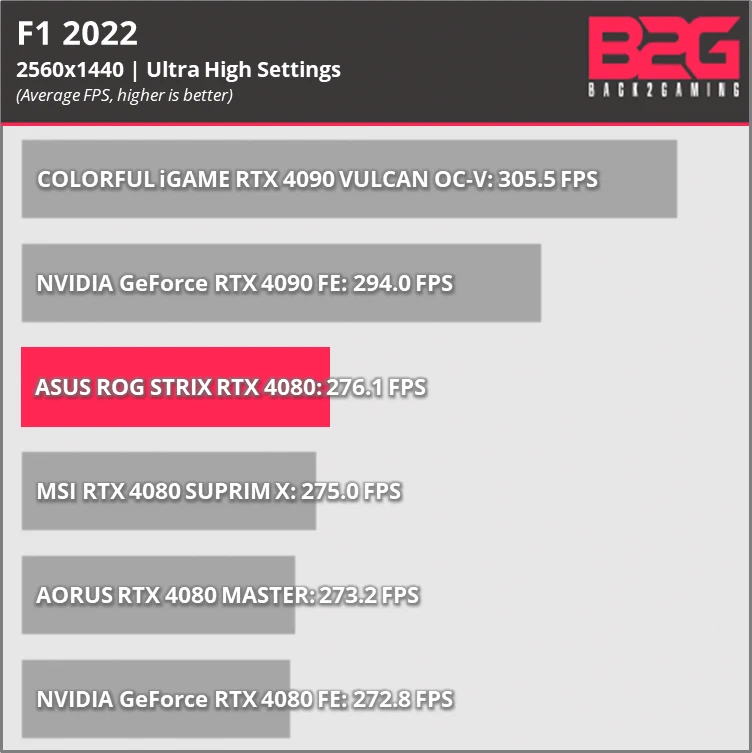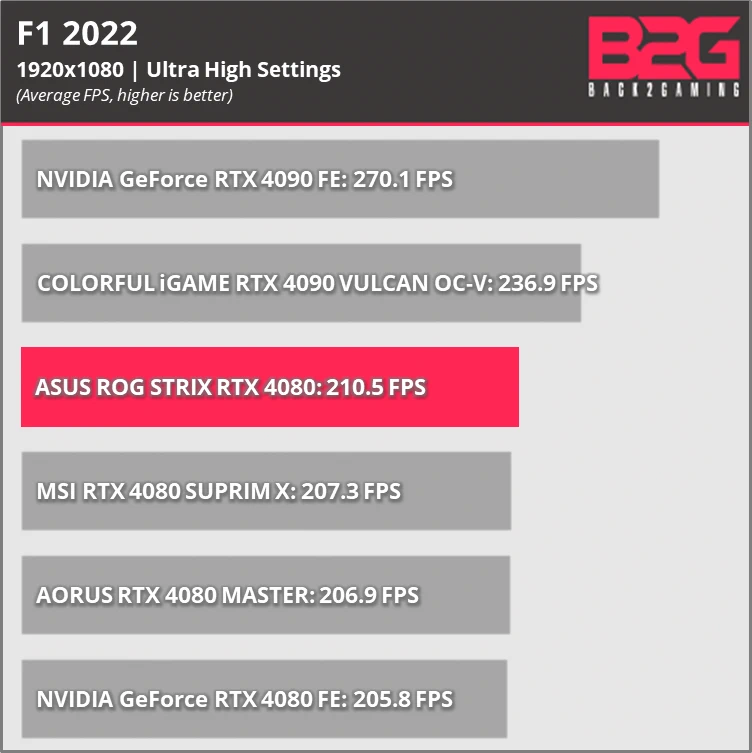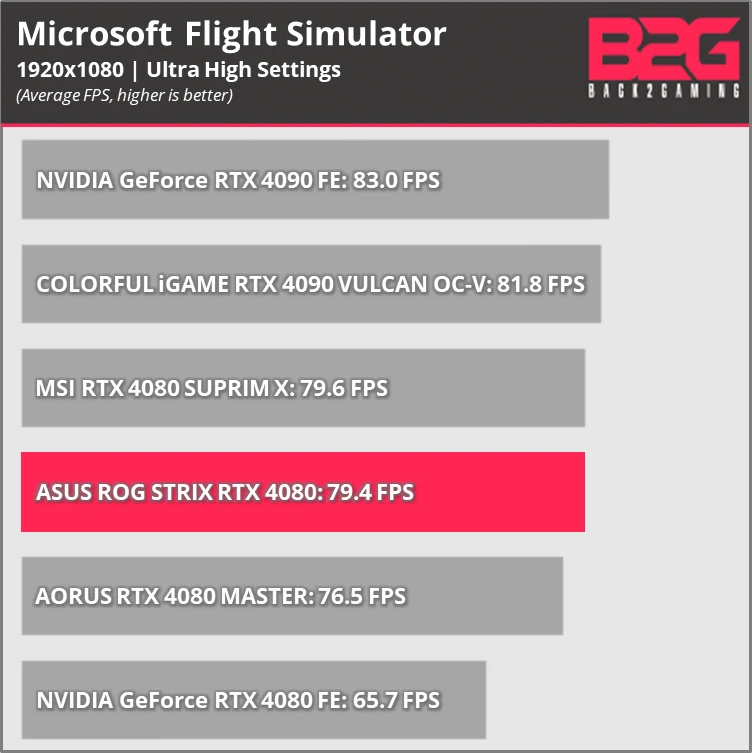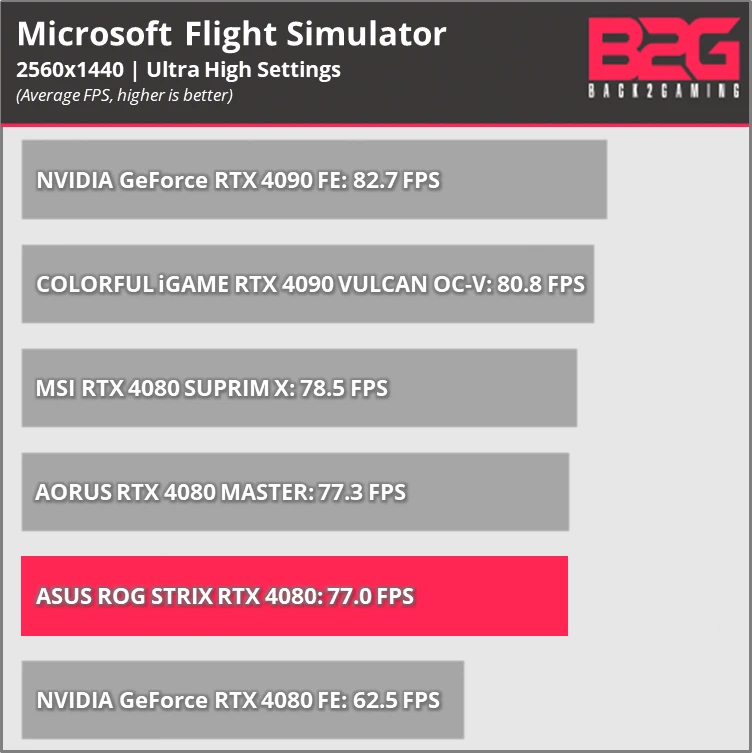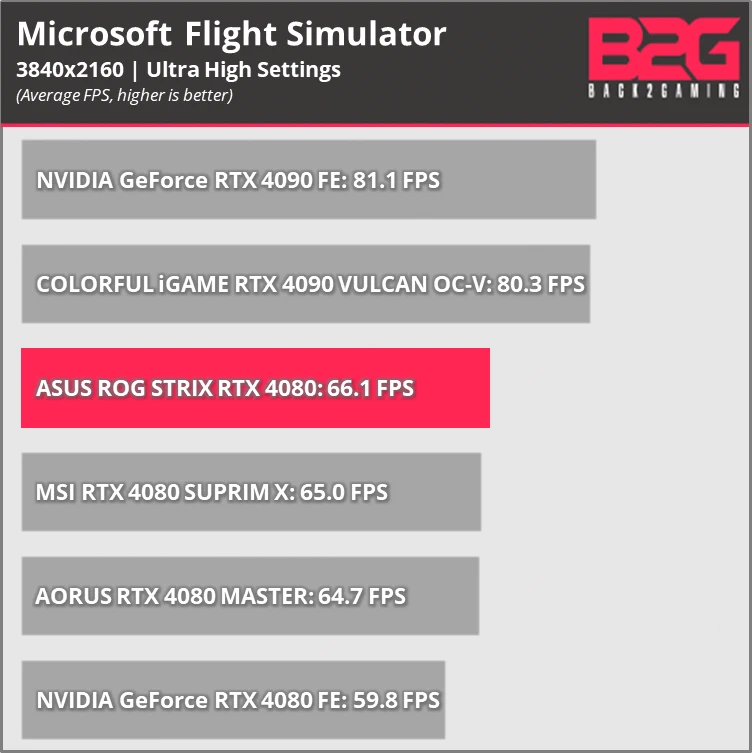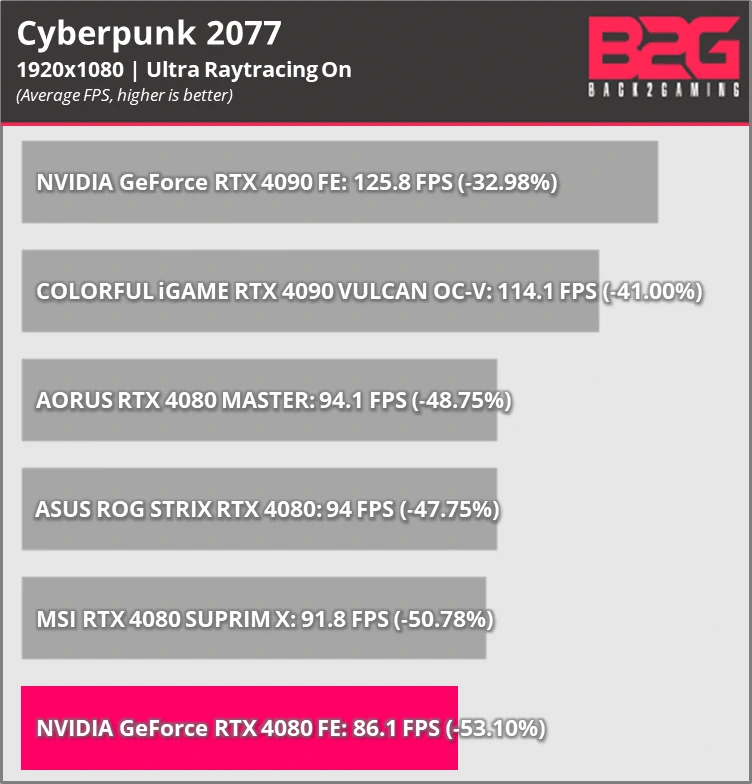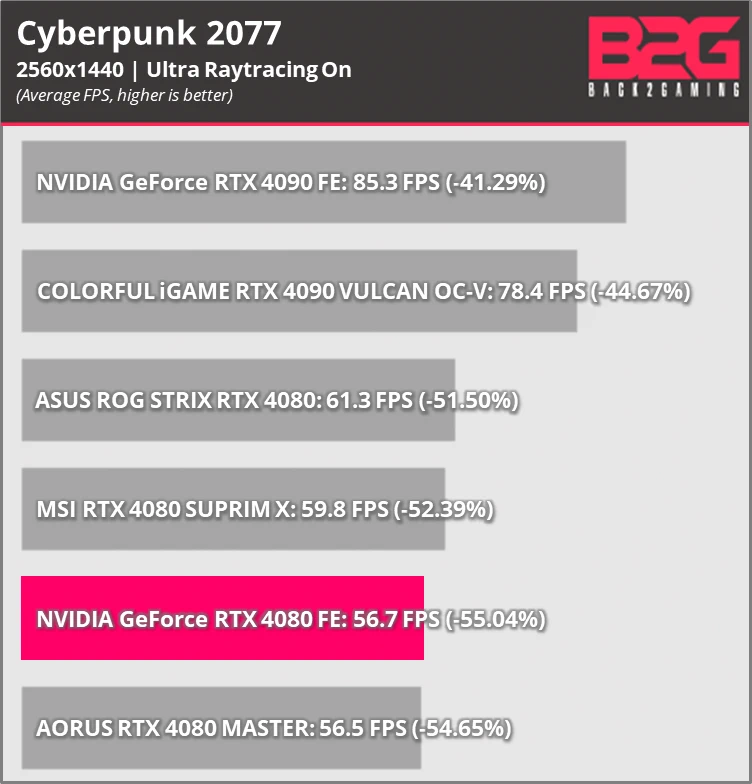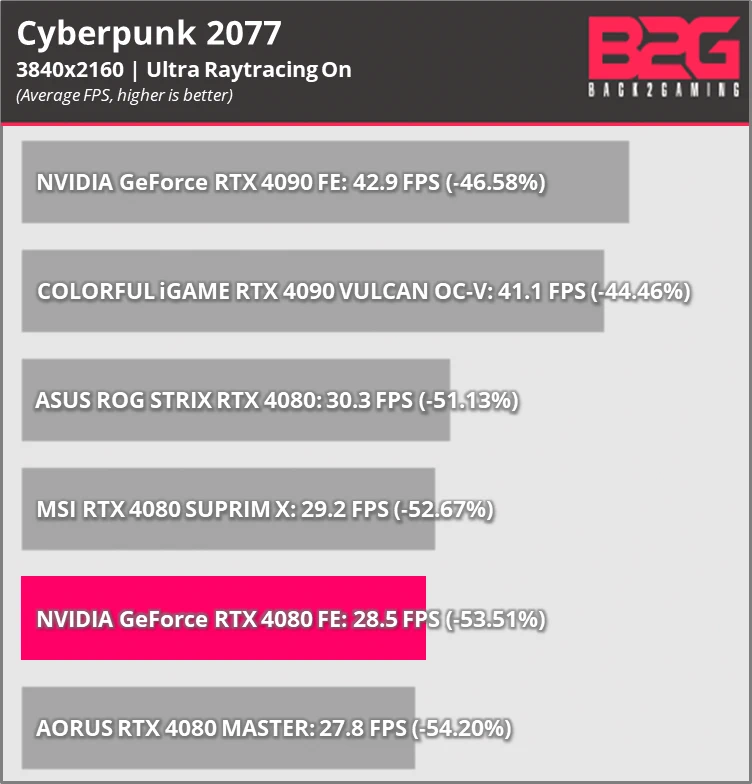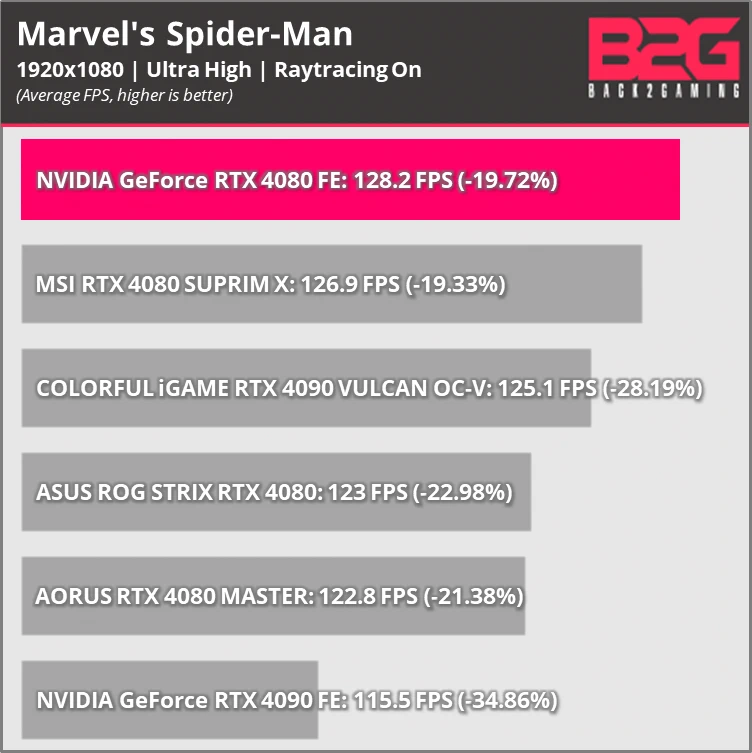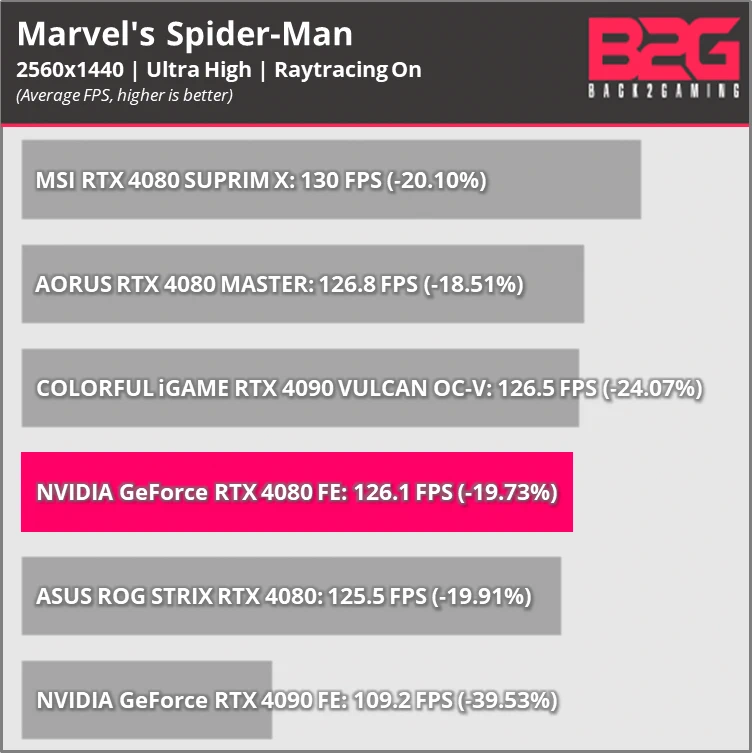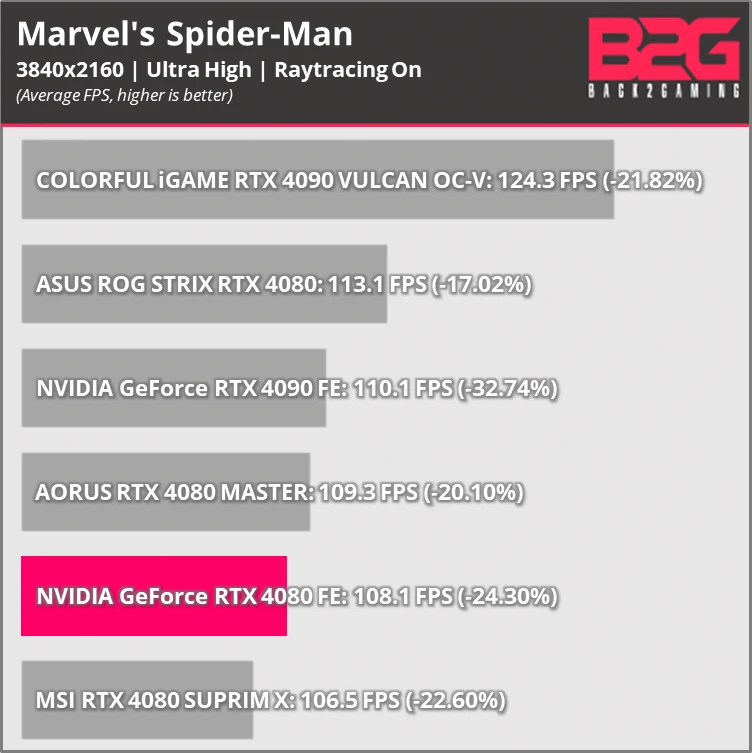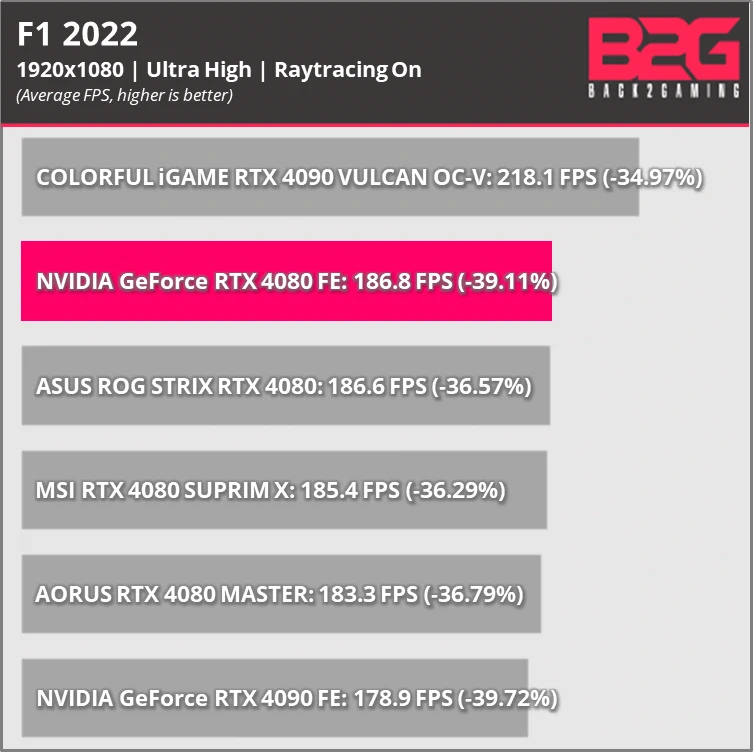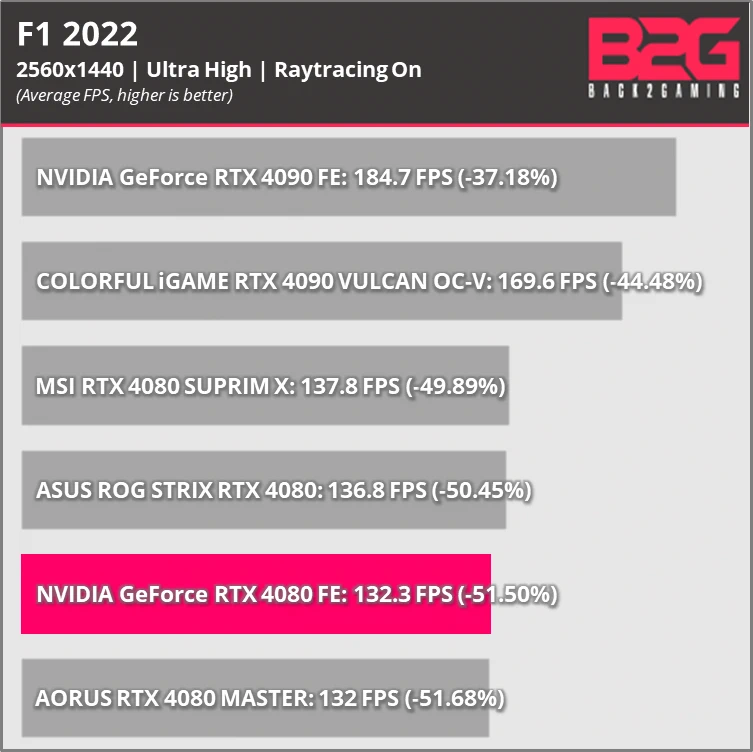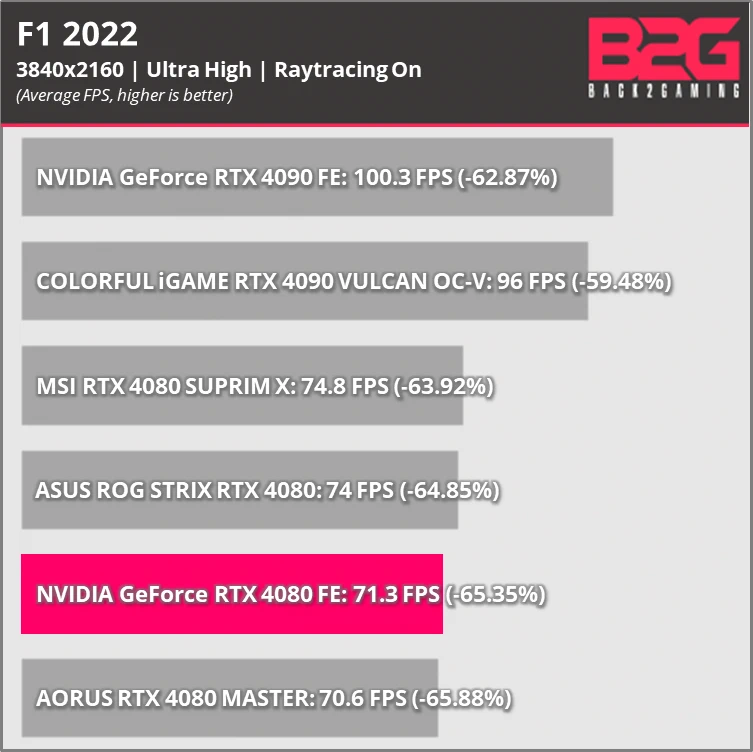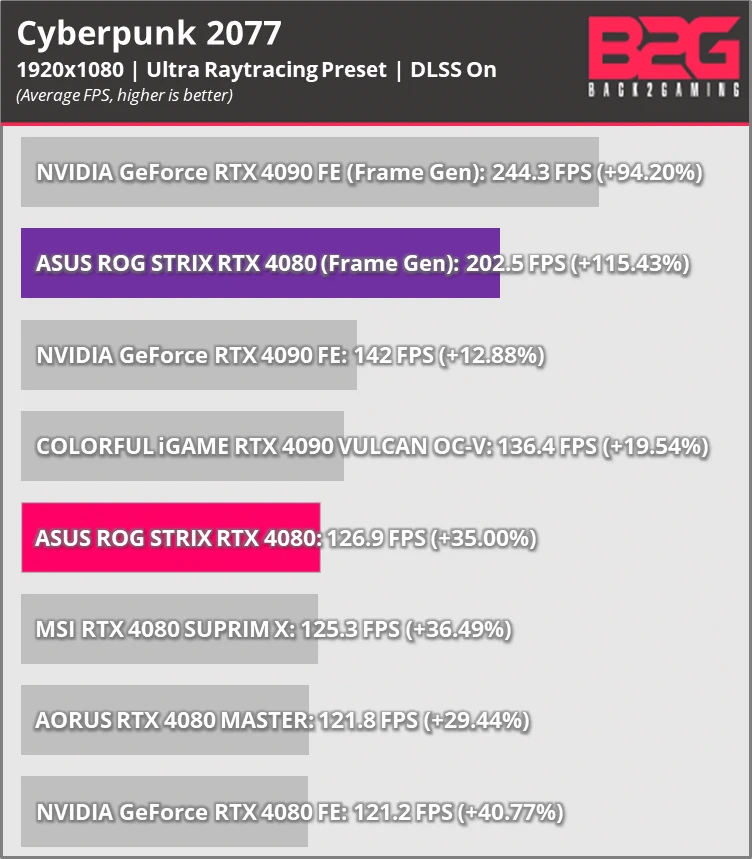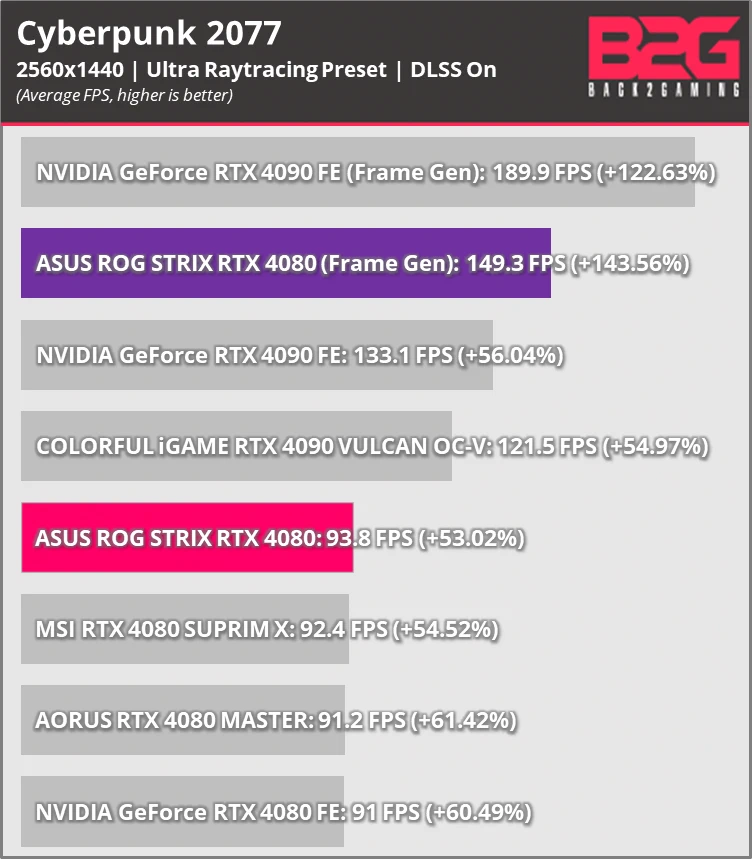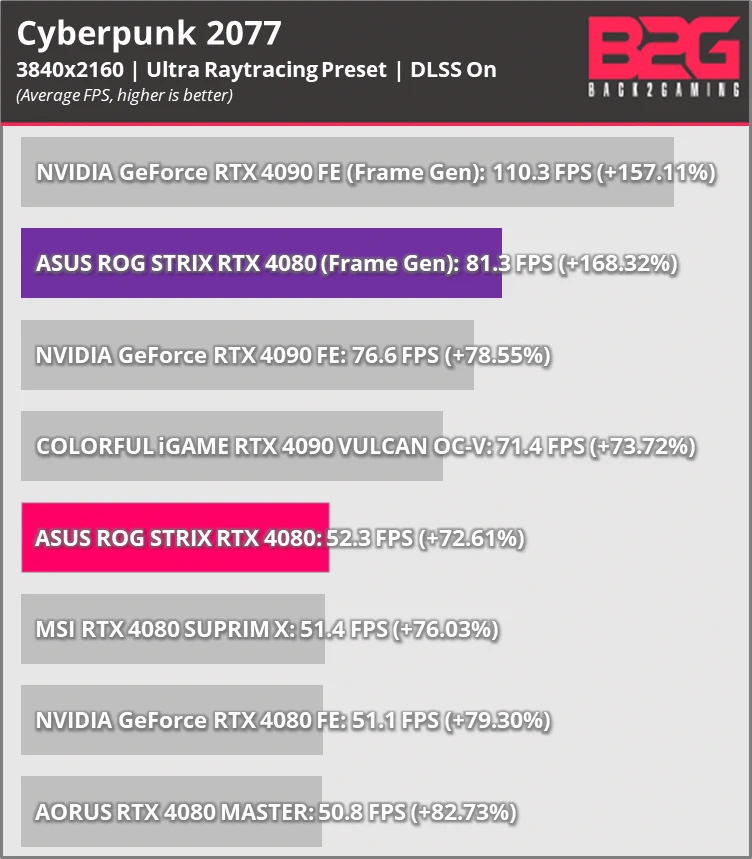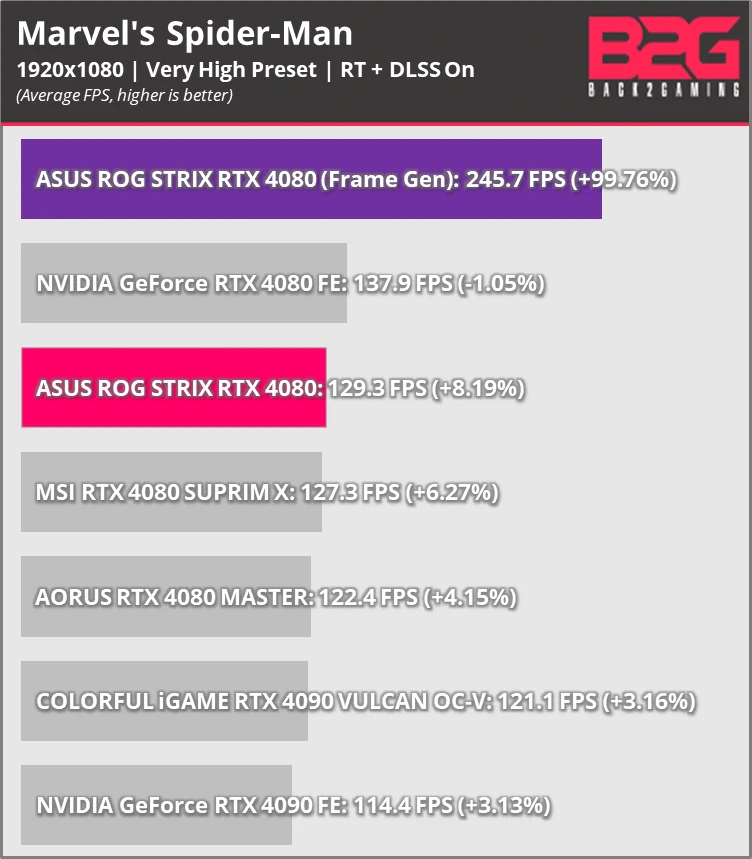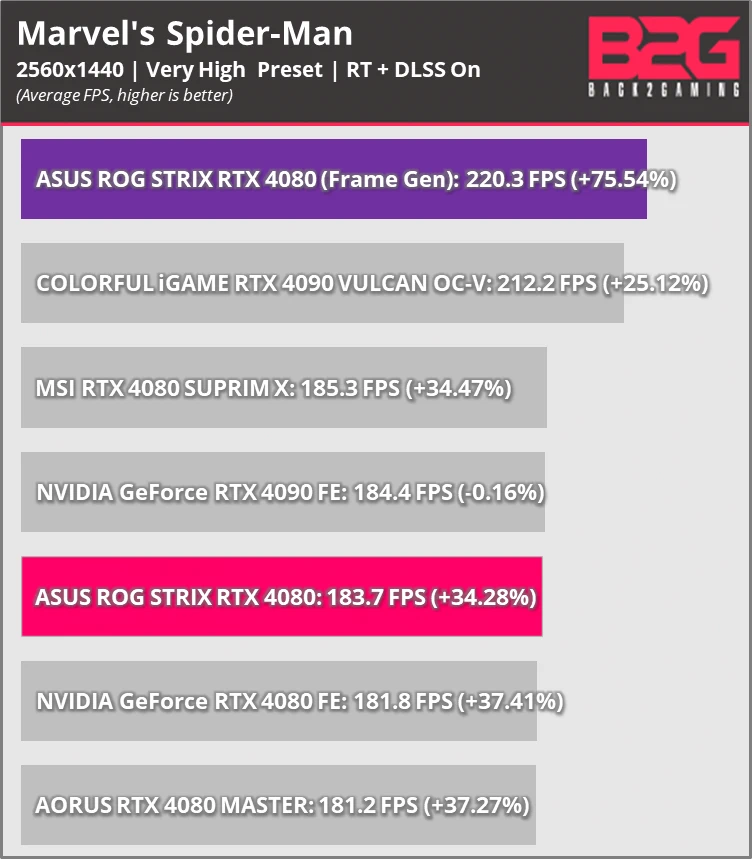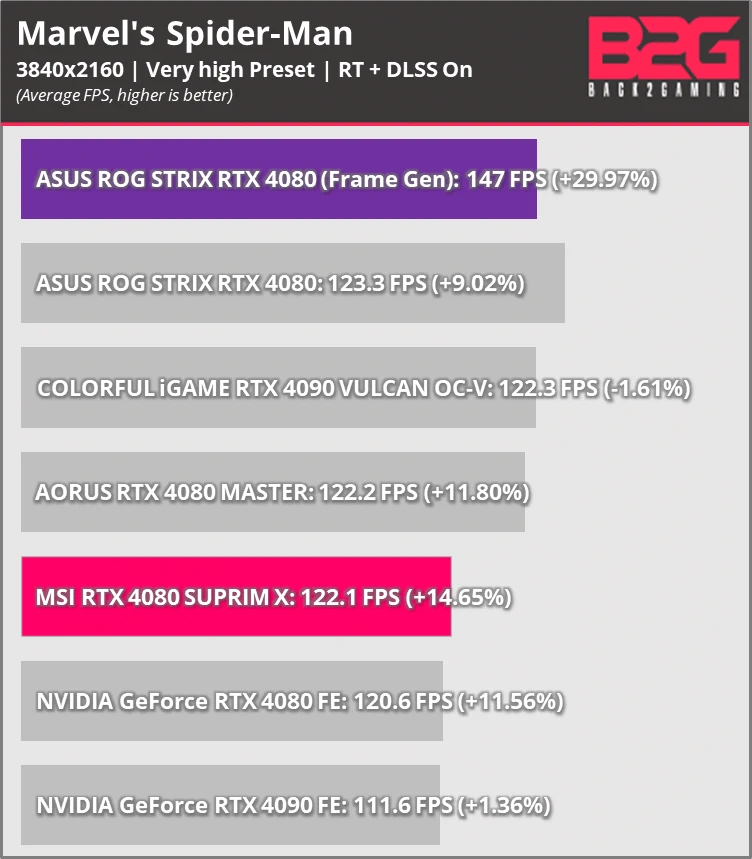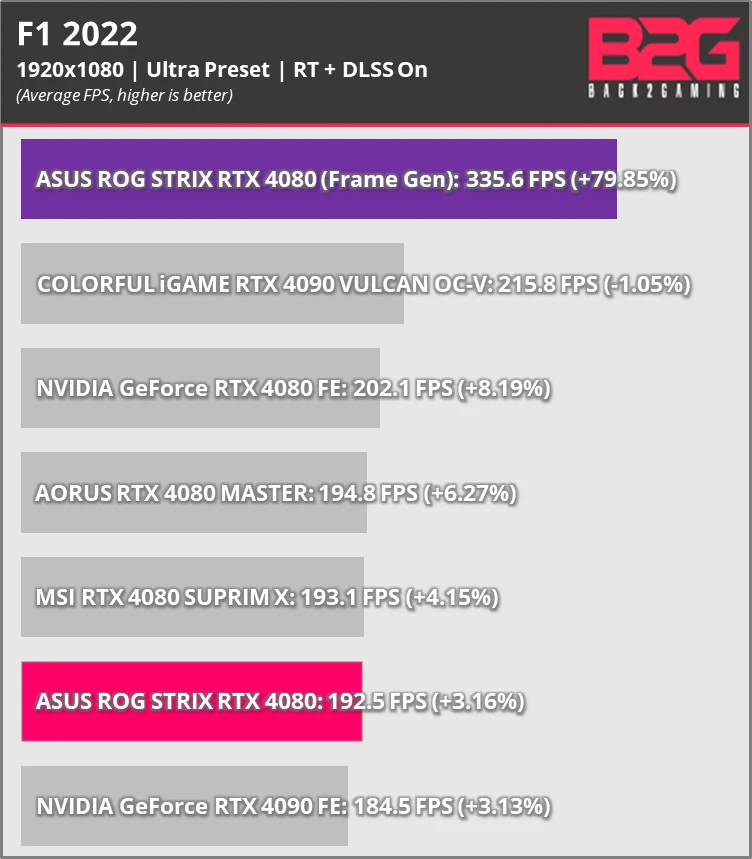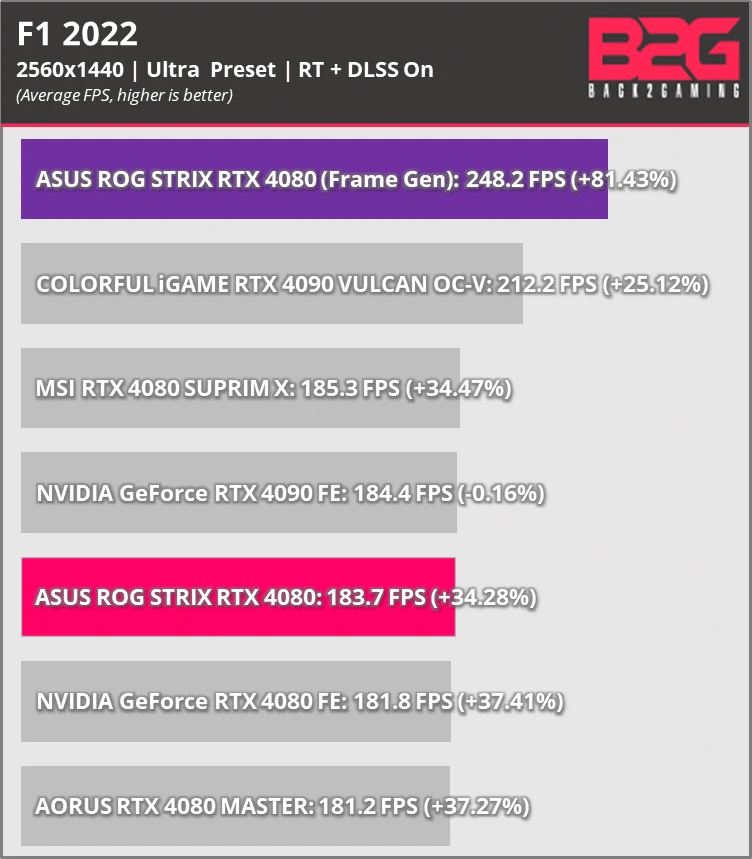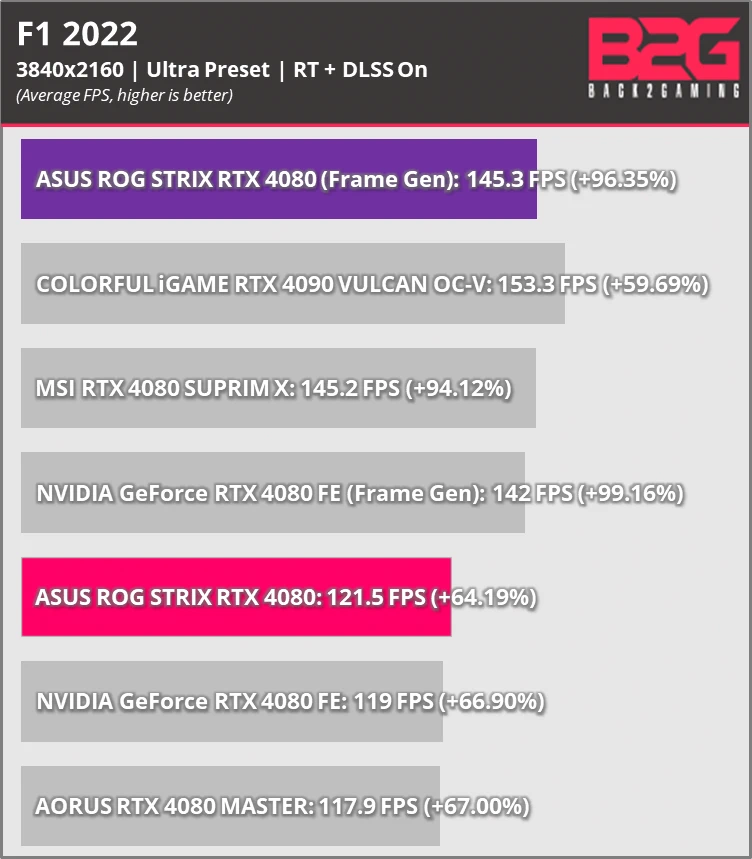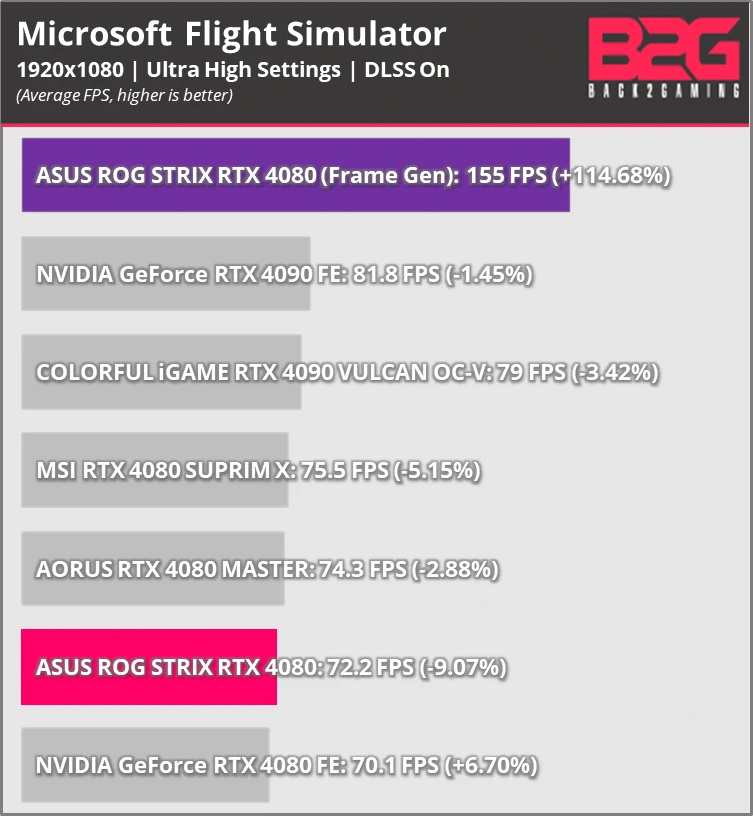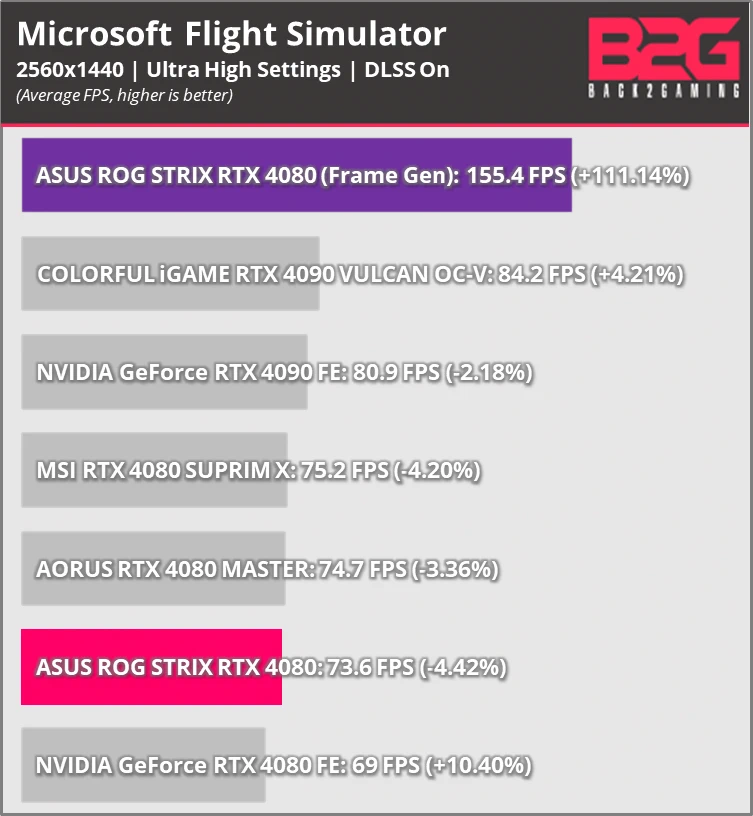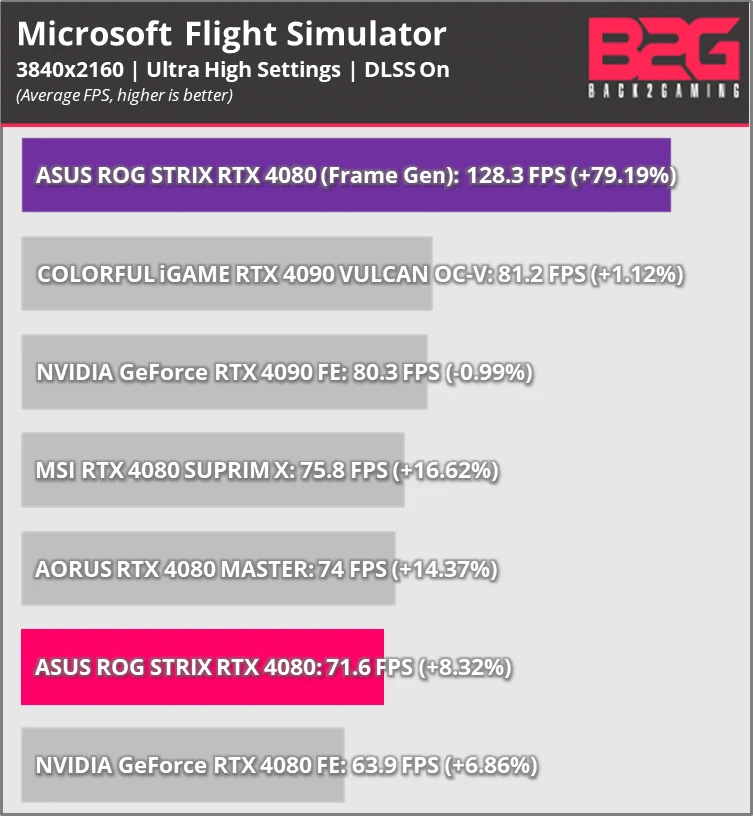Introduction
Today we’ll be taking a look at a group of GeForce RTX 4080 graphics cards and this article will focus on the much coveted ASUS ROG STRIX RTX 4080 OC Edition graphics card featuring a new style cooler that leaves the old 30-series design, this new style cooler features a large heatsink with a blue and red metal ornamental plate along the shroud which brings a touch of old-school ROG.
Based on NVIDIA’s Ada Lovelace architecture and built on TSMC’s 4N node, the AD103 silicon of the RTX 4080 features 9728 CUDA cores and features 304 4th-gen Tensor (neural) cores and 76 3rd-gen RT cores. NVIDIA sets a 2505Mhz boot clock for the RTX 4080 with an 11200Mhz memory clock on the 22.4Gbps 16GB GDDR6X video memory. The RTX 4080 sees a large difference in overall specs against the RTX 4090’s large 16384 CUDA core but keeps video memory fairly close with 16GB but is wired on a narrower 256-bit bus. NVIDIA announces that the RTX 4080 will start at $1199 and will go on sale starting today.
The ROG Strix cooler for the RTX 40 series doesn’t really have a name unlike the older DirectCU type coolers but ASUS is very adamant in their Axial-tech fans and vapor chamber. The 3.5x slot height cooler promises better cooling performance than previous generation coolers. Its unclear why NVIDIA is mandating these larger cooler designs for their partners but the RTX 4080 clearly doesn’t need to share the same size cooler as an RTX 4090 but alas, it is cheaper to manufacturer these coolers in larger numbers as 1 design than having variations that require a different assembly line.
The ROG Strix RTX 4080’s cooler comes in at 2.42kg. Its mass comes mostly from the heatsink as ASUS is proud to share their “compact” PCB design for this card.
ASUS includes a 3x 8-pin PCIe power to 12VHPWR 12+4 power adapter in the package as well as a support stand.
ASUS bumps up the HDMI count on the their ROG Strix RTX 4080 versus NVIDIA’s default of 3xDP,1xHDMI by adding another HDMI port which brings our output option to 5.
ASUS adds some extras with their card. Most noticeable is this pair of fan connectors so your case fans can be controller directly via GPU versus the traditional CPU controlled fans that would only rev up if your CPU is loaded which may not be the best scenario for some applications.
An OC and Silent BIOS switch is located on the side which allows users to switch between an aggressive fan curve for gaming as well as a more tame BIOS for silent operation.
I mentioned something old-school in the opening and just to expound on that, ASUS has pretty much dropped colors on their ROG Strix designs many years ago except for the RGB lighting. This is the first time that hard material that is not RGB has received the color treatment from ASUS with the metal design plates adding a streamer style blue/red fade to the heatsink shroud.
Product Gallery – ROG Strix RTX 4080
Architecture and Technologies
NVIDIA’s RTX 40 launch highlight particularly focused on a multi-pronged approach. NVIDIA is laser-focused on capturing the entire gaming ecosystem and Ada Lovelace is their jumping off point in encroaching into the large part of markets endemic to gaming and multimedia creation.
The RTX 40-series are still gaming cards first and foremost and their gaming horsepower comes mainly from the new silicon. Ada Lovelace is more of an efficiency refinement for Ampere which was built on Samsung 8nm and with Ampere looking to stay with us for a while, NVIDIA’s pricing structure pretty much confirms that with the RTX 4080 breaking the $600 price point that the NVIDIA xx80 cards sat at for the last 4 generations.
That brings us back to the architecture. NVIDIA is frontloading a lot of functionality for various industries with the RTX 40 series cards primarily the RTX 4090 and RTX 4080. While the raster engine remains practically the same, NVIDIA’s addiitonal fixed function hardware adds extra processing power for additional graphics rendering, particularly ray traced graphics.
Third generation RT cores found on RTX 40 graphics cards include acceleration for math-heavy functions such as bounding-volume hierarchy which is used in dictating how rays interactive on objects and what their defined limits are. Traditional BVH is very precise and takes up a decent amount of computational power but thanks to NVIDIA’s Displaced Micro-Mesh engine, BVHs can now be represented as coarser sets of triangles versus the traditional finer geometries required by older generations.
Opacity Micro Mesh is another NVIDIA technology utilizing 3rd-gen RT cores which accelerate alpha channel object shading. OMM isolates non-alpha areas and reduces pipeline workload by focusing on alpha objects only.
DLSS3 is perhaps the most talked about feature of the RTX 40 series which introduces Frame Generation. With Frame Generation, RTX 40 cards can insert extra frames between every 2 frames on top of DLSS upscaling. This is also performed by the Tensor cores leaving the the raster cores and RT cores free to deliver the RTX 4090 and RTX 4080’s performance targets which ensures Frame Generation works at its best frame rates.
Despite being simple on paper, Frame Generation is limited to the RTX 40 series for now as it requires optical flow acceleration found on RTX 40 cards. This feature is required to allow the GPU to know what object is moving and which aren’t which lets it precisely map out its next potential frame. As inserted frames will not be interactive, NVIDIA Reflex plays a vital role to keep input latency in-sync with actual frames with Reflex markers denoting key frames in the pipeline.
All these technologies are further expanded into other applications as DLSS3 will see it put into action in OBS capture for 4K 120 capture. This is also extends to the RTX 40 series native support for AV1. AV1 is an emerging format for video which allows lower bitrates but with better quality. NVIDIA RTX 40 series cards support acceleration for both encoding and decoding of AV1 videos with support coming for platforms such as Discord and Youtube as well as encoding support for popular software like Adobe Premiere Pro and BlackMagic Design’s Davinci Resolve. Support for AV1 encoding via NVENC will also allow streamers to utilize their system more without adding workload to their GPU, removing the need for dual PC capture systems on supporting systems once support for AV1 arrives on popular streaming software like OBS.
Further utilization for RT cores can be seen on partner RTX Studio software that can take full advantage of the faster performance of NVIDIA RTX 40 series cards. This in turn can help those in the gaming modding scene with NVIDIA’s RTX Remix. RTX Remix is a modding tool that can easily take classic game titles and apply raytracing onto them. NVIDIA’s demo for this is Portal RTX which should arrive soon and we’ll talk about RTX Remix in another article.
Power Draw, Clock Speed and Temperature
We start off by testing how high our GPU clocks go as well as how much power our card uses. We run Final Fantasy XV 4K benchmark for this test so that users will have an idea what kind of usage behavior they can see from these cards.
Given that most cards will boost all the way to their highest potential, the numbers we see here should be a good indicator of what to expect from these cards in general. Results are captured via PCAT that captures card-only power draw with no approximation.
Idle temperature and power draw is captured on a 1080p monitor at idle. Gaming workload readings is a combination of the cards running temperature and power draw during benchmarks.
Idle Temperature and Power Draw
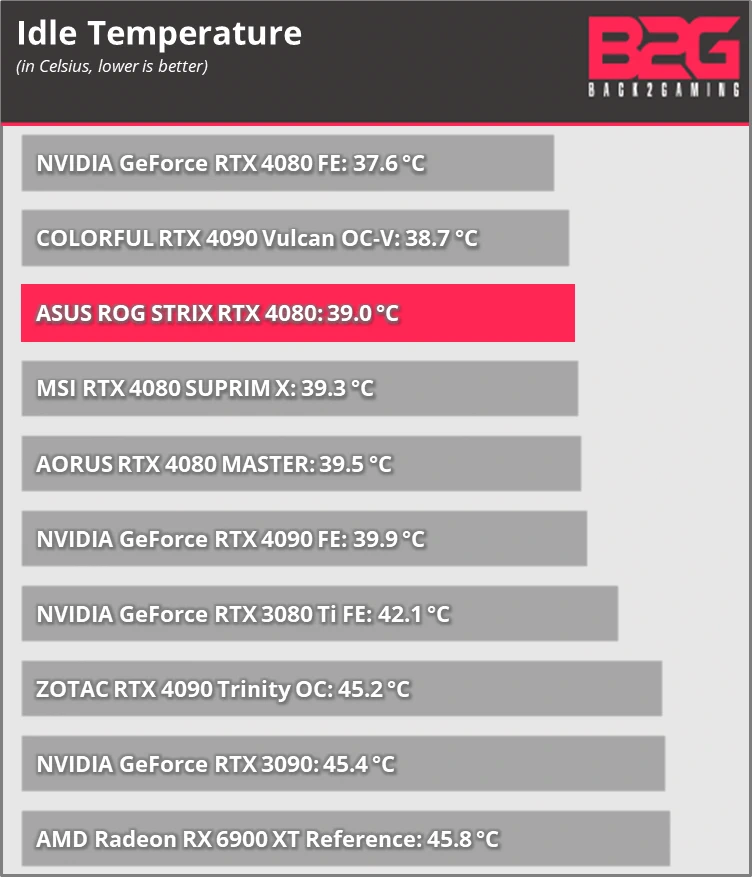
Gaming Temperature and Power Draw
Encoding and Studio Performance
As stated, NVIDIA introduces acceleration for some creator applications as well as accelleration for AV1 encoding. Here are some general benchmarks for some of these applications. These results will apply to partner cards with slight increase or decrease depending on performance. We’ve included a partner card to show you the variations.

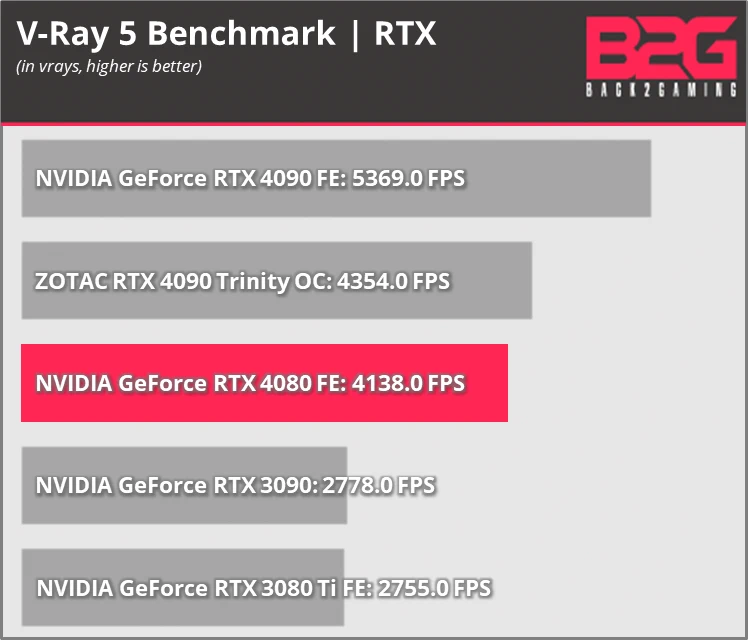
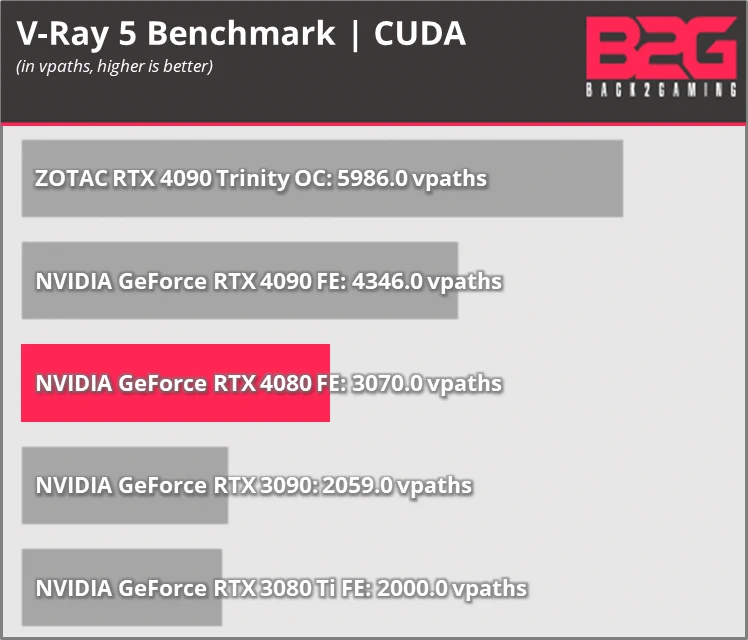
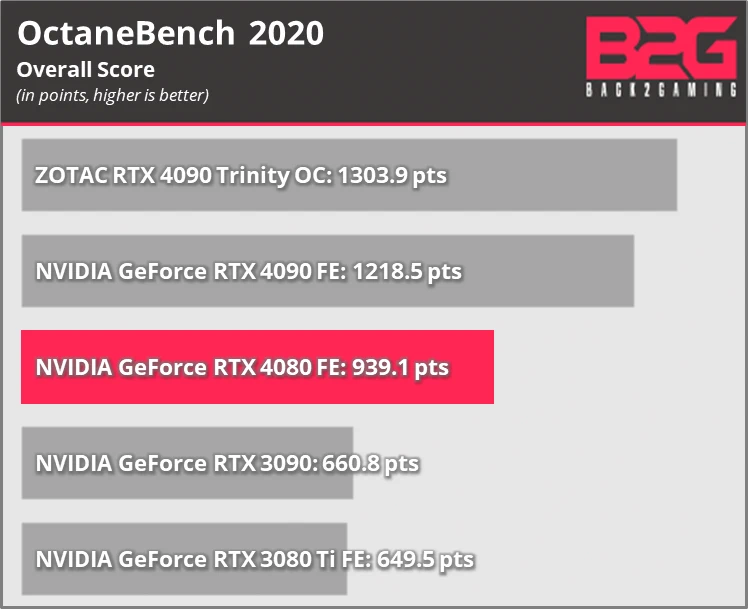
Test Setup and Methodology
Processor: Intel Core i9-12900K
Memory: G.Skill TridentZ DDR4-3600 32GB
Storage: Kingston FURY Renegade 2TB SSD
PSU: FSP Hydro G Pro 1000W
Cooling: ROG Ryujin II 360 AIO Cooler
Monitor: ROG PG27UQ 4K 144hz HDR1000
VGA: Listed
For a full-hardware workout, visit https://benchmarks.ul.com for our system warm-up and stress test of choice.
For benchmarking methodology please see our game benchmark method guide.
Test results are gathered and produced on CapFrameX. This makes it easier for use to get both line graph comparison and raw averages without extra tools. Simply the easiest tool for benchmarking and its available for everyone to use, free of charge. Check it out at capframex.com.
Since this is a GPU review, we benchmarked the area of the games that put heavy load on the GPU.
All our test runs are repeatable, click the links below for area and details. Read our benchmarking methodology.
- Counter-Strike: Global Offensive: FPS Benchmark Workshop Map
- DOTA2 – The International Main Event – Day 6: T1 vs PSG.LGD Game 2 (48:00) – The 10-Man Buyback Fight
- Rainbow Six: Siege – Benchmark Mode
- PUBG Battlegrounds – Custom Scene
- Call of Duty: Modern Warfare 2 (2022)
- Valorant
- Grand Theft Auto V – Palomino Highlands
- Shadow of the Tomb Raider – Kuwaq Yaqu
- Destiny 2 – The Tower
- Forza Horizon 5
- Elden Ring – Custom scene, FPS cap removed, offline
- Cyberpunk 2077 – Little China, noontime
- Marvel’s Spider-Man – Empire State area
- F1 2022 – Bahrain, night time
- Microsoft Flight Simulator – Landing mission, YSSY
See our Youtube playlist for benchmark sequences.
Note: Some proprietary technologies of NVIDIA like PCSS, HBAO+, and HairWorks work on AMD GPU’s BUT to maintain uniformity amongst GPUs, these have been turned OFF.
You can click on any of the benchmark charts enlarge. You can also move forward and backwards to quickly navigate through our charts via gallery view. For this test, only the out-of-box normal mode will be tested.
Kindly let me know if you spot an errors in the charts. I do my best to keep them error free but while test results are reliable and accurate, bringing them over to Excel and relying on formulas to generate the reports sometimes can cause mix-ups.
Notes:
- All data are gathered from exactly the same system, with exactly the configuration we list here. No data is reused from another system or from any variations of. We gather data from only one system as indicated here.
- Graphics cards are allowed to heat up prior to benchmarking. Cooler graphics cards may boost higher than normal.
- Following up on the above, we try to enjoy the game and play a bit before proceeding to the actual benchmark scenario. This allows us to detect any other problems like stuttering, frame skipping, or any other problems.
- Games that receive graphical updates that affect performance e.g. (DOTA2 moving from DX9 to DX11) will be retested completely.
Please take note that we are rebuilding our GPU review database starting with the RTX 40 series.
Counter-Strike: Global Offensive (CSGO)
Counter-Strike: Global Offensive, popularly known as CSGO, competes for Steam’s most popular game. It has found a resurgence in its popularity and has recently peaked in 2020 in the number of players that play the game. Based on Valve’s Source Engine, the game received major asset overhauls during the years since its inception nearly 10 years ago. Still, it’s a light game and can be played on fairly lighter systems but the competitive scene for CSGO has seen average players demand high FPS from their systems thus gaining favorable standing with GPU vendors just from the demand for higher FPS alone. CSGO is a game that can easily go past 500FPS on enthusiast systems on maximum settings. We’re including CSGO as requested by our community.
API: DirectX9 (default)
Maximum In-Game Settings
Texture Streaming Disabled
Vsync OFF
DOTA 2
Note: JUNE 2020 – DOTA2 has recently implemented a transition from DirectX9 to DirectX11 and new install of the game will prompt users to switch from DX9 to DX11. With that said, we are testing DOTA2 in DX11 from now on.
In contention for the most popular game on Steam and the biggest competition in eSports: DOTA 2 is powered by the Source 2 engine. The game is fairly light on low to medium settings but maxed out, with heavy action on screen especially during clashes, can really stress most systems. This is a game where frame times matter as responsiveness is very important in high-stakes competition. We’re looking at consistently low frametimes in this game for the best experience
Our test uses actual game replay, using the segment from game 2 of PSG.LGD versus T1 during Day 6 of the Main Stage. The clash during the 48:00 where we see a drawn-out fight which sees both team expending all of their buybacks to secure this clash.
You can watch the replay of the actual game used in the benchmark in your Dota2 client. You can browse the TI10 replay files to see the actual match. You can download it for your own reference. (save it to your DOTA2 replays folder)
API: DirectX11 (default)
Best-Looking slider setting (Ultra)
FPS_MAX 0
Vsync OFF
Rainbow Six: Siege
Nearly 4 years later and Rainbow Six: Siege has become a phenomenon after a lukewarm beginning. The massive shift in focus of the game sees it stepping into eSports territory and the excellent mix of gameplay mechanics, good design and a dedicated dev team has put R6: Siege in a position it couldn’t even picture during launch. Rainbow Six: Siege focuses heavily on tactical and creative gameplay and its vertical levels and highly destructible maps encourage players to be quick on their feet so the action is always going. Powered by Ubisoft’s own AnvilNext 2.0 engine which powers some of Ubi’s recent visual masterpieces, R6:Siege also feature excellent graphics and can get very taxing at high detail settings. The game also features an Ultra HD texture pack download for those that want higher resolution textures but will of course demand more from the system.
API: DirectX 11
Ultra Settings
Anti Aliasing: TAA
Ultra HD Texture pack not installed
Ambient Occlusion: SSBC
Vsync OFF
The game automatically drops to 50% render resolution when Ultra preset is selected
PUBG Battlegrounds
Developed and published by PUBG Corporation, PlayerUknnown’s Battlegrounds now officially PUBG Battlegrounds, was an ARMA3 mod which has gained a massive global playerbase after being released as a stand-alone game. The game is now available for almost all platforms from PC to mobile but PC has been the definitive edition of the game. The game has evolved much since its release, receiving multiple polish to arrive at its current state.
API: DirectX 11
Settings: Ultra
Vsync: OFF
Call of Duty Modern Warfare 2 (2022)
Call of Duty: Modern Warfare 2 (2022) is the latest addition to the COD franchise and once again puts the main game back into the hands of Infinity Ward. With Black Ops Cold War and Vanguard both failing to continue the success of 2019’s COD Modern Warfare which has in-turn changed to Warzone, Activision is set on resetting the slate once again with COD Modern Warfare 2. Built alongside Warzone 2.0 on the IW 9.0 engine, CODMW2 ditches some partner technologies like ray tracing to keep it friendlier to all systems but still pushes more detailed models and environments for a modern look.
API: DirectX 12
Render Resolution: 100%
Ultra Preset
Overwatch 2
Overwatch 2 runs on an upgraded version of the original Overwtch engine but implements changes to support larger maps and allows the development team to better utilize the maps for story-based missions.
API: DirectX 11
Ultra Preset
Frame Cap: 600
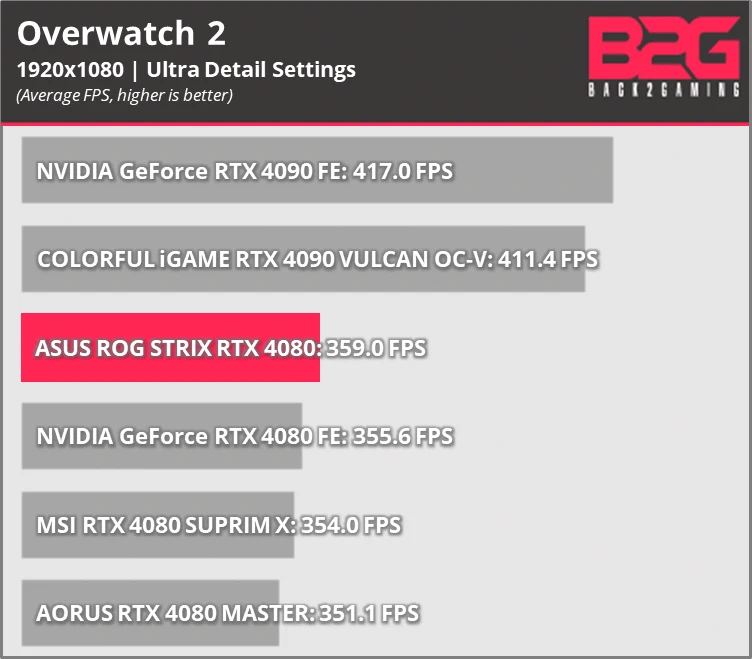
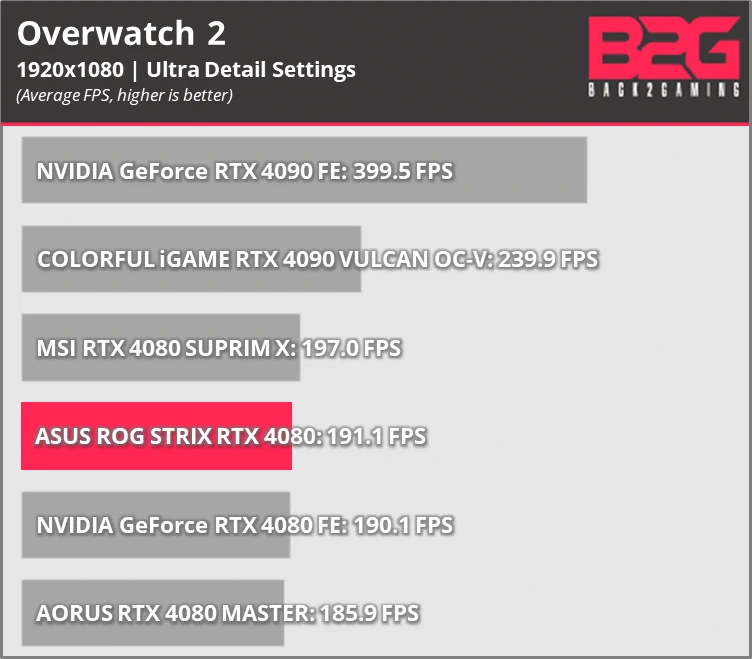
Valorant
Developed by League of Legends developer, Riot Games, Valorant is a first-person shooter featuring multiple heroes or agents which have unique skills to assist them within the games traditional team-based FPS combat. The game is gaining incredible success and has taken a large chunk of the now-incredibly massive CSGO playerbase as well, presenting a more refreshed take on classic TDM FPS but spices it up with skills, etc. Like CSGO and League, this game is light as a feather for the largest adoption possible. With 360hz monitors and input lag/system latency a major focus for these games, we’re now including it as reference for players.
API: DirectX 11
Grand Theft Auto V
The fifth and most successful installment to date in the highly controversial Grand Theft Auto series brings a graphical overhaul to the PC version of GTA V which many have lauded as a superior approach in porting a console game to PC. Featuring large areas and detailing, GTA V is a highly challenging application in terms of scene complexity.
Our benchmark uses a run from Palomina Highlands running through a lush area to a remote road all the way to a neighborhood in our car to simulate multiple scene changes.
API: DirectX 11
FXAA Off
MSAA 4x
TXAA Off
Very High settings
Anisotropic Filtering: 16x
Motion Blur disabled
Advanced Graphics enabled
Vsync OFF
Shadow of the Tomb Raider
Shadow of the Tomb Raider is the latest installment in the reboot run of the classic Tomb Raider franchise. The game follows the story set forth by the previous game which Shadow of the Tomb Raider short follows after. Technology-wise, the game uses the Foundation engine updated to meet the demand of developer Eidos Montreal to push the engine to its limits. The game supports DirectX 12 and is one of the launch titles to support RTX technology namely DLSS which launched a couple of months post-launch.
API: DirectX 12
Graphics Settings Preset: Highest
Texture Quality: Ultra
Texture Filtering: 8x Anisotropic
Anti-Aliasing: TAA
DLSS: OFF
Raytraced Shadow: OFF
Vsync OFF
Destiny 2
Destiny 2: New Light is an MMOFPS which sees a persistently sizable playerbase. The game features traditional MMO elements but played in an FPS approach which allows a more skill-dependent game versus traditional MMORPG formats. The game features a futuristic sci-fi universe with lush and detailed in-game locations that puts respectable workload on a gaming system.
API: DirectX 11
Settings: Highest
Vsync: OFF
Forza Horizon 5
Developed by Playground Games and published by Xbox Game Studios, Forza Horizon 5 is the latest installment in the Forza series, picking up straight after the British escapades of Horizon 4, Horizon 5 takes us now to Mexico for another open-world racing spectacle, that is Horizon. Built on proprietary ForzaTech engine, the game harnesses its power to provide an excellent experience on both PC and Xbox.
API: DirectX 12
Settings: High
Raytracing: Off
Vsync: Off
Elden Ring
Elden Ring is developed by Japanese studio From Software, known for the Soulsborne sub-genre of games as well as Armored Core from the older console days. Elden Ring cemented its name by releasing closely with Horizon Forbidden West and easily took the gaming world by storm thanks to its rich, in-depth lore and challenging gameplay. Elden Ring by default is frame capped. We’ve disabled this via driver settings.
API: DirectX 12
Maximum detail preset
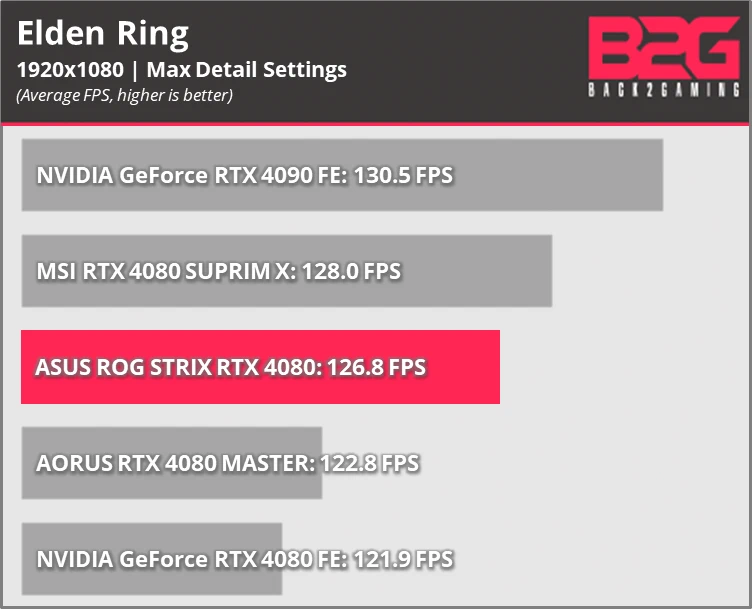
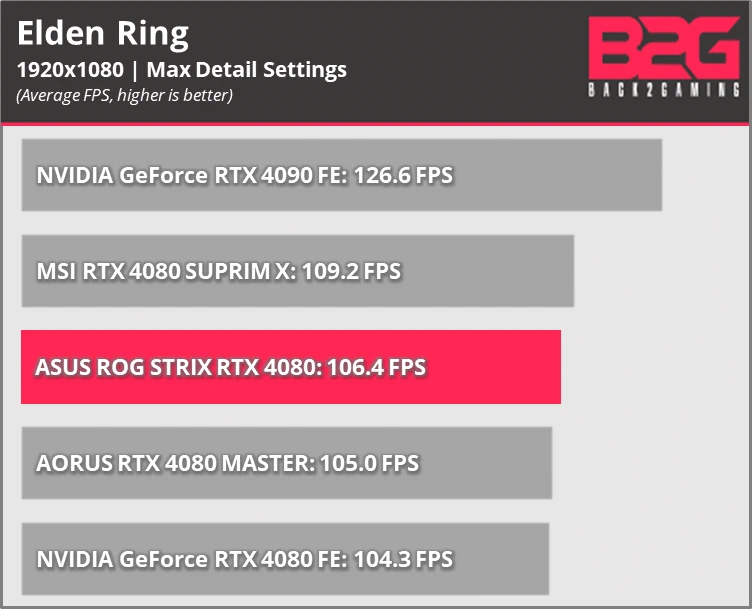
Cyberpunk 2077
The most anticipated game of 2020 has just received its sort of “launch patch” this 2022 with version 1.5 changing many things in terms of performance as well as few things in the graphics department. Perhaps the most anticipated game of the last decade, Cyberpunk 2077’s launch has been a rollercoaster gamers on PC are largely in agreement that it was definitely worth the wait bar the bugs. Made by CD Projekt Red and based on the REDengine4, Cyberpunk 2077 is one of the most modern games introducing full utilization of raytracing amongst others. We do not enable raytracing in this test segment, that will be for the latest section of this review..
API: DirectX 12
Settings: Ultra Preset
Raytracing Off
DLSS Off
Vsync: OFF
Marvel’s Spider-Man Remastered
Sony’s streak of PlayStation exclusives going to PC continues with Spider-Man. Originally releleased for PS4 in 2019, the game sees a PS5 upgrade and 2022 PC remastered release. The PC version of Spider-Man features a ton of modern PC graphical enhancements including all modern upscaling techniques along with ray tracing. The game natively supports ultrawide monitor resolution and is actively updated with with technologies from NVIDIA, AMD and Intel.
API: DirectX 12
Settings: Very High Preset
F1 2022
F1 22 updates the F1 title with the newer technical specifications set by FIA as well as the new Sprint race to serve as the sports’ video game counterpart used primarily for their F1 esports and also used by their racers for practice on occassion. F1 22 uses modern graphical techniques and takes advantage of raytracing as well as newer technologies to further improve visual realism.
API: DirectX 12
Settings: Ultra Preset
Microsoft Flight Simulator
Microsoft Flight Simulator (2020) is the much awaited release since Flight Simulator X from 2006. Harnessing the power of Microsoft Azure, Bing Maps and AI functionalities, Microsoft Flight Simulator brings the definition of realism to a new level with maps that are alive and real, rendered directly from their real-world counterpart and populated ingame with details. The game is constantly update to maintain real world relevance particularly for large events or other recent occurences.
API: DirectX 12
Settings: Ultra Preset
Ray Tracing Performance
In this page we see how our test cards perform when Ray Tracing is enabled in game. Games will have varying degrees of how they utilze raytracing. We enable everything to their highest setting although for Cyberpunk 2077, we did not go with Psycho setting and used Ultra. The numbers show the amount of reduction in FPS we with ray tracing enabled versus regular raster performance.
Cyberpunk 2077
Marvel’s Spider-Man Remastered
F1 2022
DLSS and Frame Generation
The results on this page takes the performance of raytracing and show how much performance uplift is gained from the non-DLSS ray traced numbers. Frame Generation numbers are highlighted as well.
Cyberpunk 2077
Marvel’s Spider-Man Remastered
F1 2022
Microsoft Flight Simulator
Conclusion
Final thoughts on the RTX 4080
The NVIDIA GeForce RTX 4080 marks a big change in the GPU landscape but one something we’ve already been anticipating since 2021. Today we’re taking a look at graphics cards from NVIDIA, ASUS ROG, GIGABYTE AORUS and MSI with more cards to follow.
The RTX 4090 made big waves when it launched and has nearly lapped every modern card in existence and those coming soon. NVIDIA also made sure there’s still space to grow, maybe as their final weapon like the RTX 3090 Ti but moving our perspective to the RTX 4080, things do look a bit different. While the RTX 4090 went all guns blazing, the RTX 4080 is positioned as a more conservative player when directly compared to its bigger brother but for the most part, performance is excellent and with 4K monitors becoming more and more accessible, the true advantage fo the RTX 4080 shines when used in 4K gaming.
Only Cyberpunk at 4K with ray tracing enabled pushed the RTX 4080 to its knees at only Ultra mode but thankfully Cyberpunk 2077 is one of the technology partners for NVIDIA that promises Frame Generation: a key feature of DLSS3. WIth DLSS33, Frame Generation in-use along with ray tracing and Reflex, we get to see what NVIDIA refers to as the full-stack innovation for Ada Lovelace. For esports gamers looking to just max-out their FPS, you’d be very CPU restricted even with the latest flagship CPUs from both Intel and NVIDIA especially on low settings so if you’re planning to go for those upcoming 1080p 500Hz monitors, a framecap may be in order or I would recommend the potential xx70 entries in the RTX 40 line-up.
Final thoughts on the ASUS ROG STRIX RTX 4080 OC
The ASUS ROG STRIX RTX 4080 continues ASUS’ line of GPUs aimed at brand loyalists and ASUS knows their customer base are rockstars and have the money for their products hence why the western pricing for the ROG STRIX RTX 4080 OC is set at $1550. With the ROG Strix RTX 4090 being priced at a handsome Php133,000 or $2300~, the Philippine pricing for the ROG Strix RTX 4080 is $1813. Putting that in context against the rest of the market, the AORUS RTX 4080 MASTER is around PHP99,000~, roughly $1728~. In terms of brand equity, the Asian market revels in ASUS ROG, especially with EVGA’s limited presence and their decision to withdraw from the GPU market, ASUS now has the extreme market in the palm of their hands. Take that how you will, but the given NVIDIA’s already steep pricing, I wouldn’t blame ASUS for passing the bill for the chonk cooler onto the users.
Forgetting price for a while, the ASUS ROG STRIX RTX 4080 OC is easily the second most efficient card we’ve tested only bested by a hair by NVIDIA’s RTX 4080 FE. Both cards brandish a cooler made for beefier cards but that does bring with it some benefits, most importantly cooling. The ROG STRIX RTX 4080’s larger cooler and powerful fans are a mean combo and cools the ROG STRIX RTX 4080 very well. ASUS’s Axial-tech fans are whisper quiet even on load but talking about audible for a minute, there is a slight concern about coil whine. This is the first time I’ve tested a review unit with coil whine and this is a retail sample not a cherry picked one. It might just be a lemon, and doesn’t affect performance overall but it is an audible electrical hum rather than the high-pitched whine we’ve all come to hate.
Regardless, ASUS has done a fairly good job designing a cooler and while the merits of this cooler may just be second hand as it belongs to a larger card, its definitely ballsy of all these companies to reuse their larger coolers on cards that could make do without. That said, there is still that ROG tax but given the pricing structure of the rest of the market, one could look it more positively. And by positives, you get an extremely efficient and extremely well-cooled graphics card that’s easily at a contentious price point. Despite folks giving creds to AMD already without a card released yet, NVIDIA and by extension ASUS, was able to sell the ROG STRIX RTX 30-series card at extortionate prices in 2021 despite AMD selling much lower. That shows a lot of the brand power of ROG but now that the shiny new toy is out, those who may have wanted the ROG RTX 30 cards are now wanting the RTX 40 series cards, and with the RTX 4090 perhaps a little bit up in the clouds, the ROG STRIX RTX 4080 OC Edition is a more accessible entrance to the ROG club.




